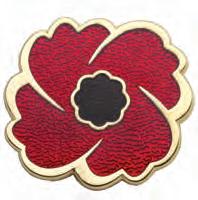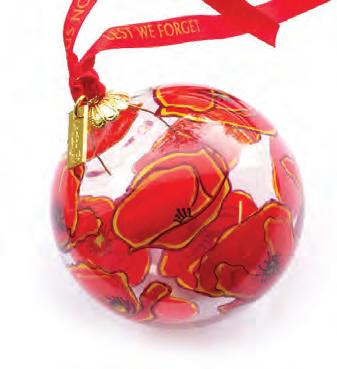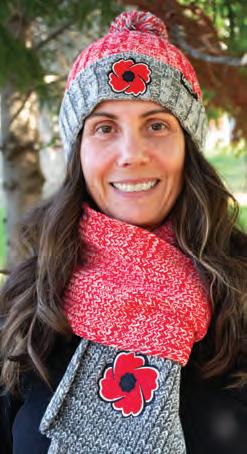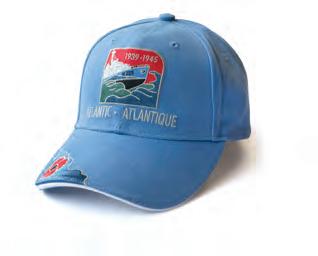

How a Safe Step Walk-In Tub can change your life
Remember when…
Think about the things you loved to do that are dif cult today — going for a walk or just sitting comfortably while reading a book. And remember the last time you got a great night’s sleep?
As we get older, health issues or even everyday aches, pains and stress can prevent us from enjoying life.
So what’s keeping you from having a better quality of life?
Check all the conditions that apply to you.
Personal Checklist: Arthritis
Insomnia
Diabetes Mobility Issues
Lower Back Poor
Then read on to learn how a Safe Step Walk-In Tub can help. Feel better, sleep better, live better
A Safe Step Walk-In Tub lets you indulge in a warm, relaxing bath that can help relieve life’s aches, pains and worries.
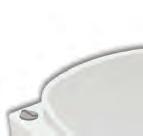
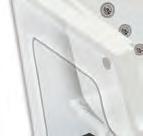





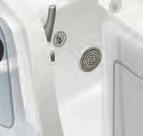


A Safe Step Tub can help increase mobility, boost energy and improve sleep.

It’s got everything you should look for in a walk-in tub:
• Heated Seat – Providing soothing warmth from start to nish.
• MicroSoothe® Air Therapy System – helps oxygenate and soften skin while offering therapeutic bene ts.
• Pain-relieving therapy – Hydro massage jets target sore muscles and joints.
• Safety features – Low step-in, grab bars and more can help you bathe safely and maintain your independence.
• Free Shower Package – shower while seated or standing.








Merrifield
Features
20 OVERLOOKED
A trio of courageous acts of war left unrecognized
By Stephen J. Thorne
30 THE CANADIAN SAMURAI
Great War Sergeant Masumi Mitsui never stopped fighting for right
By Russ Crawford
34 PROFESSOR HEALY AND THE PARTISANS
Canadian Captain Dennis Healy, a peacetime university prof, played a pivotal role alongside locals in the liberation of the Italian city of Ravenna
By Mark Zuehlke
40 HELP WANTED?
Exploring the trials and tribulations of Canadian liberators in Europe
By J.L. Granatstein
46 BOMBS AWAY
The wild story of Japanese balloon bombs floated over North America
By Alex Bowers
52 FIRST CALL
The Royal Air Force’s all-Canadian 242 Squadron finally gets into action. An exclusive excerpt from Battle of Britain: Canadian Airmen in Their Finest Hour
By Ted Barris
58 KING OF NECESSARY
Looking back on Prime Minister Mackenzie King as Canada’s wartime leader
By J.L. Granatstein
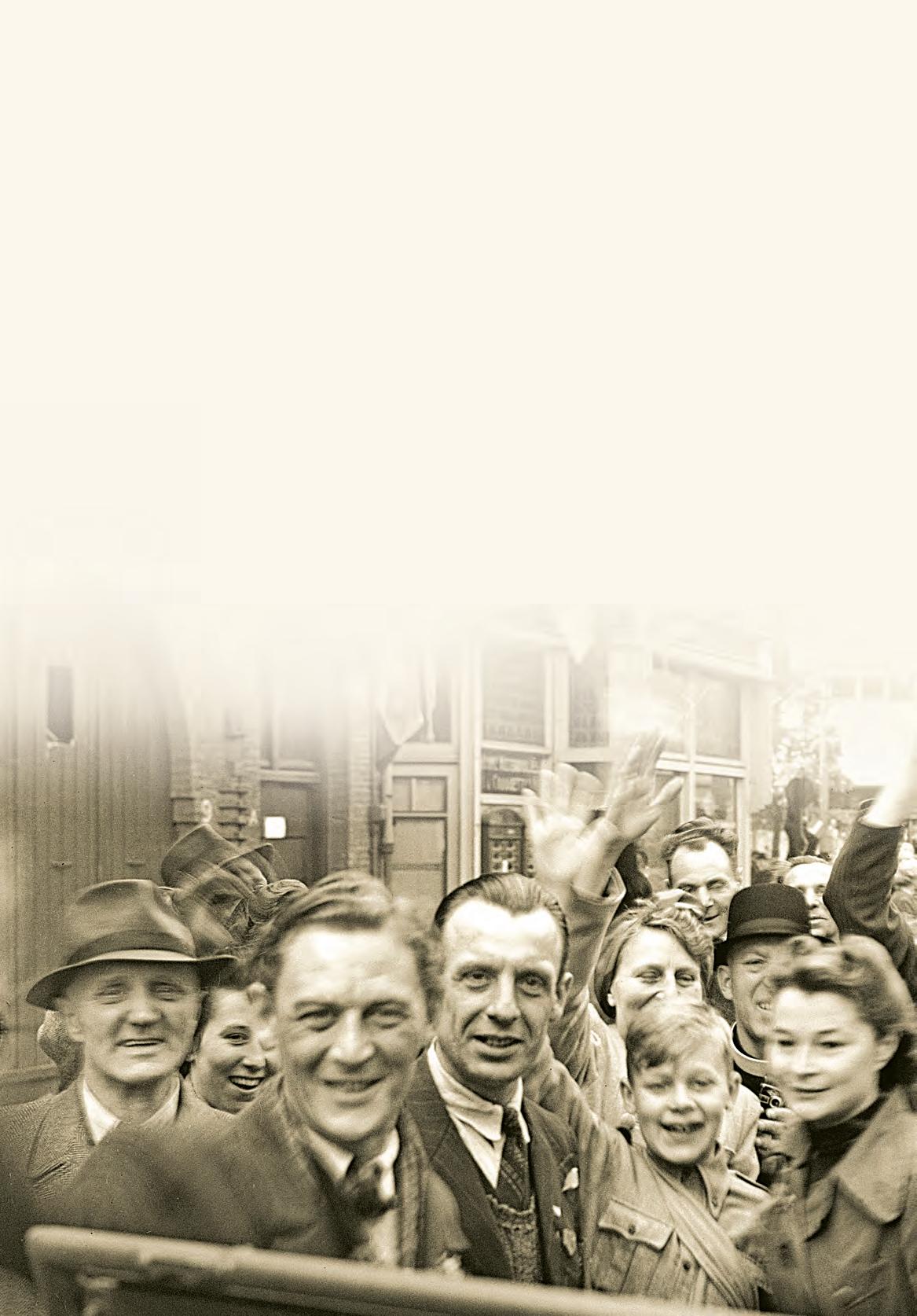

64 MOVING TOWARD
From technological innovation to membership growth and beyond, The Royal Canadian Legion shows no sign of slowing down as it approaches its centennial By
Aaron Kylie
72 WAR AND PLAY
A Canadian charity works to build playgrounds in wartorn areas around the world
Words by Leslie Anthony
THIS PAGE
Locals welcome their liberators in Utrecht, Netherlands, on May 7, 1945. J. Ernest DeGuire/DND/LAC/PA-171747
ON THE COVER
Members of 242 (Canadian) Squadron, Royal Air Force, in 1940. Imperial War Museums/CH1413/Wikimedia
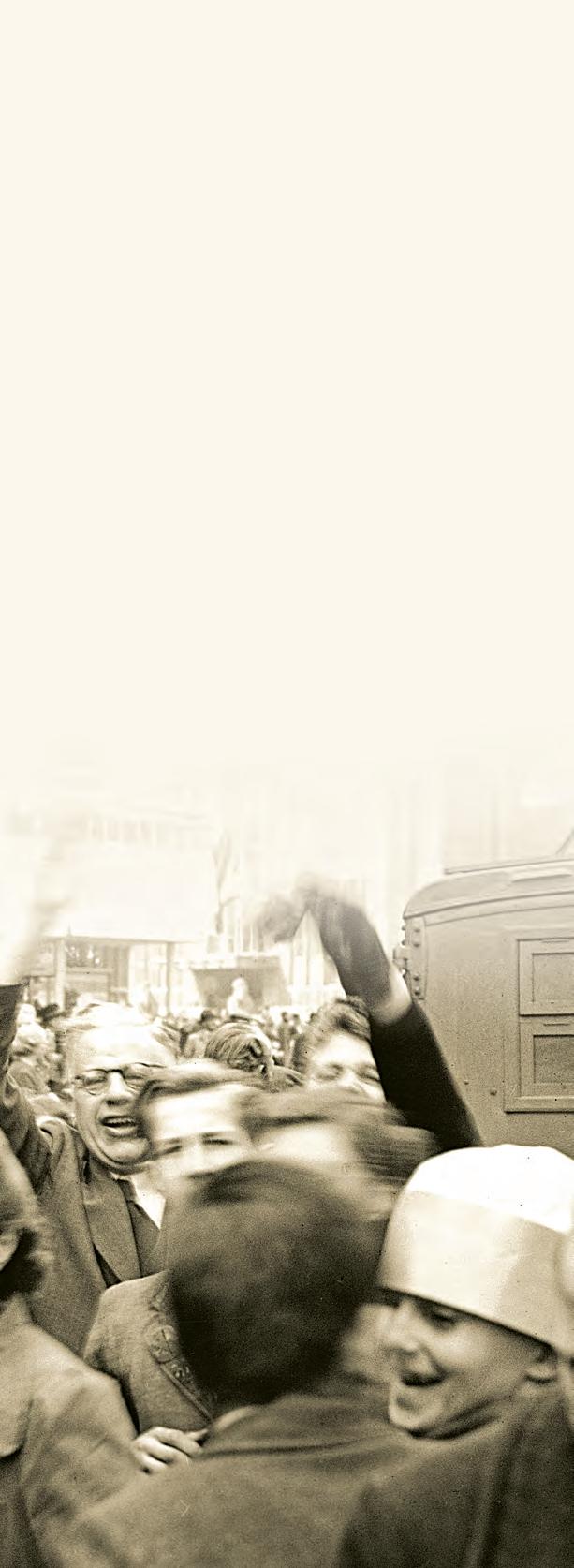
78 FACE TO FACE
After early Canadian-led attempts to advance across the Netherland’s Walcheren causeway were unsuccessful, should the move have been abandoned?
John Boileau and Stephen J. Thorne
Mars attacks!

2025 WALL CALENDAR
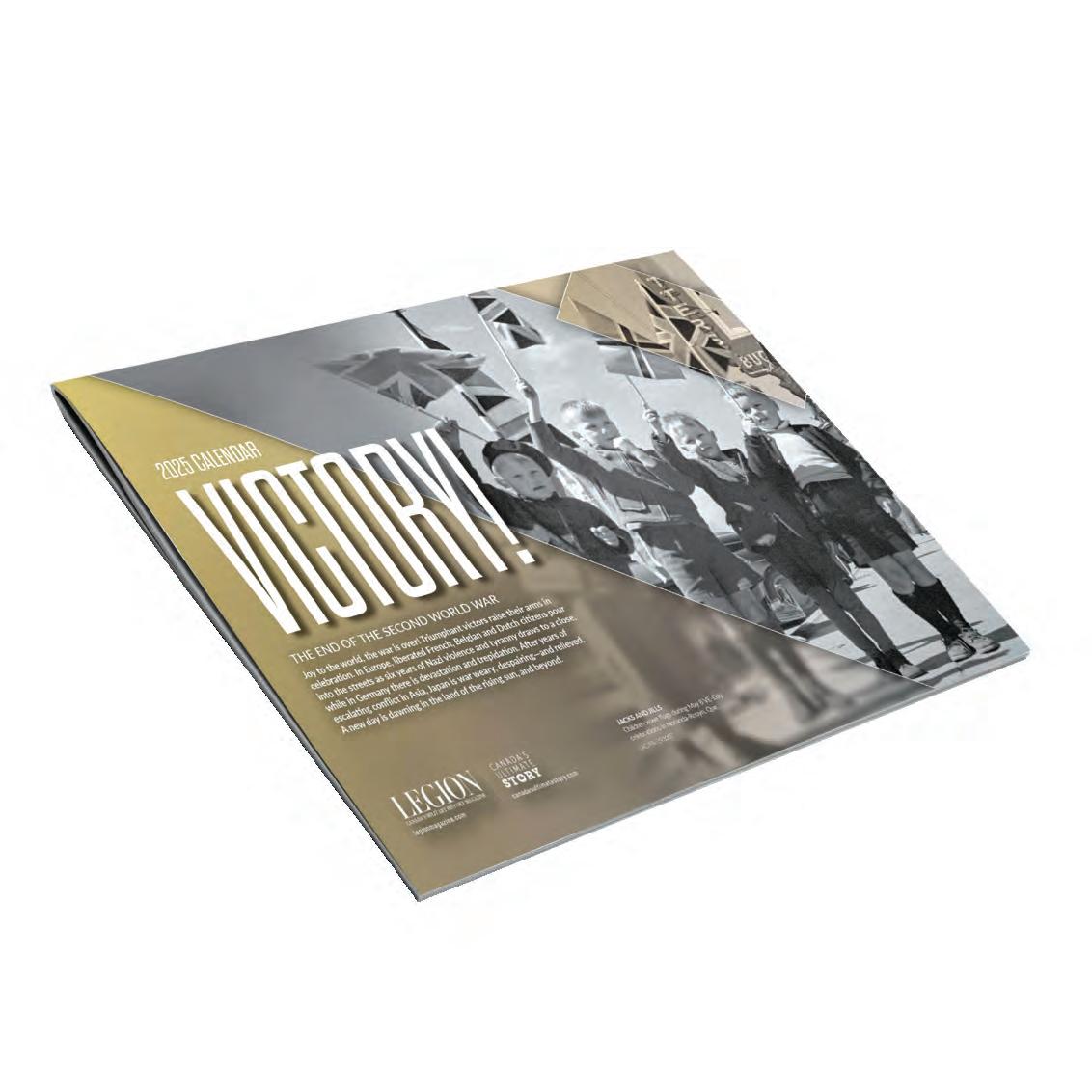
Board of Directors BOARD
ADMINISTRATIVE
SUPERVISOR
Stephanie Gorin
SALES/
ADMINISTRATIVE ASSISTANT
Lisa McCoy
ADMINISTRATIVE ASSISTANT
Chantal Horan
EDITOR
Aaron Kylie
ASSISTANT EDITOR
Michael A. Smith
SENIOR STAFF WRITER
Stephen J. Thorne
STAFF WRITER
ART DIRECTOR, CIRCULATION AND PRODUCTION MANAGER
Jennifer McGill
SENIOR DESIGNER AND PRODUCTION CO-ORDINATOR
Derryn Allebone
SENIOR DESIGNER



Alex Bowers


|
Sophie Jalbert
DESIGNER
Serena Masonde SENIOR

| advertising@legionmagazine.com MARLENE MIGNARDI 416-843-1961 | marlenemignardi@gmail.com OR CALL 613-591-0116 FOR MORE INFORMATION
AND MARKETING CO-ORDINATOR Dyann Bernard WEB DESIGNER AND SOCIAL MEDIA CO-ORDINATOR
Ankush Katoch

Published six times per year, January/February, March/April, May/June, July/August, September/October and November/December. Copyright Canvet Publications Ltd. 2024. ISSN 1209-4331
Subscription Rates
Legion Magazine is $9.96 per year ($19.93 for two years and $29.89 for three years); prices include GST. FOR ADDRESSES IN NS, NB, NL, PE a subscription is $10.91 for one year ($21.83 for two years and $32.74 for three years). FOR ADDRESSES IN ON a subscription is $10.72 for one year ($21.45 for two years and $32.17 for three years).
TO PURCHASE A MAGAZINE SUBSCRIPTION visit www.legionmagazine.com or contact Legion Magazine Subscription Dept., 86 Aird Place, Kanata, ON K2L 0A1 or phone 613-591-0116. The single copy price is $7.95 plus applicable taxes, shipping and handling.
Change of Address
Send new address and current address label, or, send new address and old address. Send to: Legion Magazine Subscription Department, 86 Aird Place, Kanata, ON K2L 0A1. Or visit www.legionmagazine.com/change-of-address. Allow eight weeks.
Editorial and Advertising Policy
Opinions expressed are those of the writers. Unless otherwise explicitly stated, articles do not imply endorsement of any product or service. The advertisement of any product or service does not indicate approval by the publisher unless so stated. Reproduction or recreation, in whole or in part, in any form or media, is strictly forbidden and is a violation of copyright. Reprint only with written permission.
PUBLICATIONS MAIL AGREEMENT NO. 40063864
Return undeliverable Canadian addresses to Legion Magazine Subscription Department 86 Aird Place, Kanata, ON K2L 0A1 | magazine@legion.ca
U.S. Postmasters’ Information
United States: Legion Magazine, USPS 000-117, ISSN 1209-4331, published six times per year (January/February, March/April, May/June, July/August, September/October, November/December). Published by Canvet Publications, 866 Humboldt Pkwy., Buffalo, NY 14211-1218. Periodicals postage paid at Buffalo, NY. The annual subscription rate is $9.49 Cdn. The single copy price is $7.95 Cdn. plus shipping and handling. Circulation records are maintained at Adrienne and Associates, 866 Humboldt Pkwy., Buffalo, NY 14211-1218. U.S. Postmasters send covers only and address changes to Legion Magazine, PO Box 55, Niagara Falls, NY 14304.
Member of Alliance for Audited Media and BPA Worldwide. Printed in Canada.
We acknowledge the financial support of the Government of Canada. Version française disponible.
On occasion, we make our direct subscriber list available to carefully screened companies whose product or services we feel would be of interest to our subscribers. If you would rather not receive such offers, please state this request, along with your full name and address, and e-mail magazine@legion.ca or write to Legion Magazine, 86 Aird Place, Kanata ON K2L 0A1 or phone 613-591-0116.



Give ’em
shelter
The Royal Canadian Legion is experiencing a post-COVID membership bounce, and it couldn’t have come at a more opportune time.
Innovative marketing and easier sign-ups combined to boost RCL membership to 256,524 in 2023, a 5.3 per cent increase over 2022, when total paid membership was already up 3.8 per cent from the year previous. They are the first membership increases in decades.
“ VETERANS ARE TWO TO THREE TIMES MORE LIKELY TO EXPERIENCE HOMELESSNESS COMPARED TO THE GENERAL POPULATION.”
While Legion numbers are on the rise so, it appears, are the number of homeless veterans.
In his report to the RCL’s national convention, Dave Gordon, adviser to the Legion’s Veterans, Service and Seniors Committee, suggested demand for services to homeless veterans is greater than ever. This despite— or perhaps because of—increased awareness of and efforts to document and address the homeless veterans issue in Canada.
Drawing on data from the Leave the Streets Behind Homeless Program and reports from the RCL’s provincially based resources, Gordon said the total number of homeless veterans identified and assisted rose to 1,234 in 2023.
In their 2023 paper “Addressing veteran homelessness in Canada” for the Max Bell School of Public Policy at Montreal’s McGill University, however, Anmol Gupta, Alison Clement, Sandrine Desforges and Taylor Chase put the issue in perspective.
“Veterans are two to three times more likely to experience homelessness compared
to the general population and are disproportionately represented among individuals experiencing homelessness,” they write, noting that estimates of the number of unhoused veterans in Canada varies widely from 2,400 to more than 10,000. While veterans’ homelessness “is not unique to Canada,” they add, “countries like the U.S. have made significantly more progress in reducing the number of veterans experiencing homelessness.”
In 2023, Ottawa announced a $79.1-million veteran homelessness program, establishing two funding streams to support civil society and sub-national governments to provide rent supplements, deliver social services and improve research.
But more action is needed, say the authors.
“With fragmented and siloed programs across the country, poor understanding of the scale of the issue, and the incredibly diverse nature of the causes and experiences of veteran homelessness, it is not clear that more money—without clear federal leadership and co-ordination— will bring about meaningful change.”
With the growing housing crisis, they warn, “more veterans will disproportionately fall into homelessness should the federal government not take a more proactive and human rights-based approach to this issue.”
The paper cites a lack of federal departmental leadership on the issue and blames the discrepancies in numbers on the unique nature of veterans’ homelessness: the preponderance of ‘hidden homelessness,’ such as couch-surfing or living in vehicles, and the fact many veterans tend not to interact with shelters and food banks, which comprise the most common data-collection sites.
The RCL is uniquely positioned to overcome these obstacles. Fundamental tenets of its existence are its role in advocating and assisting veterans. Its national programs rely on the efforts and intelligence provided by grassroots members.
Among the more encouraging elements of the recent membership rise is the fact that the new recruits are coming from younger demographics—21 per cent are 45 or younger and 30 per cent are 50 or younger. Their energy and ideas will be invaluable to the efforts to better serve Canada’s veterans. L
ATTENTION CANADIAN MILITARY FAMILIES
Did you or a family member receive VAC disability benefits between 2003 and 2023?
A class action settlement may affect you. Please read this notice carefully.
On 17 January 2024 the Federal Court approved a settlement in a class action involving alleged underpayment of certain disability pension benefits administered by Veterans Affairs Canada (“VAC”) payable to members or former members of the Canadian Armed Forces (“CAF”) and the Royal Canadian Mounted Police (“RCMP”) and their spouses, commonlaw partners, survivors, other related individuals, and estates (the “Settlement”).
If you received any of the disability-related benefits listed below at any time between 2003 and 2023, you may be entitled to compensation under the Settlement. As the executor, estate trustee, administrator, or family member of a deceased class member who collected VAC-administered disability benefits, you may also be able to claim on behalf of the estate. If you are entitled to compensation under the Settlement and you have an active payment arrangement with VAC, such as direct deposit, you do not need to do anything to receive payment. If you are claiming on behalf of a deceased veteran of the CAF or RCMP, including as the executor, trustee, administrator of an estate, or a family member, you must submit a Claim Form to KPMG Inc., the administrator responsible for handling claims available at: KPMG Inc.
C/O Disability Pension Class Action Claims Administrator 600 boul. de Maisonneuve West, Suite 1500 Montréal, Québec H3A 0A3 Online: https://veteranspensionsettlement.kpmg.ca/ E-mail: veteranspension@kpmg.ca
For assistance with submitting a Claim Form, please contact the Administrator’s dedicated call center at 1-833-839-0648, available Monday to Friday, 8:00 AM to 8:00 PM (Eastern Time).
The deadline to submit a claim is 19 March 2025. All eligible claimants are entitled to receive legal assistance free of charge from Class Counsel for purposes relating to implementing the Settlement, including preparing and/or submitting a claim to the Administrator.
You may contact Class Counsel for more information or for assistance with filing a claim, at info@vetspensionerror.ca, or 1-866-545-9920. To see the full text of the Final Settlement Agreement, please visit https://vetspensionerror.ca/court-documents/. WHO IS INCLUDED?
The Settlement covers members and former members of the CAF and the RCMP and their spouses, common–law partners, dependents, survivors, orphans, and any other individuals, including eligible estates of all such persons, who received—at any time between 2003 and 2023—disability benefits based on annual adjustments of the basic pension under s. 75 of the Pension Act (the “Class Members”). The terms of the Settlement are binding on Class Members. The Settlement includes releases of claims asserted in the certified Class Action.
WHAT ARE THE AFFECTED BENEFITS?
The Settlement affects prescribed annual adjustments of the following benefits:
• Pension Act pensions for disability, death, attendance allowance, allowance for wear and tear of clothing or for specially made apparel and/or exceptional incapacity allowance;
• RCMP Disability Benefits awarded in accordance with the Pension Act;
• Civilian War-related Benefits Act war pensions and allowances for salt water fishers, overseas headquarters staff,
air raid precautions works, and injury for remedial treatment of various persons and voluntary aid detachment (World War II);
• Flying Accidents Compensation Regulations flying accidents compensation;
• Veterans Well-being Act clothing allowance.
WHAT DOES THE SETTLEMENT PROVIDE?
The Settlement provides direct compensation to Class Members who receive (or have previously received) any of the Affected Benefits listed above, since 1 January 2003. Class Members will receive a single payment of about 2% of all Affected Benefits they have received since 1 January 2003. The total amount of compensation paid by Canada to the Class could be as much as $817,300,000. This is only a summary of the benefits available under the Settlement. The full text of
the Final Settlement Agreement (“FSA”) is available online at https://vetspensionerror.ca/ court-documents/. You should review the entire FSA in order to determine your entitlement and any steps you may need to take to access compensation.
HOW AM I PAID?
Eligible Class Members who are currently collecting VAC-administered disability benefits or pensions will receive a Settlement payment automatically through the same payment method they currently use to collect benefits, including by direct deposit.
Class Members who received Affected Benefits between 2003 and 2023 but who do not have a current payment arrangement with VAC will be required to make a claim with the Claims Administrator. This includes all Class Members who are deceased, and where an executor, estate trustee, administrator of an estate, or a family member is making a claim on behalf of that Class Member.
However, if a deceased Class Member has a survivor who is in receipt of VAC benefits and has a current payment arrangement, that survivor will automatically receive the deceased Class Member’s entitlement without the need to make a claim with the Claims Administrator.
HOW DO I MAKE A CLAIM?
If you do not have an active payment arrangement with VAC, you must submit a claim form with the Administrator.
You must submit a completed and signed Claim Form to the Administrator within the Claim Period. You are encouraged to use the Claim Form submission link available online at https://veteranspensionsettlement.kpmg.ca/. You may, however, submit your Claim Form to the Administrator using one of the following three methods: 1. online at https://veteranspensionsettlement.kpmg.ca; 2. by e-mail to veteranspension@kpmg.ca; or 3. by mail to: KPMG Inc.
C/O Disability Pension Class Action Claims Administrator 600 boul. de Maisonneuve West, Suite 1500 Montréal, Québec H3A 0A3
You may download a copy of the Claim Form available online at: https://veteranspensionsettlement.kpmg.ca/download/Claim-Form.pdf.
If submitting electronically, the Administrator must receive your completed and signed Claim Form no later than 19 March 2025. If submitting by mail, your completed and signed Claim Form must be postmarked no later than 19 March 2025. For assistance with submitting a Claim Form, please contact the Administrator’s dedicated call center at 1-833-839-0648, available Monday to Friday, 8:00 AM to 8:00 PM (Eastern Time).
Please read and follow the instructions on the Claim Form. Class Counsel are also available, free of charge, to answer your questions and assist you with preparing your claim form.
The deadline to file a claim is 19 March 2025.
AM I RESPONSIBLE FOR LEGAL FEES?
You are not responsible for payment of legal fees. The Federal Court has approved Class Counsel’s fees (including HST) and disbursements to be automatically calculated and deducted from the Settlement amount you are entitled to receive before the payment is issued.
The Federal Court approved payments to Class Counsel equal to approximately 17% of each payment made under the Settlement for legal fees, disbursements, and HST.
The FSA contains additional details about Class Counsel fees, available online at https://vetspensionerror.ca/court-documents/.
Class Counsel are available to assist Class Members through the claims process free of charge.
FURTHER INFORMATION?
For further information or to get help with your claim, contact Class Counsel at: https://vetspensionerror.ca/ or Call: 1-866-545-9920 or info@vetspensionerror.ca
DO YOU KNOW ANY OTHER RECIPIENTS OF A VAC DISABILITY PENSION?
Please share this information with them.
I say it because I love you I
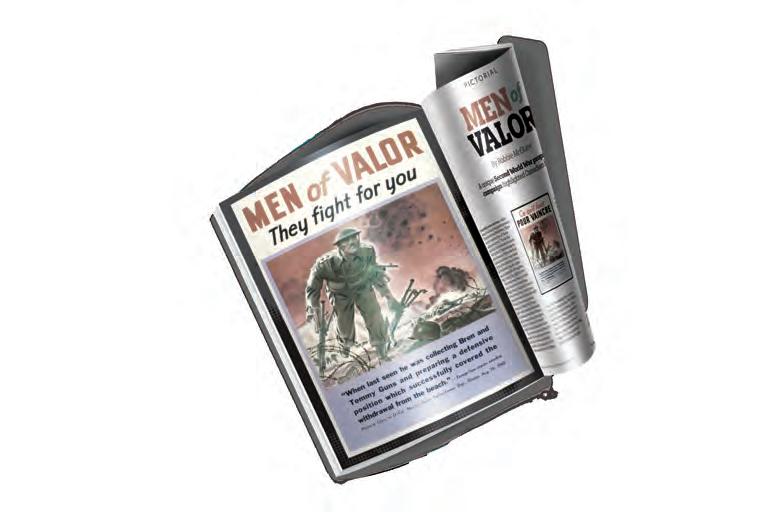
me in touch with my dad, who served for 20 years in the Royal Canadian Navy, including the Second World War and Korea. I think that he, like me, would have been startled to see the misspelling of the word “valour” on the cover of the latest issue (September/October). We prefer the inclusion of the “u,” as it is spelled on the Victoria Cross.
JEANIE DUBBERLEY WINNIPEG
can
sent to: Letters, Legion Magazine , 86 Aird Place, Kanata, ON K2L 0A1 or emailed to: magazine@legion.ca
we’re glad to hear you appreciate our work. We deliberately dropped the “u” from valour in this case as “Men of Valor”— valor with no “u”—is the proper name of the poster series (see image above) the story the cover line was referring to is about. Of course, as you undoubtedly know, we otherwise always spell valour with a “u.”

Rock history
I was born in Newfoundland but have lived or worked in almost every province and territory in Canada and, hence, I am a proud Canadian. As such, it never ceases to amaze me how it is that so many Canadian historians exclude Newfoundland from their thinking when they write on matters pertaining to “Canadians.” Admittedly, we Newfoundlanders were late coming to the party, but when we did, I would have thought that our history became Canada’s history. Apparently not, so far as some historians are concerned.
Case in point, the article “Sisters Act” by Alex Bowers (September/October).
Newfoundland was a Dominion during WW I, and hence an equivalent to Canada when it came to

its war efforts, albeit on a much smaller scale. Newfoundland women (including one of my greataunts—Emily Frances Victoria Morry—went overseas as qualified nursing sisters, and many more younger women served as VADs (members of the Volunteer Aid Detachment). Yet, not one word was dedicated to the recognition of these services in this article about Canadian nurses. The author mentions Canadian nurses in Gallipoli, but fails to mention that many of those receiving their ministrations were members of the Newfoundland Regiment, the only North American regiment that served on the battlefields in that campaign. My grandfather, Howard Leopold Morry, was among them. I get it. We weren’t Canadians then. But we are now, and once


Donate Volunteer Register
again, our history is a part of Canadian history and deserves to be treated as such.
Somewhat ironically, in the same edition of Legion Magazine there is a fine article by Michael A. Smith, “The B’ys back,” reporting on the repatriation of Newfoundland’s Unknown Soldier this past July 1. Two entirely different perspectives on Newfoundland’s role in Canadian history.
CHRISTOPHER MORRY ROCKLAND, ONT.
Who’s the villain?
In your latest issue (September/ October), the Heroes and Villains section has James Wolfe opposing Louis-Joseph de Montcalm. It seems to suggest that Wolfe was the hero and Montcalm the villain. Let’s not forget that Wolfe was the one to attack after starving the local population. He did not liberate anyone, instead the British forces oppressed the francophones of New France/Lower Canada/ Quebec in subsequent years. Many historians have since been uncovering Wolfe’s war crimes in Scotland, Gaspé and Quebec. Reading Wolfe’s biography would easily put him in the “villains’’ category. Montcalm’s biography does not report any such account, making him much more a hero.
The Battle of the Plains of Abraham was but one battle in this war covering the known world. Everything was decided at the Treaty of Paris (1763), where territories were ceded, exchanged and swapped not unlike kids trading hockey cards.
You did err in portraying Montcalm as the villain in this instance. History has shown us that winners of a battle are not always heroes.
CLAUDE VADEBONCOEUR SUTTON, QUE.
Exclusive HIGHLIGHT from LegionMagazine.com
It’s no surprise that Legion Magazine readers love history. In particular, the magazine’s On this Date department (see page 12)—which includes select highlight dates for each month—garners a lot of passionate feedback. From omitted events—we can’t include them all!—to additional info—we keep them short to include more of them!—readers regularly let us know what they wanted to see there but didn’t. However, this-day-in-history buffs who aren’t already reading the Military Milestones blog on LegionMagazine.com, will surely want to, as it includes more of
the type of content featured in On this Date. Each week, staff writer Alex Bowers digs into an historically timely Canadian war story, providing detail, context and compelling content. As this issue went to press, for instance, Bowers had recently covered a range of topics from the Canadian military connection to Winnie the Pooh to the 1812 Siege of Detroit, from HMCS Oakville’s daring Second World War attack on U-94 to a Canadian Spanish Civil war veteran, and the life of war chronicler C.P. Stacey to Operation Market Garden. In addition to regular fresh missives from Bowers, Legion Magazine’s
Get notified of all the latest updates on legionmagazine.com by signing up for our weekly e-newsletter at www.legionmagazine.com /newsletter-signup
website has an archive of hundreds of Military Milestones blog entries, hours upon hours of content to satiate even the most ardent of history hounds. Visit www.legionmagazine.com/ category/canadian-military-historyin-perspective/military-milestones/ to explore both the latest and the compendium of collected items. You can also search the thousands of stories on the site. Better still, if you haven’t already, sign up for Legion Magazine’s weekly e-newsletter to keep apprised of the latest blogs, updates and more at LegionMagazine.com. L








November

1 November 1914
Four recent graduates of the Royal Naval College of Canada are among those lost when Germany’s Asiatic Squadron sinks HMS Good Hope. They are Canada’s first naval casualties of WW I.
2-3 November 1951
The Royal Canadian Regiment repels a Chinese attack on Hill 187 in Korea.
4 November 1914
Nurse Margaret Macdonald is appointed matron-in-chief of the Canadian Army Medical Corps. She is the first woman in the British Empire to reach the rank of major.
5 November 1914
Britain and France declare war on the Ottoman Empire.
7 November 1900
Three Canadians are awarded Victoria Crosses for actions during the Battle of Leliefontein in the Boer War.

6 November 1917
Canada and Britain launch an assault on the village of Passchendaele, which is captured by the 27th Battalion late that day.

18 November 1916
Canadian battalions capture Desire Trench on the Somme.
21 November 1916
The largest ship lost in the First World War, sister ship to RMS Titanic, the hospital ship Britannic strikes a naval mine near Greece, sinking within 55 minutes. Thirty die.
11 November 1920
The Cenotaph, the United Kingdom’s official national war memorial, is unveiled. Two unknown soldiers are interred simultaneously in Westminster Abbey and at the Arc de Triomphe in Paris.
12 November 1981
Space shuttle Columbia launches, carrying the Canadarm.
13 November 1775
Montreal falls to the American Patriot’s Continental Army, led by General Richard Montgomery.

16 November 1857
Under heavy fire, surrounded by dead crewmates, William Hall and his commander use a ship’s gun to free trapped British soldiers near Lucknow, India. Hall is awarded the Victoria Cross.

23 November 2009
During a mortar attack in Afghanistan, Pte. Tony Harris and Pte. Philip Millar run to administer first aid while under fire. Each is awarded the Medal of Military Valour.
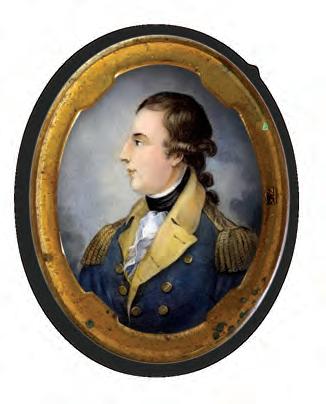
24 November 1904
Ross Tilley is born. During the Second World War, Tilley would help redefine plastic surgery while caring for burned and wounded Allied airmen, who called themselves the Guinea Pig Club.
25 November 1953
HMCS Cayuga sails for duty near Korea for the third and final time.
26 November 1940
17 November 1997
Egyptian militants kill more than 60 and injure nearly 100 tourists at an ancient temple in Luxor.
The Toronto Scottish Regiment shoots down a German aircraft in Portslade, England.
28 November 1934
Ten new Atlas aircraft are taken on strength by Canada’s air force.


December
1 December 1959
Twelve countries sign the Antarctic Treaty, declaring the continent a scientific preserve and banning military activity.
2 December 1942
The first controlled self-sustaining nuclear chain reaction is triggered at the University of Chicago, ushering in the atomic age.
3 December 1943
The 1st Special Service Force, the U.S.Canadian commando unit known as the Devil’s Brigade, work to clear German positions on Monte la Difensa, Italy.
4 December 1950
HMCS Cayuga leads six ships on a dangerous night passage to support the evacuation of the port of Pyongyang in North Korea.
6 December 1912
Prime Minister Robert Borden proposes $35 million to help Britain rearm, but the bill is ultimately defeated in the Senate.
10 December 1943
1st Canadian Infantry Division continues its assault across Italy’s Moro River as the first step in a drive on the town of Ortona.
11 December 1941
16 December 1944
Germany launches the Battle of the Bulge, its final major offensive on the Western Front.
17 December 1939
In Ottawa, Canada, the U.K., Australia and New Zealand sign the British Commonwealth Air Training Plan agreement.
18 December 1950
Canada’s first fighting unit— 2nd Battalion, Princess Patricia’s Canadian Light Infantry—reaches Korea.
19 December 1813

The British are victorious in a night assault aimed at capturing Fort Niagara in New York.
21 December 1943
2nd Canadian Infantry Brigade, supported by Three Rivers Regiment tanks, enters the town of Ortona, Italy.
23 December 1956
British and French forces leave the Suez Canal after the UN and U.S. force an end to the armed occupation of the region.

Germany and Italy declare war on the United States.
14 December 1915
Arthur Ince is the first Canadian credited with downing an enemy aircraft, shooting a German seaplane near Ostend, Belgium.
15 December 1916
Canadian Aeroplanes Ltd. is incorporated to provide training aircraft for the Royal Flying Corps.
24 December 1944
Minesweeper HMCS Clayoquot is torpedoed by U-806 off Halifax. Eight die while 76 survive.
25 December 1941 Hong Kong surrenders.
27 December 1972
Lester B. Pearson, prime minister from 1963 to 1968 and Nobel Peace Prize recipient, dies.
30 December 1941
Churchill delivers his historic “some chicken, some neck” speech in Ottawa, which helped to galvanize wartime resolve.
31 December 1943
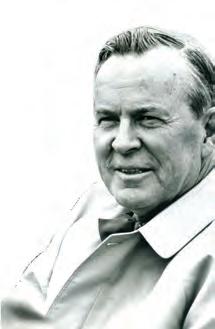
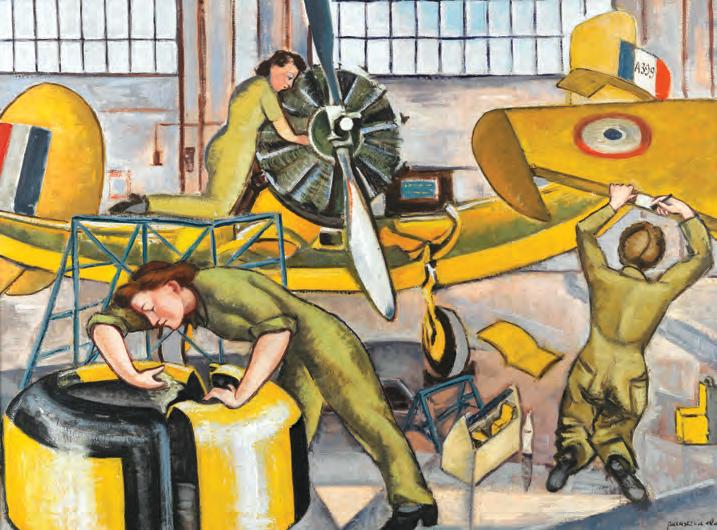
The Royal Canadian Air Force is at its peak with 215,000 people, including 15,000 members of the Women’s Division.
By Alex Bowers
Finding their voices
How a travelling exhibit and writing workshop have enabled veterans and military families to chronicle their experiences
Can you see my Timex watch?” asked Afghanistan War veteran and Canadian Army Corporal Andrew Mullett, “My watch means a lot to me.”
Having once struggled to sleep during his tour of duty, the Princess Patricia’s Canadian Light Infantry (PPCLI) soldier recalled placing the timepiece beside his ear and listening to it tick.
The sound, he remembers in a video recorded for posterity, brought great comfort on those difficult nights, evoking memories of his faraway home, his faraway family and the faraway life he had left behind for service: “It was enough to take me away from Afghanistan and focus on something else.”
Meanwhile, Michael Hornburg’s chosen memento for War: In Pieces—a travelling exhibit of written stories by veterans highlighting their individual experiences as former and active military personnel—is a glass of wine never tasted.
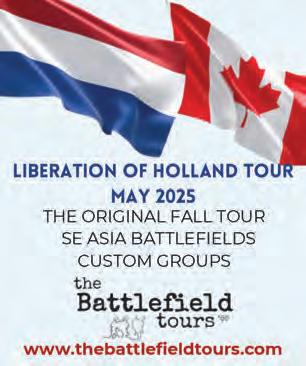
“In wellness and good spirits,” the proud father wrote, “I’d talked on the phone to my son for almost a half hour the previous evening from his Forward Operating Base in Afghanistan and he sounded calm and focused.”
Hornburg then chronicled how, after pouring himself a drink the next day, he heard a knock on the door. The wine, discarded on a kitchen countertop, went forever unsavoured as he answered to three Canadian Forces officers.
“How many are the seconds to deliver a few dozen simple words, which contain and shatter a lifetime of befores? Not enough to contain all of eternity.”
Nothing could truly fill the immense chasm opened by Hornburg’s loss. However, in telling his story, he—like Mullett and others—found a new means to channel the memories, unceasingly painful though they remained.
From a bicycle crankset to a single poppy, each item donated to the exhibit—and the often heart-wrenching stories that accompany them—offers an insight into the lives of people shaped by Canada’s military.
The 2014 initiative, a part of the Calgary-based War Stories Society, was the brainchild of founder Melanie Timmons, long a passionate believer in the power of stories and how, at least in the case of some, they may afford catharsis.
Acknowledging that her program is not therapy and emphasizing the merits of professional help,
Timmons explained: “Creating a personal story from events may allow us to take control of those events on our own terms. It is the act of creating a sense of order and producing something tangible— on paper, video or otherwise—from those intangible memories and feelings inside one’s head.”
Focusing on a single object not only hones an author’s ability to express themselves. The practice is also intended to promote empathy with would-be readers and viewers, including attendees of the War: In Pieces exhibit.
“Military women and men are a vital part of our country,” said Timmons, who has no known family connection to the Canadian Armed Forces. “It seems that many civilians have no idea who they are, what their daily lives look like, or what they do to protect us and this nation. In overcoming my own ignorance, I realized that a huge gap existed between Canadian civilian and military communities, and I wanted to do something to help bridge that gap.
“Reading these intimate stories, seeing their related mementoes, allows the public to get to know our military men and women one-on-one.”
Perhaps, too, it affords some storytellers the chance to know themselves.
The success of War: In Pieces prompted Timmons to expand the program to other ventures. In the fall of 2019, she helped kickstart a free veterans’ writing workshop now facilitated by Mike Vernon and Kent Griffiths, both former service members with journalistic backgrounds.
Regardless of experience, aspiring writers can organize, process and find meaning in certain life events. Equally, the nine-month course can enable individuals
to record their military careers for loved ones to learn about.
What prevails is a sense of community in every group and session. Each participant is provided with a safe space to embrace their creativity in an environment defined by constructive feedback and encouragement.
“It’s really across the spectrum in terms of memoir, fiction and more,” noted Vernon of the results. “We’re here to help them find their voice.”
Unfortunately, the initial class encountered a hurdle almost from the start: The COVID-19 pandemic. “That kind of derailed things,” said Vernon, “But it also gave us time to focus on putting together an anthology of the writers.”
Titled A Mile in Their Boots, the since-published book delves deep into a diverse range of military life experiences, including a typical day of basic training, serving at sea, being deployed to another country, facing the challenges of returning from war and dealing with the aftermath of a genocide.
From first to last entry, indeed from first to last page, the writing cohort moves readers with laughter and tears. Nor are they alone in such endeavours.
Beyond the anthology, subsequent classes continue to pour their hearts and souls into writing—something Timmons hopes will continue and signifies the program’s continued growth and outreach to eagerto-write veterans. “My goal is to have free writing workshops across Canada,” she explained.
“Furthermore, Mike [Vernon] has suggested that we create virtual writing programs for those in remote areas. I’d also like to curate and share more of these stories in the form of additional books, public readings, video recordings and pop-up galleries. We just need more resources, and the big challenge is to find the right people to facilitate the workshops and help us move forward.”
Nevertheless, the War Stories Society appears to boast a
strong trajectory, with both the War: In Pieces exhibit and its writing courses generating considerable interest among civilians and veterans alike. It’s what Timmons always wanted.
“Fundamentally, we humans are not so different from one another. When we meet a stranger in a
military uniform on a personal level—through a shared story— we learn how much we have in common. Instead of just saying ‘Thank you for your service’ on Remembrance Day, maybe some civilians will be inspired to start a conversation and get to know these great individuals.” L

For Canadians who are heading south this winter
Unsinkable Sam
One of the epic sea battles of the Second World War, the Battle of the Denmark Strait, was over. HMS Hood was at the bottom of the sea; a stricken HMS Prince of Wales was limping back to port. The German battleship Bismarck, disabled by a relentless barrage from British ships and aircraft, had been scuttled and sunk.
It was May 27, 1941, and after eight days and multiple torpedo strikes from Swordfish biplanes of the Fleet Air Arm along with over 400 hits from Royal Navy guns, just 114 of Bismarck’s 2,200plus crewmen would survive.
One hundred fourteen, that is, and one cat.
HMS Cossack, a Tribal-class destroyer that had joined the hunt for Bismarck during the battle’s preliminaries, was now, in its aftermath, hunting for German survivors to rescue. They found none, but for a lone, soggy cat afloat on a wooden board.
As wartime combatants are wont to do, the swabbies aboard Cossack rescued the frayed
feline, adopted him, and named him Oscar—derived from the International Code of Signals designation for the letter ‘O,’ code for “Man Overboard.”
Oscar—or the German “Oskar,” as some prefer—sailed with Cossack’s crew on convoy duty between Gibraltar and the United Kingdom for five months until the destroyer was torpedoed by U-563
Taken under tow, the heavily damaged ship sank in a storm two days later; 159 of 190 crew died. Oscar survived and became Unsinkable Sam, the black-andwhite ship’s cat of the British aircraft carrier Ark Royal
The relationship didn’t last.
Just two-and-a-half weeks later, the big flattop was sailing for Malta when it was torpedoed and sunk off Gibraltar by U-81. One sailor was killed.
Sam was found by a motor launch, clinging to a floating plank. Described by author William Jameson as “angry but quite unharmed,” the cat with at least three lives was eventually taken aboard HMS Legion, which


happened to be the same ship that rescued the Cossack survivors.
Thus ended the seagoing career of Unsinkable Sam, ship’s cat. He landed in the offices of the governor of Gibraltar, then was taken to the U.K. where he spent a sedate life in the Home for Sailors, a seamen’s retirement residence in Belfast. Sam died in 1955.
Or so the story goes.
Some have questioned whether Sam’s adventurous saga might be the stuff of sea stories—shreds of truth laced with fiction.
The skeptics point to the fact there are pictures of two different cats identified as Sam— or Oscar, as the case may be.
One, says the Royal Museums Greenwich, shows “a tabby claimed to be him and the other a blackand-white cat but clearly wearing a collar tag with the inscription ‘HMS Amethyst 1949’ (which would make that cat ‘Simon,’ not ‘Oscar’).
“Allowing a degree of confusion, however, there is no suggestion ‘Oscar’ was an official mascot on ‘Bismarck’ (so possibly aboard as an illicit crew pet) and no reason for the artist to have done this portrait if he was not.”
Simon, by the way, became ship’s cat aboard HMS Amethyst, a sloop-of-war, after a sailor found him wandering the dockyards of Hong Kong in March 1948.
The People’s Dispensary for Sick Animals awarded Simon the Dickin Medal for gallantry (known as the animal Victoria Cross) in April 1949 after he was wounded by shrapnel during the Yangtze Incident, in which Communist rebels blocked Royal Navy access to China’s
Yangtze River during the Chinese Civil War and opened fire.
An artillery round tore through the captain’s cabin, seriously wounding Simon and his skipper, Lieutenant Commander Bernard Skinner, who died soon after.
Simon climbed out of the cabin wreckage onto the ship’s deck, where he was picked up and taken to the sick bay. The cat was not expected to last the night. Simon nevertheless survived and killed off a rat infestation—which was the primary role of ship’s cats, generally, since time immemorial.
Simon became an instant celebrity, lauded in newspapers the world over, and was the only feline ever to earn the Dickin.
He also received the Naval General Service Medal and was given the fanciful rank of Able Seacat after dispos-
SIMON NEVERTHELESS SURVIVED AND KILLED OFF A RAT INFESTATION.
at an animal centre in Surrey, where he contracted a woundrelated virus and died. Hundreds, including Amethyst’s entire crew, attended his funeral at the PDSA Ilford Animal Cemetery in East London.
His tombstone declares that “throughout the Yangste Incident, his behaviour was of the highest order.”
ing of a particularly vicious rat known as “Mao Tse-tung.”
He received thousands of letters—so many that a lieutenant, Stewart Hett, was appointed “cat officer” to deal with the flood. Simon was honoured at ports of call during Amethyst’s journey home, and a special welcome was made for him upon the ship’s arrival at Plymouth in November. Alas, as was protocol, Simon had to serve time in quarantine
There is apparently no such tribute to or record of Unsinkable Sam. Official documents and histories of the day make no mention of a cat.
The convictions of avowed cat people notwithstanding, the fact that U-boats were known to be lurking after the Battle of the Denmark Strait, forcing Allied vessels to cut short their rescue efforts, casts some further questions as to whether the Cossack crew would have taken the risk, time and effort to save a cat. L

War games
Canada’s posturing toward Chinese aggression could be too late
This past July, Canada and Australia issued a joint memorandum declaring that they would increase naval co-operation in the Pacific for the express purpose of pushing back against Chinese naval expansion. It’s a significant step away from the pretend neutrality that Canada presented the world amid growing confrontation between China and just about every country that borders on the South China Sea.
The announcement from the two nations was not a CanadianAustralian version of AUKUS—the Australian, U.K. and U.S. agreement to pool resources to help the former acquire a small fleet of nuclear submarines sometime in the 2030s.
China currently has the largest navy in the world and there’s no sign of it slowing its growth as the country looks to add a flush-deck aircraft carrier with a magnetic aircraft
launcher to its fleet. And if the country’s ongoing confrontations with the Philippines near the Spratly Islands signify anything, it’s that nothing will stop the country that Napolean supposedly called “the sleeping dragon” from continuing to claim the entire South China Sea as, in effect, its own internal waterway.
Canada has never agreed with the Chinese on that position and continues to claim that the sea is an international waterway and must be open to ships of all countries. But Canada, unlike the U.S., Britain and other countries, has only whispered that position.
This past June, in fact, Global Affairs Canada released a statement condemning “the dangerous and destabilizing actions” of China, indicating the country isn’t following its obligations with regard to international law.
However, mildly worded statements from a country with relatively few military resources in the area don’t seem to faze the Chinese.
Canada’s recent muscle flexing in relation to who owns what in the far Pacific amounts to shifting a single 30-year-old Halifax-class frigate, HMCS Max Bernays, from Canadian Forces Base Halifax to CFB Esquimalt.
When a Canadian warship has occasionally sailed through the Taiwan Strait it was claimed by Ottawa, until recently, that the vessel was merely taking the most direct passage from point A to B. Only in the last two or so years has the Royal Canadian Navy admitted that these sea passages are done for the purpose of asserting that the waterway is international territory.
Although the Australian and Canadian navies are roughly the same size (even though Canada’s population is larger by about 12 million), the Australians take their naval and air resources far more seriously.
For example, Canada has four 1980s-era, British-built submarines, but it’s rare to have two of

them at sea at any one time. The Australians opted to build their own six Collins-class submarines, and while those boats suffer from constant mechanical challenges themselves, at least Australia is moving toward the acquisition of a nuclear-powered option.
While Canada faces the unique challenge of the ice-covered Arctic Ocean, only recently did it announce that it would be looking at trying to acquire a dozen non-nuclear submarines with under-ice capabilities during the next decade. Several other nations—Germany, Israel, Japan, South Korea and others—operate so-called nonnuclear AIP submarines (with air-independent propulsion, hence the acronym) that can remain submered for two to three weeks. Of course, there’s the ongoing debate whether such boats will give Canada the Arctic capacity it needs.
Canadian naval expansion is still much more a dream than a reality. The new Arctic offshore patrol ships have had several major problems, which isn’t promising since only three of the multimillion-dollar vessels have been completed and they only have a 12-month warranty. Meanwhile, the Canadian surface combatant warships that are slated to replace the Halifax-class frigates exist only on paper, and their cost has ballooned even before any steel has been cut. Officials originally said the 15 vessels would cost $26 billion to build, but in June 2024, Parliamentary Budget Officer Yves Giroux estimated the project would total $84 billion. Still, National
Legion and Arbor Alliances
Defence now maintains it will cost no more than $60 billion.
In July, Canada, the U.S. and Finland announced they would form a consortium to build new icebreakers to counter an ambitious Chinese program to develop the vessels. Indeed, this past summer, China dispatched three new icebreakers to the Arctic.
It’s good that Canada is finally recognizing a new world order and threats to the Great White North. The key question: can Canada’s naval program catch up? L
Check out David J. Bercuson’s new book, Canada’s Air Force: The Royal Canadian Air Force at 100, available now from University of Toronto Press.

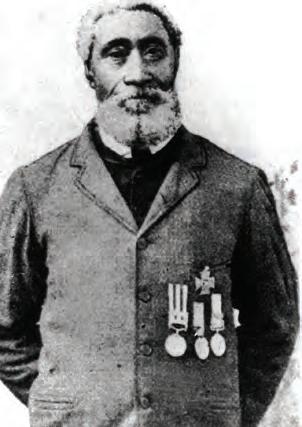
OVERLOOKED
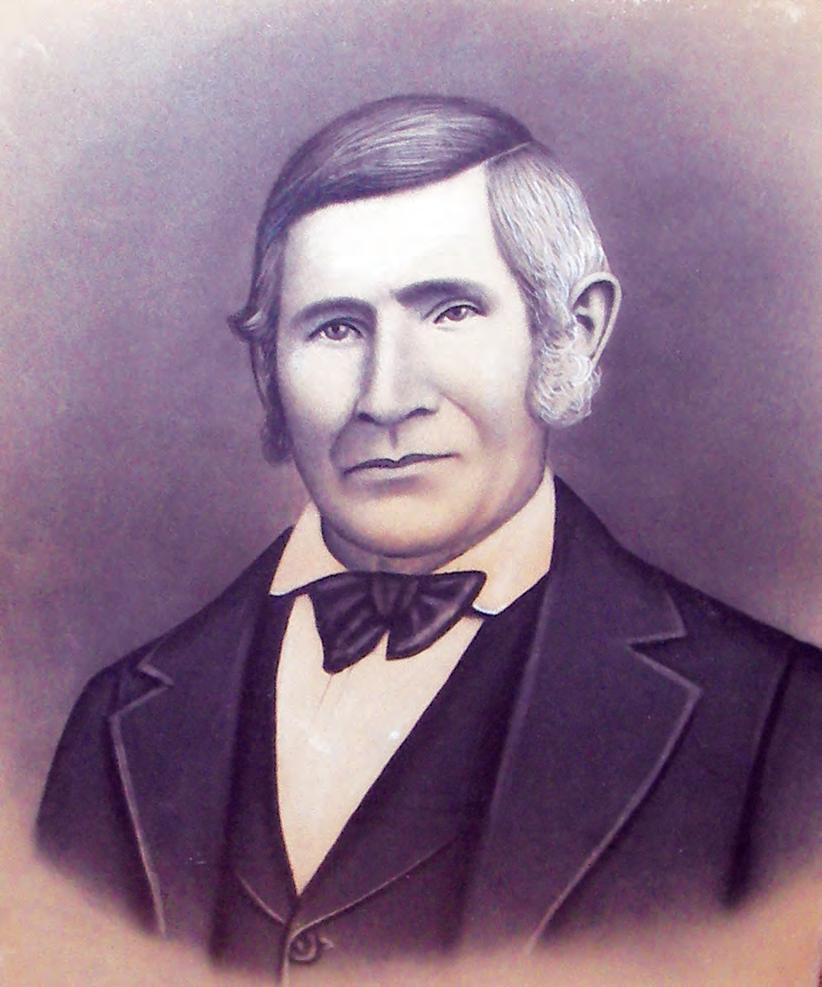
By Stephen J. Thorne
A TRIO OF COURAGEOUS ACTS OF WAR LEFT UNRECOGNIZED



For the rank-and-file soldier, the grunt, the bloody conduct of war is, aside from the killing, the abject waste and devastation, a noble endeavour, the personification of altruism, the ultimate act of selflessness.
History is replete with stories of battlefield daring and medalearning exploits. Recognition for outstanding acts of courage, innovation and sacrifice serves as reward, inspiration and a source of national pride.
The celebrated would tell you they didn’t do what they did for honour, country, or some lofty ideal. They would likely say they did it for their fellow soldiers, their comrades-in-arms, their brothers. Medals and plaudits don’t factor in the equation when it’s do or die.
Rarely by their own choosing, the doers of these deeds are exalted as national heroes, their faces and accomplishments fodder for recruitment campaigns and bond drives, their stories the subject of poetry and prose, song and cinema.
The best of them count themselves lucky, meeting their praises with the humility of those who know better, who understand what it is to kill and to survive, who count their idols among those lying in the hallowed soil of faraway fields bearing names such as the Somme, Ypres, Hong Kong, Normandy, Groesbeek, Busan.
For some, medals are haunting reminders of ordeals they would rather forget.
They know well, too, that for every Victoria Cross or Medal of Honor, pour tout les Croix de guerres, Soviet orders of Victory and Glory, and German Knight’s Crosses of the Iron Cross, there have been countless others in countless wars whose actions in the face of a hostile enemy went unrecognized and unrewarded.
Humans are flawed, and politicians, bureaucrats and military
brass are certainly no exceptions. The distribution of what British Tommies dismissed as “gongs” and American G.I.s called “chest candy” has never been a pure and unadulterated process.
Historically, factors such as race, rank, politics, quotas, location, service branch and inconsistent and arbitrary standards have all influenced decision-making.

The most recently notorious case is that of Private Jess Larochelle, an Ontarian whose magnificent defence of a strongpoint in Afghanistan earned him Canada’s second-highest award for valour, the Star of Military Valour.
His story spawned a campaign to upgrade his award to a Victoria Cross, which was refused primarily on technical grounds. The Canadian VC has never been awarded since it replaced the British version in the 1990s.
Still suffering the effects of wounds he sustained during the Oct. 14, 2006, firefight, through which he was left alone to defend a forward position, Larochelle died in 2023.
The following are the stories of three other unsung Canadians whose actions in historical wars merited more recognition than they received.
Factors such as race, rank, politics, quotas, location, service branch and inconsistent and arbitrary standards have all influenced decision-making.
WILLIAM (BILLY) GREEN

On May 27, 1813, American invaders crossed the border into Upper Canada and captured Fort George, less than two kilometres from what is now Niagara-onthe-Lake, Ont. The War of 1812 was less than a year old and the outcome was anything but certain.
Led by British Brigadier-General John Vincent, the fort’s defenders withdrew and encamped about 70 kilometres away at Burlington Heights. Two U.S. brigades set off in pursuit, pitched a roadside camp at Stoney Creek, Ont., and began planning their attack. It was June 5 and Vincent’s troops were about 15 kilometres away.
That evening, U.S. soldiers detained a local farmer, Isaac Corman, for refusing to tell them where local Indigenous warriors

were encamped. They brought him to the American lines near the beach on Lake Ontario. Corman, however, managed to convince some of the U.S. officers that he was a cousin of American Major-General William Henry Harrison, commander of U.S. forces in the northwest.
The gullible Yanks released Corman, who then requested the countersign, or password, so that he could get past the American sentries and go home. They gave it to him—Wil-Hen-Har, after the majorgeneral—and sent him on his way.
Meanwhile, Corman’s wife had reported him captured and her brother, William Green, had already set out to find him.
Known as Billy Green the Scout, the 19-year-old farm boy was born and raised in Stoney Creek, the son
of an Empire Loyalist who had left the United States around 1792.
When the brothers-in-law met on the road outside Stoney Creek, Corman told Green of the American plans and gave him the countersign. The Americans soon discovered Corman’s ruse, however, and promptly recaptured their escapee. Green was already on his brother Levi’s horse “Tip” headed for Burlington Heights to warn the British of the impending attack.
Arriving at the British encampment, he was taken for a spy, detained and interrogated by Lieutenant-Colonel John Harvey, who soon deduced the kid was legit. Acting on Green’s intel, the password he provided, and his intimate knowledge of the countryside, Harvey formulated a plan to launch a nighttime ambush on the American camp. He gave Green a sword and asked him to guide his troops through the fog-enshrouded forest.
They set out just before midnight, encountering their first American sentries at Davis’ tavern in Big Creek. The Americans fired their muskets and fled. The British force stumbled upon more sentries along the way. Green gave one the countersign and dispatched him with his sword. Green stayed with the British troops as they mounted the attack, seized artillery pieces and captured senior American officers. The Americans who could, fled. Green’s contribution was undoubtedly pivotal to the British
After the Americans captured Fort George in Upper Canada, William Green passed critical info about their continuing advance to the British. He fought with the red coats during their subsequent victory at the Battle of Stoney Creek.
victory. But his story has been both questioned and grossly enhanced. Despite much gilding of the lily, however, he never achieved the renown of his contemporary, Laura Secord. Indeed, embellishments of his role during the last 200-plus years have not served him well.
The March 12, 1938, edition of the The Hamilton Spectator called him “the Paul Revere of Canada,” claiming he “sighted the American army massing below the mountain at Stoney Creek” and “felt it his duty to inform the English troops of their nearness.”
“This is a fabrication, as the British knew exactly where the Americans were, and knew they were being pursued by them,”
Philip E.J. Green wrote in an exhaustive analysis and defence of Billy the Scout’s story published in the May 2013 edition of The War of 1812 Magazine
Green the writer said such myths have fuelled theories that the whole story is a fanciful lie. After-action reports by British and American officers make no mention of either Green or Corman, bolstering the case to discredit the story.
But Laura Secord’s role in the British victory won by Indigenous forces at the Battle of Beaver Dams two weeks later was never acknowledged in official reports either.
Secord had overheard American officers at Queenston discussing plans to attack a smaller British force under the command of Lieutenant James FitzGibbon. She then walked some 30 kilometres on a circuitous route through rugged terrain to warn FitzGibbon, who subsequently dispatched Captain Dominique Ducharme, in command of First Nations warriors, to address the matter. They won a quick victory and Secord has chocolates named for her.
Green’s contribution was undoubtedly pivotal to the British victory. But his story has been both questioned and grossly enhanced.

“The primary sources of evidence used to establish the story of Laura Secord are the personal accounts of Laura Secord herself,” wrote Green, whose relation to Billy the Scout, if any, is unclear.
FitzGibbon wrote a certificate 24 years later, in which he said Secord did “acquaint” him with the Americans’ intentions. Mohawk Chief John Norton wrote in his diary that “a loyal Inhabitant brought information that the Enemy intended to attack us that night with six hundred men,” but doesn’t name the inhabitant.
There are several accounts by British and American officers of the Battle of Stoney Creek—and the events preceding it. “As with Secord, none of them mention Billy Green,” the author wrote. “Nor is there a certificate describing his role in the action.
“There are no accounts written by Billy Green himself; he was an illiterate.”
And, notes Green the author, Billy had reasons to stay silent about his role at the time, not the least of which was to avoid unwanted attention from the Americans.
Years later, the local justice of the peace, Peter Van Wagner, mentioned Green in his diary shortly after the scout died. He related the remorse Dr. Thomas Picton Brown said his patient, Billy Green, expressed over killing an American
sentry. The sentry had just fired his single-shot musket and was thus, in Green’s mind, unarmed.
“In a charge on a picquet [sentry] he run a man through who had an empty gun without a bayonet,” wrote Van Wagner. “This was related to me by Dr Brown as he attended Green in dangerous illness where he told the doctor he was very sorry for what he had done, for he knew the US soldier was defenceless for he had seen him discharge his piece.”
Green the author says the scout’s own telling of the events of that night jibes with the general accounts contained in official reports, bolstering the validity of his story. The military accounts weren’t published until decades later and, regardless, could not have been read by the illiterate Green.
The corporal’s sword that Green is believed to have wielded was passed down through four generations of his family and is now in the collection of the Stoney Creek Historical Society’s Reference Library and Archives.
Still, the myths have persisted, fed by the likes of this gem from a 1938 edition of The Mail and Empire newspaper: “And so Canada remained British…due to the cool-headed, yet audacious courage of Billy Green, the farm lad who was God’s instrument in saving Upper Canada.”
JEREMIAH JONES
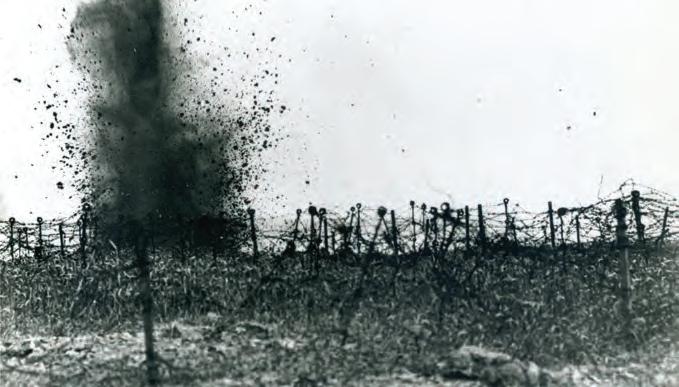
Jeremiah Jones, a Black man from East Mountain, N.S., fought Germans in the trenches and racism on Parliament Hill before he finally received muted recognition for his courage decades after he helped Canada win the Battle of Vimy Ridge.
The six-foot-two private was already 58 years old by the time he reached the front in February 1917 as a member of The Royal Canadian Regiment. Two months later, he crossed the bloody battlefield at Vimy and took an enemy machine-gun nest.
Not only did he contribute to a notable victory of the First World War, but the humble giant (the average enlistee measured 5' 6") proved a Black man’s worth in a white man’s army.
“I threw a hand bomb right into the nest and killed about seven of them,” Jones recalled years later. “I was going to throw another bomb when they threw up their hands and called for mercy.”
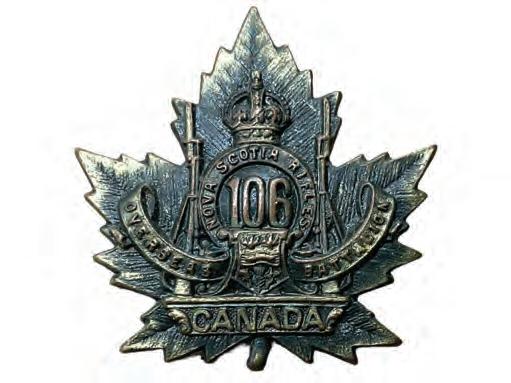
A mortar shell explodes amid trenches on Vimy Ridge in May 1917. Jeremiah Jones was awarded a Distinguished Conduct Medal for his actions during the battle.
Black enlistment. “Coloureds,” they said, wouldn’t make good soldiers.
Blacks had been trying to enlist in the Canadian forces without success. In Saint John, N.B., 20 Black volunteers had no place to serve. “It is a downright shame and an insult to the race,” John Richards, a Black community leader, wrote to federal officials.

Jones ordered the half-dozen survivors out of their hole, then marched them at bayonet-point back to the Allied lines, carrying their weapon. He had them deposit the machine gun at the feet of his commanding officer.
“Is this thing any good?” he asked.
His exploits that day earned him acclaim at home and abroad, but they remained the subject of debate from London to Ottawa for almost a century.
By Aug. 17, 1917, his hometown newspaper was celebrating Jones as “a patriot, brave, powerful and resourceful.” His commander recommended him for a Distinguished Conduct Medal, the second-highest valour award after the Victoria Cross at the time.
But “the lion of the hour” was Black, and to give a Black man a bravery medal in 1917 would have been a political bombshell at a time when the military’s top brass—and some senior politicians—opposed
The response was unequivocal. An officer in Victoria said no white battalion would take Blacks. In Halifax, whites withdrew voluntary enlistments when rumours circulated that they might have to serve with Blacks.
“Neither my men nor myself, would care to sleep alongside them, or to eat with them, especially in warm weather,” wrote LieutenantColonel Walter H. Allan of the 106th Overseas Battalion, which eventually enlisted Jones by order of the federal government.
The matter was debated in Parliament before the military chief of staff issued a memorandum on April 13, 1916, citing what he called the facts.
“The civilized negro is vain and imitative,” wrote Major-General Willoughby Gwatkin. “In Canada he is not being impelled to enlist by a high sense of duty; in the trenches he is not likely to make a good fighter.”
Such attitudes were not limited to matters of military service. The longheld belief among some that racism
Jones was finally recognized on Feb. 22, 2010, when Ottawa posthumously awarded him the Canadian Forces Medallion for Distinguished Service.
was not widespread in the Great White North has been misplaced.
“The treatment received by ‘visible’ Canadians did not originate with the military,” James Walker, a leading scholar of Canadian race relations and Black history at the University of Waterloo, wrote in a 1989 paper.
“Recruitment policy and overseas employment were entirely consistent with domestic stereotypes and ‘race’ characteristics and with general social practice in Canada…. Racial perceptions were derived, not from personal experience, but from the example of Canada’s great mentors, Britain and the United States.”
All this, despite the fact another Black Nova Scotian, Royal Navy gunner William Hall, was awarded a Victoria Cross for his actions at the 1857 Siege of Lucknow during the Indian Rebellion, in which he and an officer continued firing their 24-pounder after the rest of the gun crew had been killed or wounded.
There was righteous indignation among Blacks and whites alike over the rejections of Black volunteers in the early days of WW I.
As early as November 1914, Arthur Alexander of North Buxton, Ont., told Militia and Defence Minister Sam Hughes that “the coloured people of Canada want to know why they are not allowed to enlist in the Canadian militia.
“I am informed that several who have applied for enlistment in the Canadian expeditionary forces have been refused for no other apparent reason than their colour.”
On Sept. 7, 1915, George Morton of Hamilton wrote Hughes “on a matter of vital importance to my people (the coloured), in reference to their enlistment as soldiers.”
Morton wanted to know if Ottawa had an official policy on enlistment of “coloured men of good character and physical fitness.”
“A number of coloured men in this city, who have offered for enlistment and service, have been turned down and refused, solely on the ground of colour or complexioned distinction,” he wrote.
“A number of leading white citizens here, whose attention I have drawn to this matter, most emphatically repudiate the idea as being beneath the dignity of the Government to make racial or colour distinction in an issue of this kind.
“They are firm in their opinion that no such prohibitive restrictions exist.”
Hughes issued a directive confirming and attempting to rectify Morton’s assertions shortly afterward. But it didn’t seem to matter. By Dec. 31, at least 200 Black Canadian volunteers had been rejected.
Allan’s 106th eventually took on 18 Blacks, but most, including Jones, were reassigned once overseas. Jones, who had lied about his advanced age to get in (he said he was 38), went to a reluctant Royal Canadian Regiment.
There, he more than proved his worth.
“Jeremiah Jones put the lie to perceptions of the day,” the late author, historian and eventual senator Calvin Ruck told The
Canadian Press in 1995 amid a campaign by the Black Cultural Centre for Nova Scotia to recognize the soldier’s contributions.
“His actions served to change the view of the ability of Blacks under fire,” said Ruck. “He showed people Blacks could be as good soldiers as anybody else and the majority community didn’t have a monopoly on bravery or devotion to duty.
“Blacks were just as proud and as loyal to king and country.”
The centre’s campaign, however, stalled in Britain that same year.
“Regardless of the right and wrong of the perceived or real discrimination against Blacks in the Canadian Army, there can be no question of a retrospective award,” wrote Lieutenant-Colonel Richard Bird of the British Defence Ministry.
“State awards for both gallantry and meritorious service are announced within a year or so of the citations to which they refer. There were many servicemen like Jones who did not receive recognition for their gallant deeds.”
Jones’ lack of recognition is particularly galling given the number of VCs handed out for the taking of machine-gun positions during WW I, especially given the fact that the private did it solo, took prisoners, and brought back the gun.
But Ruck didn’t give up, and his efforts ultimately paid off—somewhat.
Jones was finally recognized on Feb. 22, 2010, when Ottawa posthumously awarded him the Canadian Forces Medallion for Distinguished Service, which wasn’t created until 1989 and was intended for individuals and groups who aren’t active members of the Canadian Forces.
It was no DCM, but it was a measure of recognition.
Jones returned to Truro, N.S., at war’s end, rejoined his wife Ethel and lived out his life as a woodsman, farmer and handyman. They had a large family. Jones died in 1950.

FLIGHT LIEUTENANT JAMES ANDREW WATSON
On the night of April 27-28, 1944, Lancaster R-ND 781/G of 622 Squadron, Royal Air Force, piloted by Flight Lieutenant James Andrew Watson of Hamilton, Ont., set out from England on a bombing mission to Friedrichshafen, Germany.
R-ND would never reach its target but, like Jess Larochelle 80 years later, Watson’s heroic actions that black night over occupied territory would inspire an unsuccessful campaign to award him a Victoria Cross—posthumously.
The seven-member crew—three RAF, four Royal Canadian Air Force—were at 6,000 metres (27,000 feet) as they approached the turning point, 30 minutes out, for their final run into the target. Suddenly, they were attacked from dead astern and below by three Junkers Ju 88 night fighters. It was about 1:30 a.m. and they were a little south of Strasbourg, France.
“The attack was a complete surprise, there was no moon, just complete darkness,” recalled Ron Hayes, the bomber’s midupper gunner. “The aircraft was equipped with H2S radar equipment which transmits pulses and the crew and Intelligence were not aware at the time that the Germans were able to home in on the signal.”
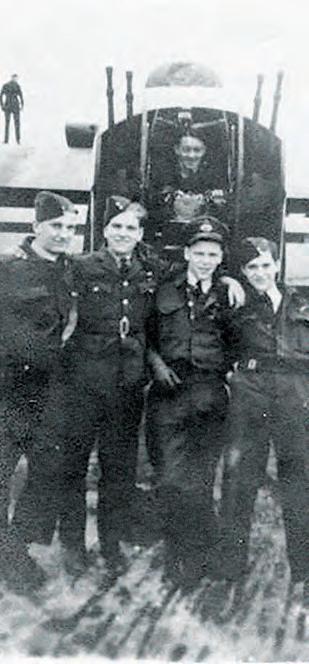
The crew could hear the thuds as the German rounds hit the rear of the aircraft and they saw flashes as the port elevator badly buckled. The rear gunner, RCAF Flight Sergeant Murdock MacKinnon—a Cape Breton native living in Somerville, Mass., when he signed up—later reported that his radio and turret were knocked out.
Flight Lieutenant James Watson poses with his Lancaster crewmates.

RAF Sergeant Roy Clive Eames, flight engineer, said the initial attack had also penetrated the plane’s nose and knocked out its aileron and rear controls. With MacKinnon out of commission, Hayes directed the pilot’s evasive actions. But they were essentially flying blind. From his vantage point atop the Lanc, Hayes couldn’t see their attackers’ approaches and had to make his calls based on the disconcerting volume of tracers arcing past his canopy.
Watson began corkscrewing as the attacking aircraft came closing in again from 350 metres. Hayes described his pilot’s response to his evasive directions as magnificent, but still the bomber was hit in the starboard inner engine. Within 30 seconds, the wing and engine were burning. The fire extinguisher system had no effect.
Watson, at 21 among the eldest aboard and flying his 17th mission, side-slipped the big, lumbering plane to keep
the flames at bay. But the manoeuv re amounted to a trade-off—the fire didn’t reach the crew, but they were losing altitude fast.
“During this time the captain asked the navigator to inform the crew of our position for the purpose of escape,” MacKinnon reported later. “The navigator told us we were approximately on the French border.
“There was at no time any suggestion of panic and this was largely due to the coolness and perfect calm of our captain.”
Throughout the combat, Watson repeatedly asked for news of the rear gunner, with whom he had flown all his missions, and assured the rest of the crew that he would look after him. “Whatever happens, he’ll be OK,” the pilot assured them.
“I then plugged into the intercom system and informed the pilot that…the rear gunner was still in his turret and I would let him know we were getting out,” said Hayes. “The captain’s last words to me were: ‘Yes, OK, but hurry, we’re at 4,500 feet; if he’s not hit he might make it. So long Ron, good luck.’”
Hayes, just 19 at the time, then opened the bulkhead door leading to the rear turret. MacKinnon turned his head and Hayes patted his parachute. The rear gunner turned away without acknowledging the news.
“The aircraft was now at about 4,000 feet when I bailed out,” Hayes said. “The pilot had the aircraft under perfect control, it was still losing height in a sinking fashion and the flames had enveloped the fuselage alongside the burning wing.”
“It is quite clear, that Flt.-Lt. Watson sacrificed his life knowingly and willingly to ensure the safety of his crew.”
At the words “he’ll be OK,’” Eames said in a statement filed July 25, 1946, he realized “with horror…that Flt.-Lt. Watson would not leave that aircraft while there was the slightest doubt that a member of the crew remained [inside] and as a last resort would attempt a crash landing to save that member of his crew.”
As the fuselage seam aft of the burning engine began melting, Watson directed the crew to collect their parachutes. Soon, the wing was almost totally engulfed, and a gaping hole was forming in the side of the plane.
“I’m sorry lads,” said Watson, “but you’ll have to hit the silk.”

In a report on the incident filed May 6, 1945, weeks after they were freed from German prison camps, MacKinnon said the Lancaster was badly damaged. Without intercom, he said he was “entirely ignorant of proceedings” until Hayes appeared.
“Starboard elevator in tail shot off,” reported MacKinnon. “Navigator [Flying Officer William Ransom of Hamilton] stated pilot was last seen holding stick hard to port.
“When I baled [sic] out the aircraft was a blazing mass in a dive so it seems impossible that pilot got out. I baled [sic] out when flames were passing rear turret.”
As Ransom took his turn at the escape hatch, the third to go, he took one last look at Watson, whom he said was having “difficulty maintaining the aircraft in level flight.”
“Leaving the aircraft and releasing my parachute, I was able to watch the burning aircraft almost until it crashed,” Ransom later wrote. “It remained level, latterly, and in a shallow dive for much longer than would have been necessary for F/L Watson to reach the escape hatch and bailout, a fact which leads me to believe that he remained at the controls in order to allow the rear gunner, whom we were all under the impression was injured, as much time as possible to clear his turret.”
MacKinnon, he later learned, got clear “just in time to have his fall checked by his parachute, before reaching the ground.”
Hayes, who had directed Watson through the attack, landed hard in an open field. He blamed the impact on his low-level escape, a disconcerting delay in the deployment of his ill-serviced parachute, and a lack of instruction in its use.
“The action with the German fighter aircraft, the difficulty in evacuating our aircraft and the bale-out [sic] and hard landing in the dark were very stressful experiences, and the right side of my body and lower back [were] aching,” he said.
Dizzy, Hayes rested for a few hours where he had landed, out in the open.
As daylight approached, he rose to search for a hiding place in a wood or a barn, but the pain was so bad he only managed to make it to a nearby ditch, where he was discovered by a local and taken to the village of Guémar.
He was interviewed by a young girl who could speak some English before he was taken to the village hall around 1 a.m. on April 28.

“Here I met a French Schoolmistress, Mme. Lousie Strohl, who gave me tea, biscuits and tobacco, then she told me that Flight Lt. Watson had been found dead at the controls of the aircraft. She went to some length in describing him, even saying he was a Canadian and that he had two stripes on his epaulettes.
“This lady was sympathetic and wanted to cheer me up and make me feel at home, even though she could not help me escape. The village hall had become crowded with the local inhabitants who might have helped me escape if it was not for their fears of the Gestapo.”
A pair of Luftwaffe intelligence officers took Hayes to Colmar, France, for interrogation.
“After the usual questions, I was asked if I could help them in identifying the belongings of a dead pilot,” he said. “The items were those of Flight Lieutenant Watson in an envelope, consisting of his identification bracelet and a ring.
“I knew that the ring had been given to Jimmy Watson by his father. The Germans said that they had taken the articles from a…pilot who was found dead in the pilot’s seat of a Lancaster. I said nothing to them for fear that it might be the beginning of a long interrogation and I also knew that the identity bracelet was sufficient.”
Hayes surmised that Watson had died trying to save the rear gunner, MacKinnon. At Colmar, he saw three of his crewmates, but they didn’t speak to each other in case the Germans were listening.
Eames and Hayes were taken to Stalag Luft VI, while officers Ransom and W.H. Russell were separated. On the way to the prisoner-of-war camp, Eames told Hayes he had seen MacKinnon.
“Seeing him gave me a severe shock as I had convinced myself that he had been killed,” reported Eames.
In fact, all six crew who had escaped the burning plane had miraculously survived and were liberated in the spring of 1945. Hayes, an Englishman, would immigrate to Canada in 1951, largely based on the impressions left by his Canadian crewmates.
In a letter written while still a PoW in January 1945, Ransom asked his father, a padre at the Canadian Army Trades School, to “please see Jimmie’s folks and give them my deepest sympathy. He died like a hero in the fullest meaning of the word.
“He reached the ultimate in courage and devotion to duty that a bomber skipper can reach in that he gave his life that his crew might live, and he was successful, as all of us are safe. I am looking forward to meeting the parents of the grandest guy I’ve ever known—when this war is over.”
Eames called Watson “the bravest and coolest fellow I have ever met,” adding “we all owe our lives to him.”
In 1946 and 1947, five members of the crew put forward recommendations for the Victoria Cross to be awarded to their skipper.
“I firmly believe it would be impossible for an aircraft, in as badly damaged condition as was ours, to remain in such an attitude of flight without any assistance from the controls,” reported Ransom, who had flown many missions with Watson.
“I am convinced that on this occasion he unhesitatingly made his decision and at the cost of his own life remained at his post to ensure that his crew would have every possible opportunity and every valuable second of time to abandon the aircraft and save their lives.”
“It is quite clear,” said MacKinnon, “that F/L Watson sacrificed his life knowingly and willingly to ensure the safety of his crew. His most courageous act,
his great and noble sacrifice in the face of the enemy was beyond the highest ideals of his duty and merits the highest possible award for gallantry and for valour in the face of the enemy.”
Watson’s nomination for a Victoria Cross, however, went nowhere. He received only a Mention in Dispatches, one of an untold number of bomber pilots who died saving their crew and were never given their due.
Except two: a British Halifax pilot named Cyril Joe Barton, and a Canadian.
Squadron Leader Ian Willoughby Bazalgette, a Lancaster pathfinder pilot from Calgary, was posthumously awarded a VC after pressing home his Aug. 4, 1944, run into a target near Senantes, France, in a mortally damaged aircraft.
With his bomb aimer gravely wounded, Bazalgette successfully marked the target for the rest of the attacking squadron, then kept his flaming bomber from crashing into a nearby village and ordered those of his crew who could to parachute to safety.
The 25-year-old pilot, who had earned a Distinguished Flying Cross in Italy a year earlier, subsequently managed a belly landing, but the plane then hit a ditch and exploded. Bazalgette and two wounded crewmates were killed.
“That the attack was successful was due to his magnificent effort,” said his VC citation, published 10 days after he died. “His heroic sacrifice marked the climax of a long career of operations against the enemy. He always chose the more dangerous and exacting roles.
“His courage and devotion to duty were beyond praise.”
James Watson got no such acclaim. He’s buried close to where he died—at Choloy War Cemetery at Meurthe-et-Moselle, France. His family attended a 2009 ceremony when a monument was dedicated to Watson near the crash site in Saint-Hippolyte, France. L

Belleville Brockville Clarington Durham Region Cornwall
Etobicoke Georgina Innisfil Kingston London Mississauga Northumberland North Bay Orillia Ottawa
samurai The Canadian


Masumi Mitsui (standing) and comrade Masajiro Shishido pose for a photo in 1916.
By Russ Crawford

Great War Sergeant Masumi Mitsui never stopped fighting for right
The magical and romantic legend of brave samurai warriors and their heroic adventures and unfaltering personal discipline fuelled Masumi Mitsui his entire life. His father was an officer in the Japanese navy and his grandfather was one of the last authentic samurai to serve the emperor of Japan before the Meiji Restoration in 1868.
From early childhood, Mitsui dreamt of being a noble fighter like his ancestors. His aspiration finally came true, not in Japan, and not even in his new home in Canada, but rather on the gritty battlefields of Europe during the First World War.
encountered hostile discrimination and prejudice. Most Asian immigrants had no rights as Canadian citizens and they typically worked for slave wages, often living in substandard accommodations. This wasn’t his dream, however, and like many other newcomers, a return to the homeland simply wasn’t possible. He persevered.
Canadian Japanese Volunteer Corps led by Yasushi Yamazaki, an organizer in Vancouver.
As war continued to rage on into 1916, and with reinforcements desperately needed, Masumi and his fellow Japanese Canadians discovered they could enlist in Alberta, so they travelled to Calgary at their own expense and were welcomed by the 192nd Canadian Infantry Battalion. It wasn’t long before the Japanese volunteers got the call to fight. The group knew they weren’t just fighting for the Allied forces in Europe; they were also fighting for respect and acceptance at home. For most, it was an opportunity to prove their loyalty.
In November 1916, the contingent arrived at the St Martin’s Plain training grounds in the southeast corner of England after field training in Halifax. Mitsui was eventually

Mitsui became a decorated Canadian war hero. He received the Military Medal, the British War Medal and the Victory Medal for his service and bravery in action. He, and 221 other JapaneseCanadian immigrants who served with the Canadian Expeditionary Force, deserve to be remembered for their commitment in defending their adopted homeland.

Born on Oct. 7, 1887, in Tokyo, Mitsui immigrated to Canada in 1908 after he was rejected by the Japanese military. In choosing Canada, he hoped for a new beginning, but instead he
Mitsui helped form Branch No. 9 of the Canadian Legion of the British Empire Service League (now the Royal Canadian Legion) in 1926.
With the onset of the war in Europe and Canada’s involvement as a member of the British Empire, Masumi and other Japanese Canadians saw an opportunity to demonstrate their loyalty to their new country by joining the CEF. With a few exceptions, however, Asians, weren’t being accepted for duty in B.C.
Undaunted, Mitsui joined the 227-member unsanctioned
attached to the 10th Battalion. When they were asked why the Japanese were fighting for Canada, they would say, “We are Canadians, fighting for Canada.” War was hard. The fighting was difficult, especially for the smaller-statured Japanese soldiers, but they followed orders and fought bravely. Fifty-four of the group were killed in action. They faced the enemy in some of the


most infamous encounters of the war, including at Vimy Ridge, where the 10th Battalion used a creeping barrage to gain position, then held the line in the muck and mire for two days. Following that encounter, the JCs, as they came to be called, distinguished themselves in the Battle of Hill 70 and later at Passchendaele.
Mitsui participated in many strategic planning sessions held by the officers thanks to his fluency in English. He translated engagement plans for his less-fluent comrades, which, along with his exemplary leadership in the field, led to his eventual promotion to sergeant.
With the armistice on Nov. 11, 1918, the war ended, but it wasn’t until April of the following year that Masumi and his fellow JCs boarded RMS Carmania to head home.
After the war, Mitsui returned to B.C, determined to find a job that would give him independence and respect. Recalling the small farms he had encountered across Europe and what seemed like an idyllic lifestyle, he used his savings and his war bond and bought a sevenhectare poultry and vegetable farm in Hammond (now Maple Ridge), B.C. He built a house at 1945 Laurier Avenue in nearby Port Coquitlam and became a chicken farmer.

Mitsui received the Military Medal, the British War Medal and the Victory Medal for his service and bravery in action.
He and his new wife Sugiko had four children and built a successful farming business where he was in charge and didn’t have to endure many of the same challenges other immigrants faced in mills, mines and fisheries.
In search of sustaining the feeling of military camaraderie, Mitsui helped form Branch No. 9 of the Canadian Legion of the British Empire Service League (now the Royal Canadian Legion) in 1926. Made up entirely of local Japanese-Canadian veterans, Mitsui was unanimously elected as its first president.
Aside from a few years of success as a chicken farmer, the best years of Masumi’s life occurred during the most difficult and dangerous time—the Great War. As a soldier, his ethnicity didn’t define who he was as a person. He and his fellow Japanese Canadians were accepted as equals. They fought, lived and died just like everyone else.
In return, they expected this new acceptance would follow them back home. But that didn’t happen. In many cases, the animosity and hatred were even worse when they returned. Despite the persistent racism, both before and after the war, Japanese immigrants remained determined to belong as Canadians.
Masumi’s next service to his community was an initiative to erect a memorial to the Japanese Canadians who had fought. With the help of Asian businessmen in Vancouver, a cenotaph with an eternal flame was commissioned and located centrally in Stanley Park in April 1920. It recognized the famous WW I battlefields in Europe and paid tribute to the Japanese-Canadian soldiers who fought on them.
Japanese veterans continued to face the shocking realization that even after risking their lives for their country, they were still treated as second-class citizens in Canada.

Japanese-Canadian businessmen who helped sponsor the Japanese Canadian War Memorial in Vancouver’s Stanley Park gather at its unveiling in April 1920 (left). Members of the Canadian Legion Branch 9 pose for a photo at the monument in May 1939. Mitsui in 1987.



The situation was exemplified by the fact that most Asian newcomers weren’t allowed to vote in B.C. elections. The fight for the right to vote for all Japanese Canadians became Mitsui’s next battle and, in April 1931, he and a small delegation prevailed in the Victoria legislature and secured, for veterans of Japanese ancestry, the right to vote in B.C. Other Japanese Canadians didn’t get the right until 1949.
Mitsui’s life took another unexpected and decidedly negative turn when Japan attacked Pearl Harbor, Hawaii, in December 1941. Instinctively, Mitsui knew what he had to do as another world war loomed. He immediately wanted to enlist but, at 54 years old, his wife and family tried to convince him he was too old to fight. None of their views mattered though, as the Canadian government decided

to detain all Japanese Canadians out of a fear they would aid the Japanese war effort—even though many of the younger family members had never even been to Japan.

The internment process was brutal. Japanese Canadians living in B.C. were forcibly sent to camps in the province’s interior under difficult conditions. They were dispossessed of their personal belongings, including homes, fishing boats and vehicles, which were seized and sold well below their value. Their rights were revoked. The families suffered isolation and further discrimination. When they were released, they were left to fend for themselves to rebuild their lives.
Mitsui never stopped feeling a call to duty. During the Second World War, while most Japanese Canadians had been interned in
camps, the eternal flame atop the Japanese Canadian War Memorial had been extinguished. After being refurbished by the Japanese-Canadian community, the memorial’s flame was relit on Aug. 2, 1985. Mitsui was a guest of honour at the ceremony, one of two surviving Japanese-Canadian soldiers from the First World War.
Masumi Mitsui embodied the spirit of a modern-day samurai. While he was certainly a wartime hero, he was also a champion for change. He was relentless in his fight for equality for Japanese Canadians and he dedicated himself to efforts of remembrance for his comrades.
Read more about the life of Masumi Mitsui in the biography Canadian Samurai: One Man’s Battle for Acceptance by Russ Crawford. L

AND THE PARTISANS
Captain George Campbell
Courtesy Sean Healy
Captain George Campbell Tinning depicts Ravenna, Italy, in February 1945. Months earlier, partisans led by Captain Dennis Healy (right) liberated the town.


Canadian Captain Dennis Healy, a peacetime university prof, played a pivotal role alongside locals in the liberation of the Italian city of Ravenna

By Mark Zuehlke
ON
the night of Nov. 20-21, 1944, 33-year-old Canadian Captain Dennis Healy slipped into a rowboat alongside an Italian partisan leader. Healy’s mission was to support partisans operating behind German lines from a base situated on an island that was surrounded by a large swampy area to the north of Ravenna. Heavy squalls immediately forced the party back to a beach outside Cervia—where I Canadian Corps was headquartered. Thwarted
again the following night, it wasn’t until Nov. 25-26 that their small group rowed off to spend seven hours “tossing…on a lonely sea” before turning shoreward just north of Porto Corsini—the large port complex outside Ravenna.
Tensely the men looked unsuccessfully for a signal from a shore party that was to meet them. Finally, as Healey later wrote, they grounded the boat and waded ashore “with weapons cocked.” Out of the darkness came “the shrill cry of a nighthawk.” An oarsman replied in kind “and we were soon surrounded by a band of armed cutthroats who spirited our cargo away into the night and lifted our craft on to an awaiting ox-cart. No word was passed. A few minutes later, we




“BULOW KNEW EXACTLY WHAT WAS WANTED” AND, WHEN THE TIME CAME, WOULD STRIKE “WITH THE UTMOST VIGOUR AND DETERMINATION.”
were threading our way through the dunes towards the partisan camp…. A rear party worked until one hour before dawn covering the tracks we had left, then women and children… went down at first light to finish the job.” Healy’s mission, which would culminate in the partisans liberating Ravenna, had begun.
Dennis McNeice Healy was an unlikely guerrilla operative. Born in Bethune, Sask., he followed an academic path that led to heading up the French department at Edmonton’s University of Alberta. After the war started and he joined the army, Healy’s fluency in French,
Italian, Spanish and basic capacity in German and Dutch had him attached to I Canadian Corps headquarters as an intelligence officer. Generally, he spent his time analyzing documents to assist LieutenantGeneral Charles Foulkes in directing Canadian operations in Italy. There had been no training in conducting covert operations or working with resistance fighters. Healy, however, was present when the Italian partisan leader was brought to corps headquarters early on Nov. 20. A couple of days earlier, Lieutenant Arrigo Boldrini—who went by the nom
de guerre Major Bulow—had journeyed by rowboat past the German lines. Met by U.S. Office of Strategic Service (OSS) operatives, Bulow was escorted to British Eighth Army headquarters.
At first, the OSS had been unsure what to make of the “scrawny lieutenant in his late twenties, the son of Romagna peasants.” Their doubts were quickly swept aside when Bulow professionally used operational maps to brief the Eighth Army commander.
Bulow told him there were 900 partisans hidden in the swamps. They were designated by the Italian
military serving with the Allies as the 28th Garibaldi Brigade. Bulow said his men were ready to liberate Ravenna from the Germans.
While some officers, like Bulow, had served in the Italian army and turned against the Germans when Italy surrendered to the Allies in September 1943, most partisans were local men and women with no formal training.
Bulow said that if the Allies worked closely with the partisans, the city of Ravenna could be spared heavy air, sea and land bombardment to oust the German occupiers. Ravenna’s numerous Renaissance cathedrals that housed one of the world’s finest collections of mosaic artwork, Bulow said, must be saved from destruction.
The Brits passed Bulow on to the Canadians. It was Foulkes’ forces who were closing on Ravenna and would either work with the partisans or not. Bulow advised the Canadian command that the partisans controlled the marshes and could fight the Germans from that stronghold. But they desperately needed arms, ammunition, clothing and food.
Deciding someone must work directly with Bulow, Healy was
assigned the task. The partisans already had an OSS radio team in place, so Healy would use them to report the positions of German headquarters, strongpoints and any other information that would assist the Canadian advance on the city.
Foulkes, Bulow and Healy spent several hours planning, which Healy credited with developing “mutual trust and confidence” and ensuring “Bulow knew exactly what was wanted” so when the time came, they would strike “with the utmost vigour and determination.”
Healy’s first impression of the partisan camp was that so many essential things were lacking, “I doubted whether we could be effective as a harrying force unless supplies could be sent in before we were ordered into action.”
There was little ammunition and the only lubricant for guns was Brilliantine, which worked poorly or not at all. There was no means of caring for sick or wounded and evacuating them was impossible.
“The men were half naked and it looked as though the cold and damp would greatly reduce our fighting strength unless warm
clothing and blankets could be provided,” noted Healy.
He sent corps a shopping list, but foul weather made sea or air delivery impossible. Dribs and drabs were finally provided.
The camp situation on the island, Isola degli Spinaroni, meant it could only be approached by crossing flat, marshy ground that offered good fields of fire for the defence. But if the camp were to be discovered, the Germans could shell or mortar it while the partisans could offer no effective response.
Healy sought to create defensive shelter and firing positions by having the partisans dig slit trenches and other fortifications from which they could fight.
“The partisans,” he reported, “muttered darkly about ‘regular soldier nonsense’ but complied.”
Healy’s presence attracted a stream of reconnaissance reports from many sources.
“No task is more trying than that of attempting to obtain accurate military intelligence from untrained observers. It required the patience of an angel, an inexhaustible supply of cigarettes and a fund of good humour,” noted Healy.
As the Germans treated every adult male and most females as potential partisans subject to detention, Healy relied on “the aged and infirm” to gather intelligence and serve as runners between partisan strongholds.
Partisan observers were sent out, but they moved only at night and in areas each knew well. Observers generally hid in houses through the day, sending women and small boys to gather intelligence. The next night, the information would be carried back to camp.
“These missions were not without hazards,” said Healy, “several partisans failed to return.”

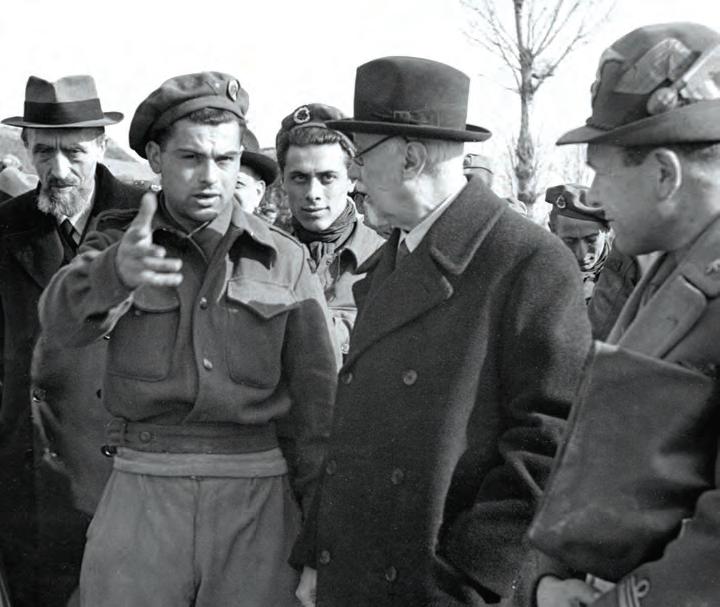
Sorting through the intelligence, Healy believed his findings were accurate and important, but also that if left to just their own devices
Captain Healy hoists a Panzerfaust near Ravenna. Italian partisan leader Lieutenant Arrigo Boldrini, nom de guerre Major Bulow, speaks with Italian Prime Minister Ivanoe Bonomi and Minister of War Alessandro Casati in March 1945.
and lacking an army intelligence officer working “at source,” everything would have “to be eyed with suspicion.” Healy’s presence enabled him to determine where reliable and unreliable intelligence originated.
As the intelligence picture Healy was providing to corps enabled the Canadians to shape a plan for seizing Ravenna, he and Bulow focused more on taking the fight to the Germans. The first action he participated in was a raid on an outpost outside Porto Corsini on the night of Nov. 29-30.
The intention was to inflict casualties and goad the Germans into bringing reinforcements out of Ravenna. Bulow’s plan for taking the city explicitly entailed harassing the Germans at the port to the point that the badly overextended enemy would opt to withdraw from Ravenna and reinforce the garrison at the more strategically significant transport hub. The enemy did as expected.
In small boats, a force of 150 partisans traversed a “maze of
“NO TASK IS MORE TRYING THAN THAT OF ATTEMPTING TO OBTAIN ACCURATE MILITARY INTELLIGENCE FROM UNTRAINED OBSERVERS. IT REQUIRED THE PATIENCE OF AN ANGEL .”

canals…and finally landed at a point where we could hear the Germans singing in their billets some 500 yards away,” reported Healy.
Crawling to within 150 metres, the partisans gunned down the sentries and for a minute it seemed the Germans could be overrun. Then three machine guns opened fire from the left flank. Bulow directed fire their way and two of the guns were silenced. The third gun crew, however, continued firing sporadically, but with what Healy thought was little conviction. With the Germans having withdrawn to prepared positions, the attack foundered, and Bulow ordered a retreat.

On the Canadian front, meanwhile, the time was ripe to launch assaults from the south and west toward Ravenna. With Canadian and attached British troops closing in, the Canadian command signalled Healy on Dec. 3: “Believe all enemy will leave Ravenna tonight and tomorrow. Unleash the partisans. All here full of praise for work you and partisans are doing.”
Bulow and Healy had already gone into action the day before with a flurry of ambushes, roadblocks and attacks on prepared positions. Two German garrisons in Porto Corsini were wiped out—eliminating forces tasked with demolishing harbour facilities. Other outposts were so harried that the Germans in them fled in small groups into the marshes to escape westward. Most of these groups were hunted down and eliminated by the partisans who knew the swamps intimately.
“We dominated the area in which we had been ordered to operate,” said Healy, “and so infuriated the enemy that he saw fit to do us the honour of a counterattack with tanks, [self-propelled guns], infantry and mortars at a time when he could ill afford any punitive expedition.”
By the time of the Dec. 4 counterattack, Healy estimated the partisans had killed 75 to 125 Germans, wounded 30 to 50, and had 25 prisoners waiting to hand over to the Canadians.
The armour-supported German response should have cut the partisans to pieces. Withdrawing to prepared defensive positions offered some protection. But they
Canadian recce troopers speak with Italian partisans in January 1945.

had no weapons with which to fight armour. Improvising, they planted previously retrieved German mines that blew up an enemy half-track and killed 20 of its occupants while wounding two other men.
Still, ammunition was running out and every partisan was up front fighting. Healy realized that when the battle started, there was no way to hold any partisans back in reserve. The partisans, he reported, fight “with dead earnest…until they drop in their tracks of weariness and fatigue.”
By this time, the partisans had been fighting for six days and nights without pause and hardly any food.
Unable to overrun the resistence members, the Germans retreated to the northwest, away from Ravenna. The way was now open for the partisans to enter the city. Bulow had anticipated this moment and issued instructions to the populace to begin marking where mines had been laid, to post sentries on the minefields, and to clear felled trees and other debris from the main thoroughfares. Partisans inside Ravenna began policing the town and rounding up German sympathizers and Italian fascists. By the time Canadian and British troops entered the city late on Dec. 4, they found it quiet and under partisan control. A staff officer
Tanks of the 5th Canadian Armoured Brigade move through Ravenna, Italy, in January 1945.
at corps headquarters, unsure what was happening, signalled Healy: “Our troops report that Ravenna is free. Can you confirm it?”
Healy duly replied that he and Bulow had brought most of the Garibaldi Brigade into the city where Foulkes had ordered it concentrated for rest and relief.
Healy’s days with the partisans were ending. He considered it “a privilege to associate with the partisans of Ravenna who are brave and determined…They fought hard and well. Their contribution is difficult to assess…but two things are sure: Their assistance increased the number of enemy casualties and diverted the enemy’s attention at a time chosen by [Foulkes].”


The partisan actions were credited afterward as having saved Ravenna from Allied bombardment. For his part in its liberation, Healy was declared an Honorary Freeman of Ravenna on Feb. 11, 1945. He was also made a Member of the Order of the British Empire for having “showed great personal bravery” and serving “as an inspiration to the partisans.”
After the war, Healy returned to university teaching. He died on Nov. 11, 1984, in Victoria. On June 21, 2021, a plaque honouring Healy, mounted on a restored partisan building on the island that served as the partisan base, was unveiled by Ravenna’s historical organization. L


Lieutenant W.J. Trump and Trooper
W.H.G. Ritchie of The Fort Garry Horse offer gum to a Dutch child after the liberation of Rijssen, Netherlands, in April 1945.

By J.L. Granatstein

EXPLORING THE TRIALS AND TRIBULATIONS OF CANADIAN LIBERATORS IN EUROPE
From D-Day through to the end of the Second World War and beyond, the soldiers of the First Canadian Army helped to liberate France, Belgium, and the Netherlands. When they were in action, there was relatively little opportunity to interact with the local citizenry, but when they were back of the line, there were chances aplenty.
Coming from Canada and having spent substantial time in Britain, they were mostly unaccustomed to French, Belgian and Dutch norms, and while they generally got along with them, there were differences in the locals and in the soldiers’ attitudes to, and relations with, them.
There’s little doubt that, overall, the reactions of those liberated was generally positive. Regular censorship reports, based on
soldiers’ letters, make this clear. In France, the censors found positive comments outnumbering negative ones 45:1, and the widespread reports of civilians welcoming their liberators with flowers, kisses and bottles of wine were true.
CBC correspondent Matthew Halton broadcast that he had seen one woman placing a rose on the face of a dead Canadian on June 6, 1944. After the British bombing of Caen that killed thousands of French civilians, Halton also went into the Abbaye aux Hommes in the ruined city, found a mass of people sheltering there who rushed to greet him, possibly the first Canadian they had seen. “When these people saw our shoulder patches, they cried, ‘Long live Canada!’ We replied, ‘Long live France!’”
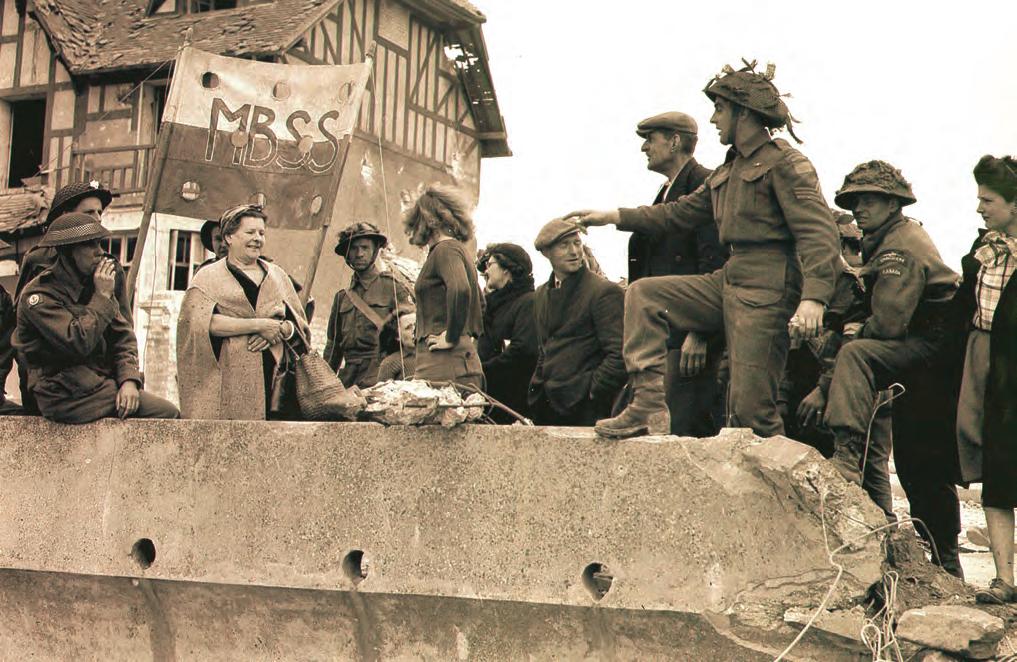
We replied, ‘Long live France!’”

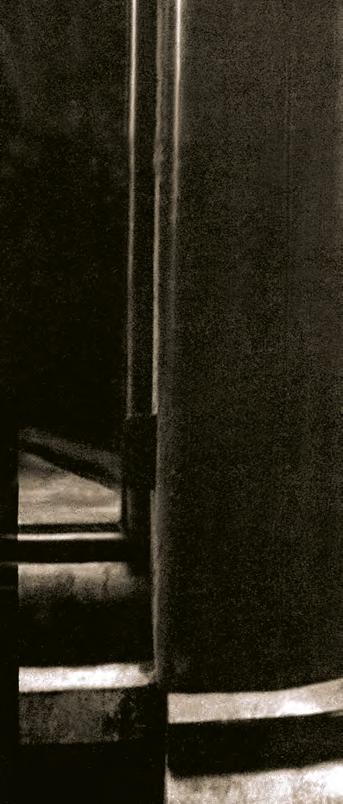
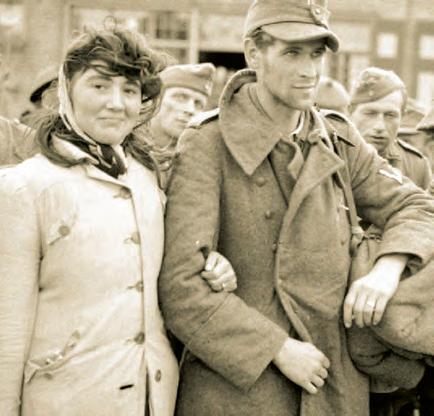

One comment that recurred several times in censor reports was troubling, however. Soldiers reported French girls as young as 14 to middle-aged women of 45, in civilian clothes and sometimes wearing German uniforms, sniping at them from trees.
One soldier wrote that in the latter part of June one woman “got five boys before we got her. It was a woman, 19 years old and married to a German, and there is a lot like that. She was shot while trying to escape from the Prisoner of War cage. She killed one of the boys… before one of the guys shot her.”
“You have to watch the French civvies as well as the Germans—they will shoot you in the back as soon as look at you—girls too,” complained another Canadian. “They have married Germans and tell you to your face they wish you had stayed away.”
Historians have doubted such accounts, but there seems little question they were true.
There were, of course, other kinds of relations. Jock Colville, one of Winston Churchill’s private secretaries, had joined the RAF. In his diary, he noted that at an airfield near Bayeux, France, the brothels had been ordered to shut down.
“Military police were posted to ensure that the order was obeyed. Undeterred and unabashed, several of the deprived ladies presented themselves in a field adjoining our orchard. Lines of airmen, including, I regret to say, the worthy Roman Catholic French Canadians, queued for their services, clutching such articles as tins of sardines for payment.”
As that suggested, Canadians had urgent needs, and ample supplies of food and cigarettes that could be used as trade goods.
That didn’t prevent looting, however, particularly of fresh food. One officer in Le Régiment de la Chaudière remembered that one of his men “came along one day
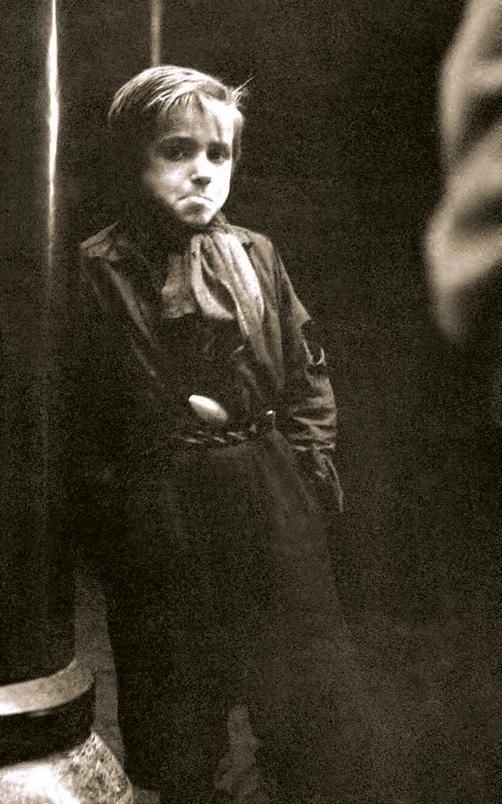
with his steel helmet full of eggs and three or four bottles of wine in his arms. He ran into a French woman and she said to him, ‘My god, have the Canadians come here to save us or to steal from us?’”
This also happened in Belgium, which the Canadians first entered early in September 1944 as they fought well-trained Germans trying to prevent the clearing of the Scheldt estuary. As the fighting moved on, the black market flourished, not least from Canadians trafficking in foodstuffs or equipment.
Privates, lowest on the modest wartime pay scale, could get handfuls of Belgian francs for a jerry can of gasoline or a battledress uniform, and there were reports of prostitutes making “nice winter coats out of blankets, and warm dresses or coats for their children.”
Still, the Belgians were better regarded than the French.
“I think Belgium bests them all,” William Hollett of The Lincoln and
A child waits outside a Netherlands restaurant during the 1944-45 “Hunger Winter” famine hoping for a handout. Infantrymen of Le Régiment de la Chaudière speak with civilians in Bernières-sur-Mer, France, on D-Day. A Dutch woman marches with her German soldier husband to a prisoner-of-war camp.
Welland Regiment wrote to his father.
“They are well fed, well clothed and the cleanest people I ever saw,” a common opinion among Canadians.
“The girls all over Belgium are so pretty as any I’ve seen,” Hollett continued.
Meanwhile, Geoff Turpin from an armoured regiment was invited to one family’s home, where “we sat & ate grapes & drank wine & Pernod & Bols until my eyes almost popped out & had a wonderful evening.”
An RCAF airman wrote that he had been to Brussels and Antwerp and found both expensive, but interesting. He added, however, not joking at all, “they can’t compare with Toronto.”
Sergeant Hugh Swinton, a gunner who had served in Italy, meanwhile, said of his local billet that “it is certainly a treat to be among such people after all these months of mud and filth.”
Arillery Major Elmer Bell wrote that, “There are some collaborators among the Belgians, but the underground has been cleaning these fairly efficiently.
“All Europeans are strictly business,” Bell continued, “and in money dealings they figure we are all rich and therefore fair game. So, we generally pay through the nose for anything we buy.”
By February 1945, relations between locals and their liberators were getting testy.
One soldier complained that “I am getting more and more fed up with the Belgian people in general,
they only seem to be able to moan. Why don’t they do a bit more themselves instead of sitting down and criticizing everything…they should be very grateful indeed to have come out of the war at such low cost. Life in Belgium is paradise compared to Holland, and you don’t hear half as much grumbling over discontentment over here.”
Part of the difficulty was that the Belgian government that had been in exile in Britain was slow to take hold of the reins following the liberation. Moreover, the resistance movements were sharply divided in their politics and unhappy with the exiled leaders.
This inevitably caused problems for the Canadian and British civil affairs officers trying to get the economy going and safely house refugees. In Antwerp, its port vital for Allied supplies, the difficulty was in keeping dock workers on the job, rather than sending them to safety.
Nothing, however, compared to the problems in the Netherlands where the Germans had starved the population, especially in the large cities, and flooded much of the countryside to slow the Allied advance.
“It is very sad to see so many undernourished and poorly dressed children,” one Canadian signaller wrote. “The people are really in need, the Germans have robbed the country.”
Another infantryman wrote from a small village near Arnhem that, “I thanked my stars, my home was in Canada. The people have no culture and are so far behind in their ways.”
After the Scheldt had been opened to Allied shipping, Major Bell wrote again to say, “The civvies here are very good to us and it is a wonder too…I wouldn’t think we would appreciate two hundred soldiers quartered around our house and barn.”
And once the Germans surrendered and the Canadian convoys moved into the north of the country, the Dutch eagerly awaited the arrival of their liberators. “I saw a tank in the distance, with one soldier’s head above it, and the blood drained out of my body, and I thought ‘Here comes liberation,’” said one local woman. “I had no breath left, and the soldier stood up and he was like a saint.
“There was a big hush over all the people, and it was suddenly broken by a big scream, as if it was out of the earth. And the people climbed on the tank, and took the soldier out, and they were crying.”
John Gray, an intelligence officer, was one of the first Canadians to enter Rotterdam in the war’s dying days. He and his driver had eaten their lunch, and he noticed a dozen or so men around his jeep.
“As I was about to climb in I saw the cardboard box with the remains of our lunch—sandwiches and pie,” he said. Was the food of any use, he asked one man who “stared at me incredulously—any use? He climbed onto the bonnet of the jeep and began to break the sandwiches into little bits and to give each man
a small handful…all had something, relishing it, smacking their lips.”
For many of the Dutch, Gray wrote, “the very taste of liberty remained for a long time a mouthful of good bread or pastry such as they had almost forgotten.”
The Canadians brought food, joy, and freedom, and the Dutch were grateful.
It didn’t take long before problems began to arise, however. Cigarettes, available free and in quantity for Canadians, were avidly sought after by the Dutch and became the favoured currency. A soldier could trade a few smokes for a camera, jewellery or sex.
Food, coal, gasoline, clothing, vehicles and, in fact, almost everything which the Canadians had was needed by the civilians. The black market took whatever the soldiers could offer, and the Canadians took the girls, too, infuriating Dutch soldiers, fathers and the religious, who worried that
venereal diseases and illegitimate children would be the only results.
They were right to worry. The rates of sexually transmitted infections among soldiers were high and, 70 years after the war, organizations still existed in Holland to seek “Tom from Toronto,” the embodiment of the soldier who had fathered a child in 1946, then left mother and child behind to return to Canada.
Many soldiers, some 1,900 in all, married their Dutch sweethearts, however. Brigadier J.A. Roberts, commander of the 8th Canadian Infantry Brigade, fell in love with the widow of a Dutch airman executed by the Nazis. He returned home to divorce his wife, then married the Dutch woman and brought her to Canada.
Amsterdam became the favoured spot for leave. The story of Stanley Winfield, a young RCAF airman, was typical of the liberators’ experiences. Winfield had been serving in Germany since VE-Day, where non-fraternization was still in force.
Rifleman R.M. Douglas of The Royal Winnipeg Rifles is mobbed by Dutch women celebrating the liberation of the city of Deventer in April 1945. A Canadian soldier hands out cigarettes to locals in Gooi, Netherlands, in May. Valuable artworks are moved to a secret bunker.



The Dutch city had accommodation reserved for servicemen, and the army obligingly provided a map showing locations of clubs, cabarets and dances. He and a friend quickly found two Dutch girls who, “became our companions for the entire three days, and we partook of movies, swimming, dancing and even horseback riding. Expenses for the whole time,” said Winfield, “cost us 1,000 cigarettes a piece, which we sold on arrival at two guilder per cigarette.”
Then there was art. Many soldiers become avid looters, ripping paintings off walls and shipping them back to Canada. This happened often enough that Queen Wilhelmina of the Netherlands complained to General Guy Simonds. He cracked down hard.
But not all art was stolen. Lieutenant-Colonel Gerald Levenston, a staff officer at Simonds’ headquarters, became friendly with the curator of the Kröller-Müller Museum in Otterlo. A cache of 260 paintings, including some 100 works by Vincent van Gogh, had been hidden from the Nazis in a cave, and the curator asked Levenston to help get them back to the museum. Persuading soldiers to volunteer and securing

Cigarettes became the favoured currency. A soldier could trade a few smokes for a camera, jewellery or sex.
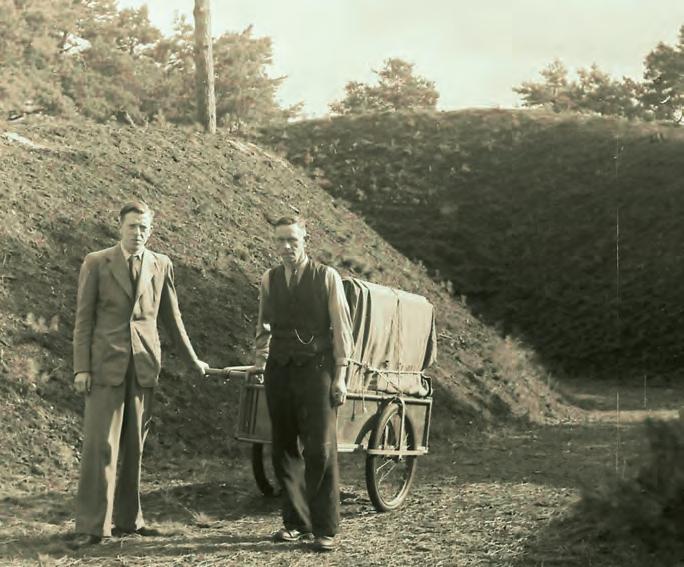
some trucks, he did so. Fifteen years later, Levenston, by then a successful businessman in Toronto, had connections at the Royal Ontario Museum, and he was instrumental in arranging an exhibition of van Gogh’s work there. The Canadians were liberators in France, Belgium and Holland, but they were also men who had
survived the war’s bloodbath and seized every chance to enjoy life. The civilians, human too, were almost all grateful, but many had been eager to gain advantage with the troops. Inevitably, tensions arose, but over the years, the memory of the difficulties dissolved and largely gratitude remained. It still does. L

SECOND WORLD WAR
BOMBS AWAY
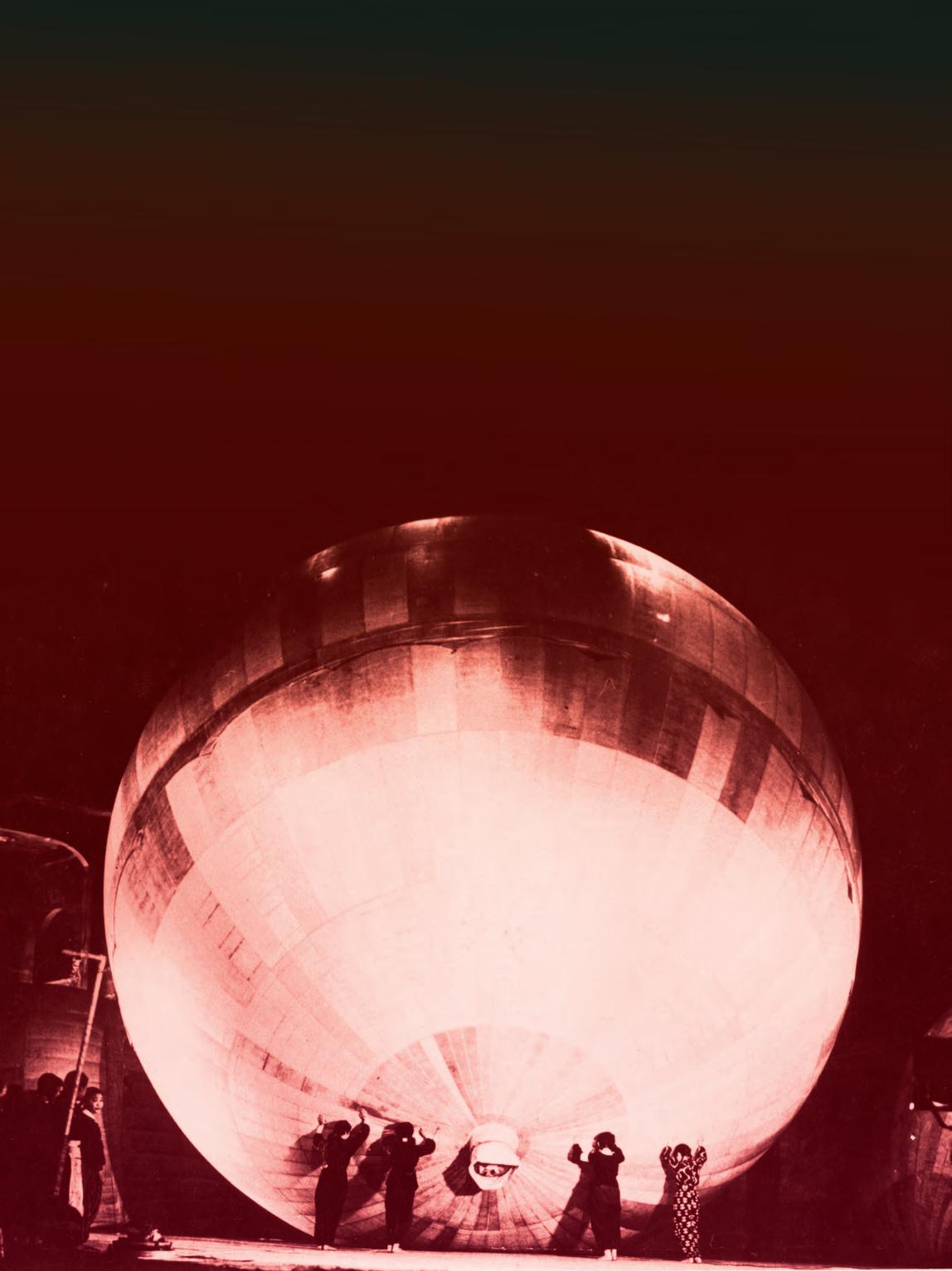
THE WILD STORY OF JAPANESE BALLOON BOMBS FLOATED OVER NORTH AMERICA


Captain Charles A. East, a bomb disposal officer of the Royal Canadian Engineers, stared at the enemy ordnance through binoculars.
All seemed still in the Cedarvale, B.C., wilderness, save for the frosted breath of Corporal W.V.L. (Smitty) Smith, an outdoorsmanturned-explosives expert.
East studied the strange object draped between three trees, its paper canvas creating a vast canopy akin to a “monstrous
form of mushroom.” From the fungus-like form, a maze of ropes trailed down to a chandelier-like structure—itself an elaborate array of equipment attached to a platform—on which hung 12 sandbags. Between those, most importantly, dangled two bombs.
That the contraption appeared largely intact suggested an electrical fault. Not only was the payload designed to start forest fires, which had clearly not happened in the early 1945 snow, but an additional
“chandelier” of a WW II-era Japanese

flash bomb should have destroyed
East pocketed his binoculars, as unassured of the duo’s safety as when their Indigenous guide had first discovered the weapon more than an hour earlier. He would have to assess the crash site even closer.
Traipsing forward cautiously, East examined the debris strewn across the ground. Among the wreckage was an empty, broken battery box.
Just as the officer began theorizing, the heel of one of his snowshoes snagged underfoot. East bent down and, with gloved hands, dug the protruding object out from the drift. It was then that a “cold chill ran up my back.”
The potential for Japan’s balloon bomb menace, an ingenious if futile attempt to foster chaos beyond North American shores, predated the war itself.
Starting around 1926, Japanese meteorologist Wasaburo Oishi began researching wind. The rudimentary data, at that time widely ignored by most other countries’ scientists, suggested the existence of the since well-known jet stream.
This high-altitude, west-eastflowing air current opened a genuine corridor of possibilities. During the 1930s, Japan’s military tried capitalizing on it.
Several imperial projects, including with balloons, showed promise, although they focused on experimentation rather than practical implementation. That changed in April 1942 following the U.S. Doolittle Raid on Tokyo.
With Japan proven vulnerable to American air attacks, the country’s prime minister, Hideki Tojo, sought retaliation. In response, Japanese scientists renewed efforts to create a lethally efficient balloon capable of crossing the Pacific Ocean.
Drafting schoolgirls for much of the hard labour, the result was the Fu-Go program managed by
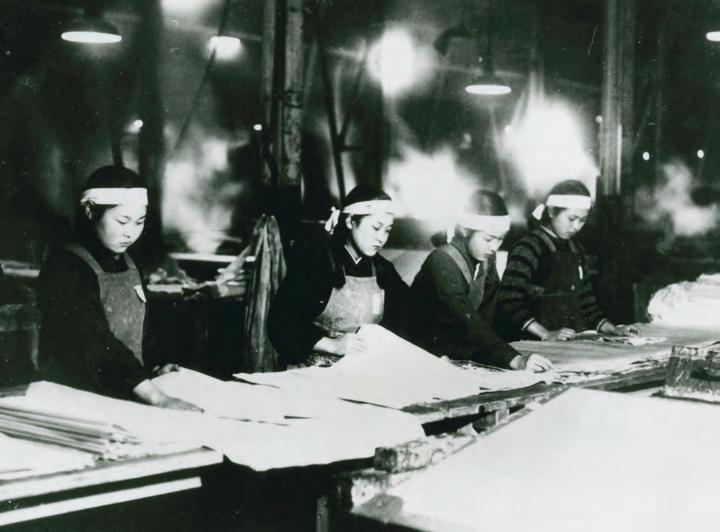
the Special Balloon Regiment. The students, operating out of converted schoolrooms or transferred to factories, helped craft the weapons with paper made from the kozo tree. A relative of mulberry, the lightweight material enabled crude and inexpensive construction. Ultimately, the balloons measured about 10 metres in diameter, within which were some 538 cubic metres of hydrogen. The equipment-laden chandelier, attached via shroud lines, hung beneath the inflated vessel—the same sort that Captain East would soon confront in a B.C. forest.

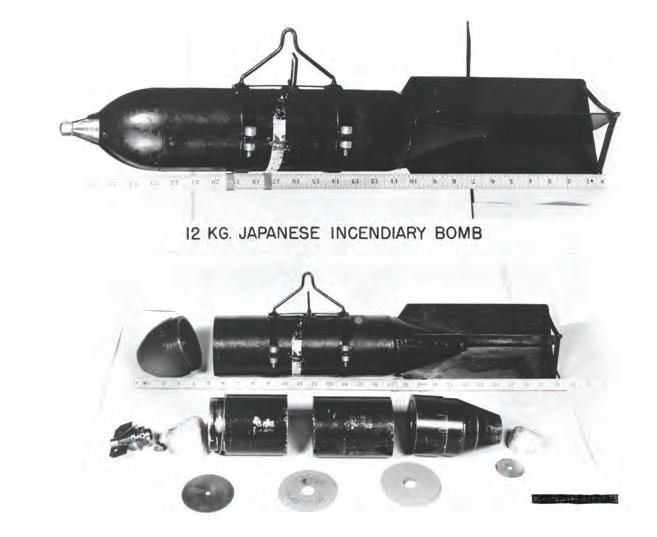
In its undamaged state, however, the platform carried 32 ballast sandbags and a barometric control device. The latter instrument— positioned alongside other apparatuses—ensured that if the balloon descended too low, sandbags would be released to regain the necessary altitude, thereby increasing its chances of reaching North America. The process would be repeated until arrival.
After crossing some 7,000 kilometres of open ocean in three to four days, a balloon would drop its ordnance at calculated intervals above the intended target area. The payload typically comprised four 4.5-kilogram incendiaries, a 15-kilogram highexplosive bomb, and flash bombs to destroy the entire Fu-Go once it had completed its mission.
The design was inspired, but far from foolproof. Among its flaws, the ballast-dropping mechanism often seized when subjected to fluctuating temperatures en route. Despite the battery being encased
Japanese schoolgirls work on assembling parts for the balloon bombs (top), which typically carried four incendiary bombs (left). Officials recover remnants of a downed device in Saskatchewan.
in a protective plastic box filled with antifreeze, the solution was found to be too weak for the job.
Perhaps unsurprisingly, combined with additional blueprint shortcomings and environmental factors, Japanese scientists would record mixed results.
Overall, the Fu-Go program manufactured 9,000-10,000 balloons. Of those, a mere 10 per cent—approximately 900—reached their destination before the Japanese ceased the operation in April 1945. Many of the balloons developed faults, such as freezing, and plunged harmlessly into the sea.
Nevertheless, 900 deadly balloons remained a considerable number—and an appreciable threat. They may even have caused noticeable damage, too, had there not been one final, and most fatal, flaw in the plan.
The Special Balloon Regiment released its first weapons in late 1944, taking advantage of the seasonal jet stream. Unfortunately— at least for imperial scientists— that same period coincided with seasonal wet weather in North America. The chances of starting forest fires, therefore, were minor.
Yet, try they did. On Nov. 4, 1944, a U.S. naval vessel recovered a Fu-Go off San Pedro, Calif. Another eight were identified by the year’s end.
Canadians endured their own experience of the supposed Fu-Go terror starting on Jan. 1, 1945. Rather than a spectre looming over the coastal wilderness— though that would come—the first retrieval took place outside Stony Rapids, Sask., a hamlet in the province’s far north.
It would be one of at least 80 of the balloons found in Canada, including distant sightings, partial recoveries, and, in what could be deemed a best-case scenario, incidents where a mostly intact balloon could be salvaged and analyzed.
Jan. 12 was an especially fruitful day for intelligence staff when an almost-complete Fu-Go was seized in Minton, Sask., some 150 kilometres due south of Regina near the U.S. border. Snagged on a barbed wire fence, the balloon still carried some of its undetonated bombs and ballast bags.
The discovery not only advanced understanding of Japan’s tactical objectives, but also helped pinpoint the precise origin of the enemy weapon. Canadian and American scientists studied the sand in the weights, finding microscopic marine fossils endemic to the eastern shore of the Japanese island of Honshu.
Of course, it was one thing to hone in on likely launch sites—and, in doing so, rule out the theorized use of Japanese submarines in their release.
It was quite another thing to actually combat the balloons.
Royal Canadian Air Force Flying Officer Edward E. (Maxie) Maxwell would meet the challenge. Soaring through the skies near Chilliwack, B.C., in a Curtiss P-40 Kittyhawk scrambled from RCAF Station
Japanese scientists renewed efforts to create a lethally efficient balloon
capable of crossing the Pacific Ocean.
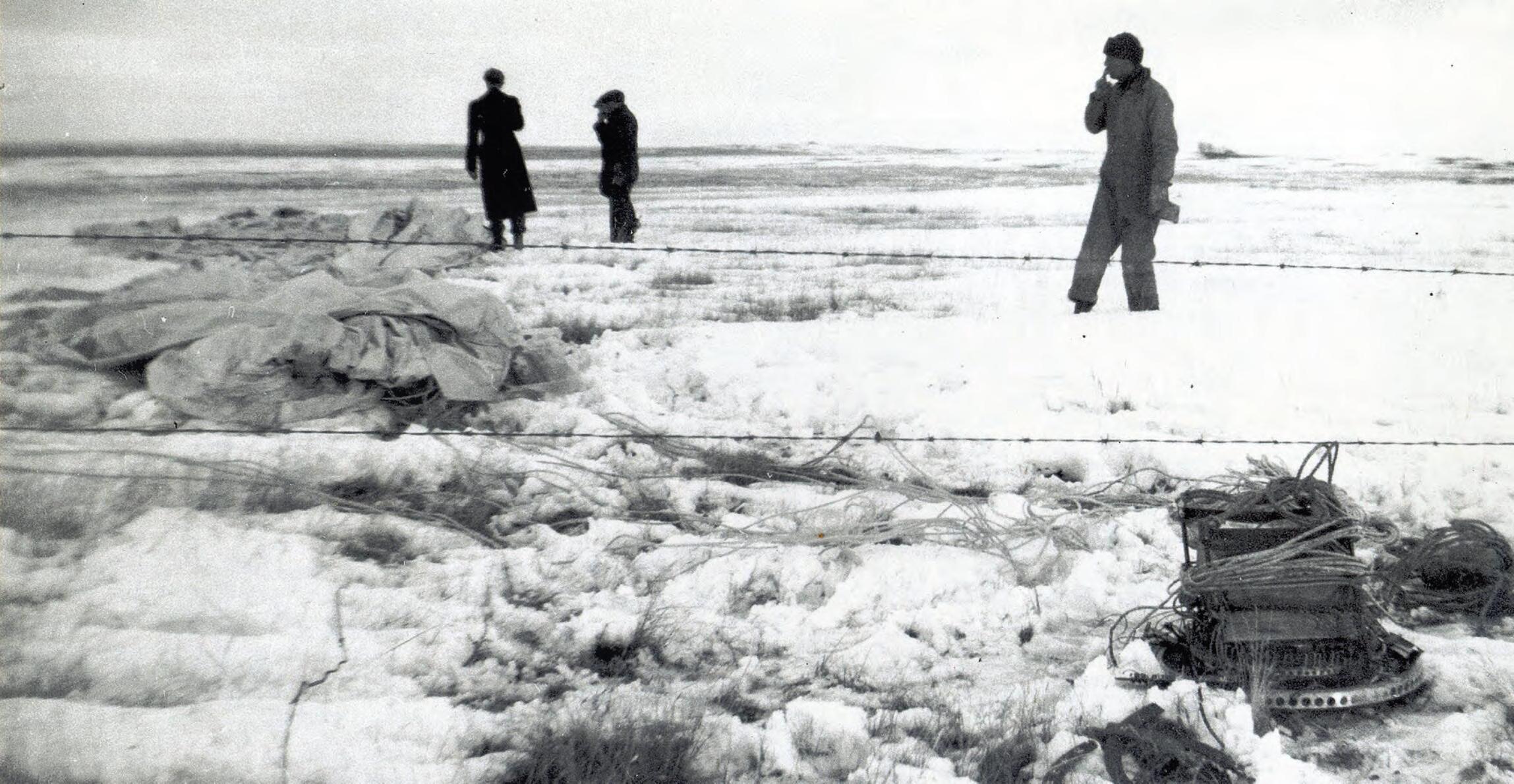

Patricia Bay, the 133 (Fighter) Squadron pilot spied his target. It was Feb. 21, 1945, and Maxwell’s task—as part of the Western Air Command (WAC) response—was to eliminate the Fu-Go threat in a timely, safe and efficient manner. Rarely had it been that simple, however, as balloons straddling 9,000 metres (30,000 feet) were difficult to reach. Then there was the fact that the aircraft at WAC’s disposal possessed no night interception ability, and that shooting down a balloon in an inopportune location could cause more harm than good.
Aside from pushing his Kittyhawk close to its altitude limits, conditions appeared favourable to Maxwell and his wingman Bert Webber.
The Fu-Go—codenamed Blue Paper when in flight and White Paper in the event it reached the ground—would still need to be brought down without damaging its explosive cargo, no easy feat at the best of times.
Webber, writing 40 years later, recalled: “Maxie and I split up and took turns [attacking] (about three or four passes each, firing about 3-4 second bursts). After about 10 minutes it was evident that we had punctured it to the degree that it was descending quite rapidly (probably about 500 to 1,000 feet per minute).”
Together with Webber’s critical assistance, Flying Officer Maxwell would be credited with Canada’s first “paper kill.” It would not be the last.
On March 10, 1945—roughly when Japan’s balloon campaign was beginning to peak—another 133 Squadron pilot achieved a second paper kill. Flying Officer James G. Patten intercepted the balloon at 4,100 metres (13,500 feet) near Ganges Harbour on B.C.’s Salt Spring Island, shooting it down with his wingman. The Fu-Go exploded in a reddish flash before its appendages landed in the water.
Flight Lieutenant Russel L. Moodie, piloting a PBY Canso of 6 (Bomber Reconnaissance) Squadron alongside his crew, received credit for a third and final confirmed Blue Paper takedown on March 12. Returning from an anti-submarine patrol near Coal Harbour, B.C., he spotted a partially deflated Fu-Go at a low altitude. Moodie used his slipstream to bring it down further, at which point it became entangled in trees outside Rupert Arm.
Once a device had been recoded from Blue Paper to White Paper— be it through WAC interception or Japanese miscalculation—responsibility was transferred to the army, whose duties were to find, disable and recover any remnants. The Pacific Coast Militia Rangers, largely consisting of First World War and even Boer War veterans, played an outsized role in spotting and tracking balloons, while the RCMP co-ordinated local law enforcement efforts in securing crash sites. Finally, the Royal
Some reports, meanwhile, turned out to be domestic devices, as well as one noteworthy incident where, on June 11, 1945, a Kittyhawk from 135 Squadron shot down an American balloon. Others were arguably more farcical in nature.
As early as February 1945 and rolling into the summer months, RCAF sorties attempted an impossible feat in their defence against the Fu-Go threat: battling the planet Venus, the daylight brightness of which confused air personnel.
In one diary entry, a 133 Squadron member perfectly expressed the immense frustration felt by many, writing on July 2: “Three scrambles again today, two of them chasing planets again. Surely someone at control should know sufficient astro navigation to plot the visible planets in the day time and not scramble 40,000' ceiling Mosquitos thousands of light-years up.”
More seriously, between January and May 1945 some of the greatest
The Fu-Go would still need to be brought down without damaging its explosive cargo, no easy feat at the best of times.
Canadian Navy assumed jurisdiction over weapons found at sea.
Canada’s defensive procedures were thus broadly effective, although they, like the balloons themselves, were prone to the occasional mistake.
Namely, after the Japanese campaign ended in April 1945— ironically on the cusp of the drier season—false sightings prompted needless scrambles.

challenges stemmed from censorship of the North American press. On the one hand, the media blackout had largely prevented Japanese authorities from gathering intelligence, leaving them to question the program’s success. On the other, limited information had impeded civilians’ ability to accurately identify and report balloon sightings. Worse, on May 5, a downed Fu-Go claimed its first six victims near
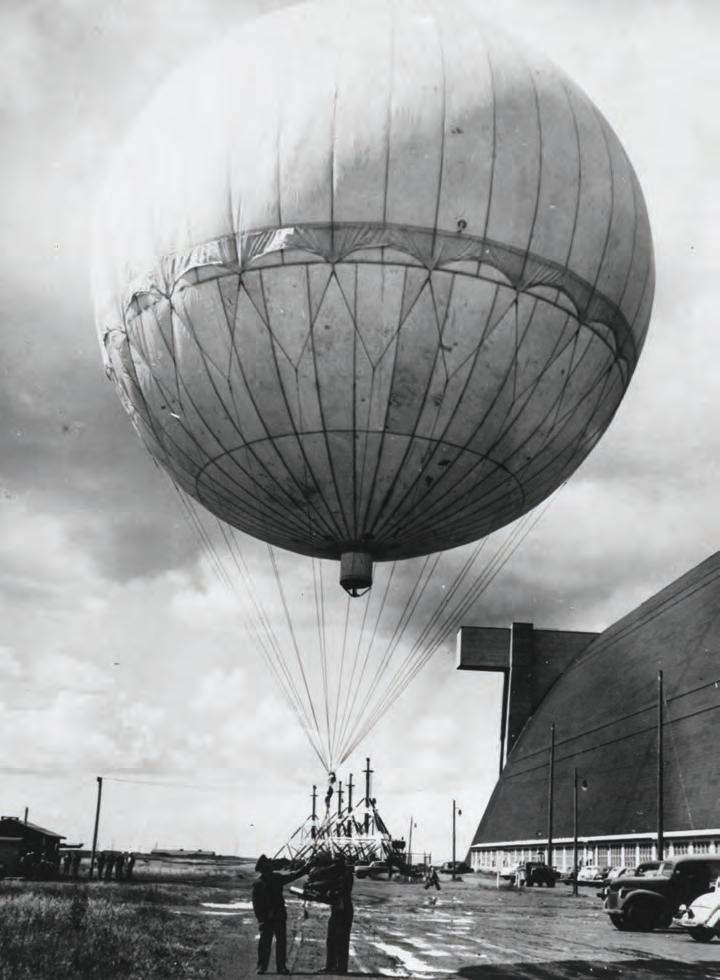
Bly, Ore., resulting in an eventual policy U-turn for safety reasons.
The tragic deaths of 26-year-old Elsie Mitchell—who was pregnant— and five children under her care, showed that the balloons, though widely considered ineffective, could still leave significant destruction in their wake.
Back in the snow-covered forest near Cedarvale, B.C., in early 1945, these same considerations ran through the mind of Captain Charles A. East.
The bomb beneath East’s foot was an anti-personnel type, designed to kill those within a compact blast range. On that cold day, isolated and almost
entirely alone, the Canadian engineer wondered if it would be him.
East’s face turned pale once it dawned on him that he, and by extension his comrades, had endured the closest of close calls.
He had been lucky, but was not out of the woods yet.
After a night spent at their base camp, he and colleague Smith began securing the crash site. Smith climbed a tree to dislodge the chandelier. As bomb disposal officer, East stayed on the ground and examined the explosives, including the one that had almost cost him his life.
It would nearly cost him again— on more than one occasion.
Military officials in California re-inflate a Japanese balloon bomb recovered in early 1945 to learn more about the new weapon.

During the defusing process, East inadvertently triggered the arming
vanes, which then spun four times. A fifth could have caused the bomb to detonate. Equally hair-raising was when Smith, aloft in a different tree, knocked a small branch out onto the ordnance, prompting East to temporarily run for cover.
At the most critical juncture, acutely aware he had had one too many close shaves, East gripped the bomb with his left arm against his ribs. “If I’m going to go,” he said to a sheltering Smith, “I don’t want to leave any pieces lying around.”
Thankfully, he had had his last near-death experience.
East carried out his duties—often plagued by false reports—until mid-October 1945, later writing in his 1993 memoir, White Paper: Japanese Balloons of World War Two, that “not one of us sustained so much as a cut finger.” The six American dead were the only confirmed fatalities caused by a Fu-Go.
Yet there remains a degree of risk even today with 80-year-old balloons still being unearthed in remote pockets of Canada and the U.S. One such instance occurred close to Lumby, B.C., in 2014 when two forestry workers discovered a device half-buried in the Monashee Mountains. Bomb disposal experts, deeming it unsafe to move, subsequently detonated it in situ.
Nor have rival foreign powers ceased using balloons for nefarious motives. Indeed, as recently as February 2023, China launched a somewhat similar—albeit unarmed—apparatus into North American airspace for surveillance purposes, sparking condemnation from Canadian and U.S. authorities.
The controversy served as a figurative blast from the past for some. Had the now-late Charles A. East bore witness, it might have evoked more. L

By Ted Barris
First
call

THE ROYAL AIR FORCE’S ALL-CANADIAN 242 SQUADRON FINALLY GETS INTO ACTION. AN EXCLUSIVE EXCERPT FROM BATTLE OF BRITAIN: CANADIAN AIRMEN IN THEIR FINEST HOUR
Asthe crow flies, RAF Coltishall, home of 242 (Canadian) Squadron. RAF, sat just 120 kilometres from most of the Luftwaffe’s key Adlerangriff (Eagle Attack) targets in Britain. Within 30 minutes of a scramble, Squadron Leader Douglas Bader (the RAF’s famous legless fighter pilot) and his dozen Hurricanes could take off, climb to 15,000 feet [4,572 metres], and confront German bombers inbound for London over the Thames Estuary.
But as Air Chief Marshal Hugh Dowding had laid out in his defensive alignment, 242’s first obligation was to defend RAF fighter stations and factories in England’s industrial heart north of London in the 12 Group sector. He gave his squadrons in 11 Group sector the responsibility for defending sites from the City of London itself south and east to the English Channel.

Members of 242 (Canadian) Squadron, Royal Air Force, including Squadron Leader Douglas Bader (fourth from right) in 1940.
Day after day in August 1940, while Bader and his pilots all sat in Coltishall’s dispersal hut at readiness, burning to get into the fight, the phone never rang. Day after day, German bombers and their fighter escorts seemed to overwhelm the RAF defenders just a few minutes’ flying time to the south. Bader even called up Air Vice Marshal Trafford Leigh-Mallory, the officer commanding 12 Group, requesting permission to scramble in order to back up his sister squadrons in 11 Group’s airspace.
“We can’t put all our eggs in one basket,” Leigh-Mallory told Bader.
When the Battle of Britain had intensified back in July, Dowding had steadfastly believed that spreading his 52 fighter squadrons more thinly across 10, 11, 12 and 13 Group sectors implied he could defend more sites.
That meant that RAF squadrons, with just 12 or so fighters per squadron, would take off and climb to challenge as many as 100 or 200 Luftwaffe bombers all at once. Dowding admitted that such impossible odds meant some bombers inevitably would get through, but if his squadronsspread-thin strategy worked, each enemy bomber formation harassed by RAF fighters would inflict less-concentrated damage.
Bader nevertheless pleaded with LeighMallory to let him bolster 11 Group fighter numbers over its sector covering the airspace over London and southeast to the Channel, thus giving his 242 Hurricanes their baptism of fire and their first crack at the waves of German raiders.
“I can’t send you in until 11 Group calls for you,” Leigh-Mallory answered Bader. Meanwhile, the downtime at Coltishall allowed newly arriving Canadians to settle into the station. They familiarized themselves with the new upgraded Hurricanes and adopted Bader’s coiled sense of readiness for when an actual scramble call came for 242.
Pilot Officer Lawrence Cryderman, a former schoolteacher from Toronto who had joined the RAF in 1939, had little experience as a fighter pilot, but made up for it with his virtuosity on the piano when the squadron pilots gathered in the mess for beer and bawdy singsongs. Also limited in combat experience, PO Norris Hart from Montreal, came to RAF Coltishall in mid-July. He’d only been commissioned on July 7; but having been an instructor in civilian aviation, Hart was a quick learner. He was shipped off to an operational training unit and was back on 242’s flight line within a month.
Late in July, Flying Officer George Christie from Westmount, Quebec, arrived;

Bader pleaded to get his 242 Hurricanes their baptism of fire and their first crack at the waves of German raiders.
he was fresh from his high-altitude photo reconnaissance experience in Spitfires with 212 Squadron RAF (that service would earn him a Distinguished Flying Cross).
PO Hugh Tamblyn, a former aircraft mechanic from Watrous, Sask., joined the squadron on August 5; he had combat experience flying Defiants with 141 Squadron RAF.
Following Tamblyn came FO John Cave from Calgary. And then late in August, PO Pat Sclanders arrived. The former barnstormer and commercial pilot from Saint John, N.B., had run the gamut thus far in the war—from attempting to serve as mercenary in both the Finnish and Norwegian air forces, to volunteering for the French Air Force, but eventually having to flee France as its defences collapsed in the spring of 1940. Sclanders settled into the routine at 242 on Aug. 26, a few days before the idleness and false starts at Coltishall station came to an abrupt end.
On the morning of Aug. 30, 1940—the 51st day of the Battle of Britain—the dispersal hut phone finally rang. No. 242 received orders to scramble and fly to RAF Duxford, right on the boundary line between 11 and 12 Group sectors north of London. Whooping and hollering, Bader and his Canadian pilots launched in minutes, but halfway there, their sortie was aborted. At midday, however, the squadron was again ordered to fly to Duxford. They’d barely landed there and were eating sandwiches next to their Hurricanes when its dispersal hut phone rang.
“Angels 15,” the voice on the other end said, directing 242 Squadron to climb to 15,000 feet [4,572 metres]. “North Weald.”
In minutes, 14 Hurricanes were airborne, headed into 11 Group air space over RAF North Weald station with Bader in the lead. He flicked on his radio telephone switch and spoke to the controller Alfred (Woodie) Woodhall: “Laycock red leader,” he announced into the radio mouthpiece. “Am airborne.”
“Vector one-nine-zero,” directed the Duxford controller. And he punctuated the transmission with the word “Buster,” calling for full throttle to get his fighters there as quickly as possible. Then, so that Bader knew what he’d be facing, the controller added, “70-plus bandits approaching North Weald.”
As 242’s fighters climbed steadily into battle formation, in vics (V formations) of three, line astern, Bader splayed a map out on his thigh in the cockpit. He deduced the enemy bombers and fighters would be approaching North Weald from the southwest, right where the sun was situated. So, Bader ignored the controller’s vectoring straight to North Weald. He turned the squadron west. He might end up missing the enemy stream completely, but he’d attempt to get his fighters up into an advantageous altitude coming, out of the sun, before the Luftwaffe escorts did the same. Bader sent FO Christie and Green section toward North Weald. His hunch was bang on.
“[There’s] a vast number,” Christie radioed back to Bader, “of twin-engine Me 110s escorting bombers, 70 or 80 of them at 12,000-14,000 feet, heading toward the RAF station.” Above them, another swarm up to 20,000 feet [6,096 metres].
“Green section, take the top lot,” Bader directed.
Christie climbed up to starboard with his two wingmates toward a swarm of Me 110s. Christie challenged one of them head-on— a risky manoeuvre since each 110 fighter housed two cannons and four machine guns in its nose section. He must have surprised the German pilot because the 110 abruptly broke from its formation to escape.
Given his high-altitude experience, flying Spitfires alone in photo reconnaissance, Christie made sure none of the other 110s was chasing him, and closed to within 50 yards [46 metres] of his quarry. He fired bursts of shells that hit the 110’s fuel tank, which exploded, and the fighter-bomber fell into a vertical dive and went straight into the ground. Christie’s wingmate, PO Hart, dived at three Heinkel bombers. One veered away but Hart chased a second, fired and saw it crash in flames.
Black section, which had carried out tailend Charlie duties, keeping German fighters off the rear of the squadron, caught up to the enemy formation under siege. PO Noel Stansfeld found another Heinkel 111 straggling behind the main stream of bombers.

On his first pass he fired at the rear gun position and watched its response.
“[It] was twinkling like a flashlight on and off,” Stansfeld reported later. But none of the German gunner’s shells connected with his oncoming Hurricane. On the Canadian’s next pass, he started a fire in the port engine; and eventually the bomber crashed into a civilian airfield.
Meanwhile, SL Bader had ordered his Red and Yellow sections to formate on him, line astern and he aimed his Hurricane at the heart of a line of Dornier bombers and their Messerschmitt escorts. The 110s scattered in a fan-like fashion, three to port, three to starboard, and Bader immediately latched onto one of them, firing into its wing roots; the plane burst into flames and heeled over. Above to the right, Bader chased another 110 and got it, too.
As outstanding a day as 242’s Canadian pilots seemed to be having, FO Willie McKnight, flying as Bader’s wingmate, was outdoing everyone in the squadron. The irascible Edmontonian, whom his friend Stan Turner had described as “absolutely fearless,” was proving all of that.
“At [5:05 p.m. spotted] enemy a/c [aircraft] in vic formation and stepped from 12,000-18,000 feet,” his combat report read. Attacked middle section of 110s.”
Just as his fellow fighter pilots had been doing these past few minutes, McKnight managed to pull in behind one of the fighter-bombers and he “opened fire at approximately 100 yards. Enemy a/c burst into flames and dived towards ground.”
Next, McKnight found a formation of Heinkel bombers, picked out one and, this time firing at right angles into the side of the bomber, struck its port engine from 150 yards away. It burst into flames, the plane rolled on its back and fell away. Then McKnight came under attack from an Me 110, but manoeuvred to get behind him.
“Followed him from 10,000 feet to 1,000 feet,” he reported. “Enemy a/c used very steep turns for evasive action, but finally straightened out. I opened fire at approximately 30 yards. Enemy’s starboard engine stopped and port engine burst into flames. Enemy crashed in flames alongside large reservoir.” McKnight had his hat trick for the day.
Within the hour, McKnight and all 13 of his squadron comrades landed safely back at RAF Duxford. Not a single Hurricane
had been damaged in the engagement. Not a single bomb had fallen on North Weald. Between takeoff at 4:23 p.m. and landing at 5:35 p.m., 242 Fighter Squadron pilots had accumulated 12 confirmed kills, and of half of the dozen came at the hands of the Canadian pilots: one for Christie, one for Hart, one for Stansfeld, and three for McKnight. The latter felt pretty chuffed at the day’s scores.
“We’ve either killed all their real good pilots and they’re using new young ones, or else they are losing their nerve,” McKnight wrote a friend in Edmonton. “They haven’t got the same guts they used to have, and except in a few cases try to avoid a real scrap.”
Overall on Aug. 30, 1940, RAF Fighter Command had logged 1,054 sorties, an unprecedented number. Some squadrons got all their fighters airborne four times in daylight hours, and almost all squadrons in the action, including 242, flew at least two sorties in the day.
The Canadian pilots of 242 were showered with plenty of praise for their performance. Air Vice Marshal Leigh-Mallory offered applause “on a first class show.”
Then, Chief of the Air Staff Cyril Newall sent a congratulatory message to the squadron. “You are well on top of the enemy,” Newall gushed, “and obviously the fine Canadian traditions of the last war are safe in your hands.” L

Excerpted from Battle of Britain: Canadian Airmen in Their Finest Hour by Ted Barris. Published by Sutherland House Books. Reproduced by arrangement with the author.
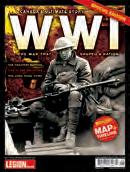
WW I: The war that shaped a nation It was supposed to be the war to end all wars but the Great War was the most brutal era in Canadian history.
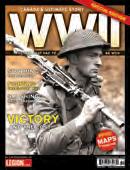
WW II: The war that had to be won
The cost was high, but the war that had to be won was a victory in every sense.

Twenty-five great Canadian aviators
From early birds to astronauts, every one of these nationally celebrated and lesser-known flyers has made important contributions to Canada’s aviation heritage.

The Royals: The fight to rule Canada
Everything you need to know about Canada’s royal heritage from the earliest kings and queens who dispatched explorers to the New World to the modern British monarchy.
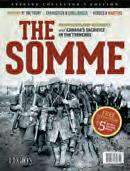
The Somme The Somme examines the role of the Newfoundland Regiment and the Canadian Expeditionary Force in the First World War battle that took place in France from July 1 to Nov. 18, 1916.

World War I: True stories from Vimy to victory
More compelling stories from the First World War are told in memoirs by surviving Canadian soldiers.
Bringing the stories of Canada to life like never before

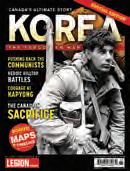
Korea:
The forgotten war
Korea: The forgotten war sheds light on the third major war of the 20th century. Includes archival images, a timeline and five maps.
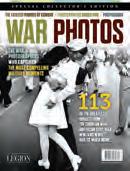
War Photos
War Photos showcases the stunning images and rare photos from the men and women who went into battle with only a camera.

Victoria Cross
The most famous decoration for courage in the Western world, the Victoria Cross has been awarded to dozens of Canadians and the lore behind the VC is sprinkled with strange and heart-wrenching stories.

War Stories: True stories from the First World War
When the First World War started in 1914, Canada’s population was less than 8 million, yet more than 620,000 enlisted. Many of the surviving soldiers share their stories in this special issue.
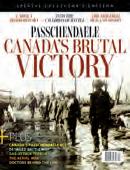
Passchendaele: Canada’s brutal victory
The Canadian Corps was thrust into a battlefield of mud and craters to help Allied forces in the Battle of Passchendaele— Canada’s third major victory of 1917.
*Conditions apply. 40% off select back issues expires December 31, 2024.
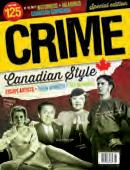
Crime: Canadian style
Take a trip to Canada’s seedy underbelly and meet the perpetrators of some of the country’s most notorious felonies and misdemeanors.

Liberating Normandy: The road to victory
The Battle of Normandy was the beginning of the end of the Second World War in Northwest Europe.

Battle of the Pacific: Courage in the Far East Canada’s war in the Pacific began on Dec. 7, 1941, when Japanese aircraft attacked the U.S. navy base at Pearl Harbor, Hawaii.
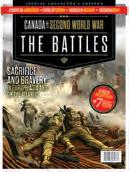
Canada and the Second World War:
The battles Canadians played pivotal roles in many of the most important and costly conflicts of the Second World War. Includes large battle map.
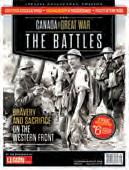
Canada and the Great War:
The battles
From Ypres in April 1915 through to the Hundred Days campaign, Canadian soldiers experienced one fierce ground battle after another.

O Canada: The history of our home and native land
O Canada tells our story from First Peoples through to our achievements in space.
Intro by Canadian comedian and author Rick Mercer.

The march to victory: Canada’s final 100 days of the Great War
The Canadian Corps fought several great battles before Germany surrendered, ending “the war to end all wars.”
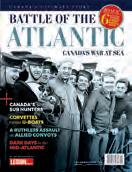
Battle of the Atlantic
The Royal Canadian Navy played a pivotal role in this critical campaign, which raged on open and treacherous seas from September 1939 to May 1945.
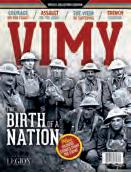
Vimy: The birth of a nation
The hard-fought WW I Battle of Vimy Ridge is sometimes called “the birth of the nation.” In April 1917, the Canadian Corps fought together for the first time and achieved success where others had failed.

O Canada: The best of everything
Find out what really makes our country tick. Packed with Canadian people, places, wildlife, cities, culture, feats and innovations.
Intro by Canadian comedian Ron James.
Canada’s Ultimate Story engages readers with captivating stories of Canadian events and fascinating people from our earliest days to present times and editions are filled with little-known facts and trivia relating to our great country.
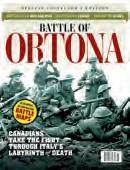
Battle of Ortona
Late in 1943, Canadian troops attacked the German-held Italian city of Ortona. In fierce fighting, Canada pushed up Italy’s east coast and prevailed.
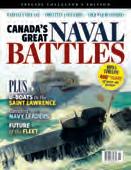
Canada’s great naval battles
The sea brought explorers, colonizers and navies from Europe to North America—as well as rivalries and wars. Join naval historian Marc Milner as he retraces Canada’s history—all from a nautical perspective.

O Canada: Greatest Canadians
Whether artists or scientists, athletes or social activists, writers, explorers or innovators, greatness elevates us all. The greatest Canadians have come from all across this vast and beautiful country—all leaving their indelible mark on Canada.

D-Day: The free world fights back It was the spring of 1944 and the Allies could not wait any longer. British, American and Canadian forces would land on five beaches on France’s Normandy coast in the early hours of June 6, 1944.

Canada and the brutal battles of the Somme
The Battle of the Somme lasted 141 days, from July 1 to Nov. 18, 1916. For the Canadian Corps, the Somme was a coming of age, setting the stage for their seminal victories to follow.
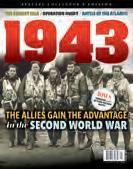
1943: The Allies gain the advantage in the Second World War
By 1943, Canada’s role and influence in the Second World War has so far been limited but with the invasion of Sicily, shifting fortunes in the Battle of the Atlantic and bombing successes over Germany, that is about to change.

O Canada:
Discover your land Big land, bigger oceans, huge mountains, wide waterways and wildlife wilderness—Canada offers breathtaking vistas in every direction. Intro by Canadian comedian Cathy Jones.

Canada and the Great War: Liberation In the final five weeks of the First World War, Canadian soldiers liberated more than 200 cities, towns and villages in France. “They were so glad to see us,” said one Canadian soldier, “they wept with joy.”
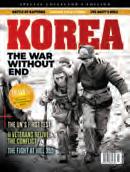
Korea: The war without end Communist troops of the North Korean People’s Army attack the South on June 25, 1950. For three years, Canadians fight battles on land, sea and in the air; 516 die and when the killing is over, the more than 26,000 survivors spend years fighting for recognition.

John McCrae and the Battles of Flanders
John McCrae was shaken by the battlefield death of a friend in May 1915, and wrote the poem “In Flanders Fields” in tribute. The poem remains today a renowned symbol of remembrance.
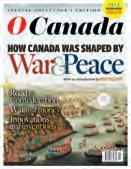
O Canada: How Canada was shaped by war and peace
Since the First Peoples arrived on this continent, the place that would be called Canada has been shaped by conflict and co-operation.

Operation Husky: The Allies take Sicily
On July 10, 1943, Canadian, British and American forces invade Sicily, a hot, mountainous, enemyoccupied island off Italy’s south coast. The Allied liberation of the continent has begun.
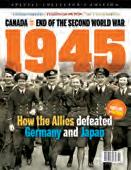
1945: Canada and the end of the Second World War
The year 1945 started with a massive German bomber attack on Allied airfields. But the Allies soon pushed back and Canadian troops led the advance into the Netherlands. The end-game was at hand.

How Canada conquered Vimy Ridge
The Great War had been raging for nearly three years by the time the Canadian Corps captured Vimy Ridge in April 1917. This important battle is a defining moment for Canadian troops.
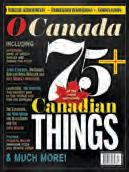
O Canada: 75+ of the most genuinely Canadian things
From the quirky to the revolutionary, Canadians take pride in distinctly Canadian people, places and things.

Canada and the Scheldt Campaign
As Allied armies fight their way through France, supply lines are stretched thin. The tools of war must travel from Normandy to a front that’s moving farther from the D-Day beaches by the moment. The Belgian port at Antwerp offers the solution the Allies need.
The port is taken. But to get supplies into Antwerp, Allied ships have to navigate the Scheldt which is controlled by the enemy. The Canadians are given the job of driving the Germans out.

Defining Battles of the War of 1812
British and American warships exchanged the first shots of the War of 1812 and for two-and-a-half years, the two sides waged war. The Americans thought taking Canada would be a cakewalk. It wasn’t.
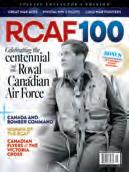
RCAF 100: Celebrating the centennial of the Royal Canadian Air Force
The Royal Canadian Air Force emerges from 100 years as a respected protector and humanitarian presence in troubled skies the world over. The story is one of passion, promise and perseverance.

Battle of the St. Lawrence: U-boats attack It is 1942, and the U-boat war that has been raging in the North Atlantic spills into the Gulf of St. Lawrence and onto the river itself. For the first time since the War of 1812, lives are lost to hostile action in Canadian waters.
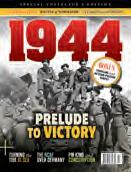
1944: Prelude to victory
The year 1944 begins well for the Allies after German defeats in Stalingrad, North Africa and Sicily. The war is far from over, but the Axis is clearly losing at last. It is time to strike what will prove to be the decisive blow in Europe.



Prime Minister Mackenzie King shares a private moment with his Irish terrier Pat.
By J.L. Granatstein
There is no doubt that Mackenzie King was an interesting man. Case in point: Canada’s longest serving prime minister visited mediums to attempt to communicate with the dead, a roster that included political leaders, old friends and his mother. He apparently received reassurance more than advice and, as a bachelor without a partner to rely on for feedback, he needed it.
King was also obsessive, noting that the hands of the clock were together (or apart) when he made decisions and paying attention to the shapes he saw in his shaving cream or tea leaves in his cup. His succession of Irish terriers (all named Pat) were caressed, cossetted and revered. He kept a diary for more than 50 years, and this too filled the role of confidante, his way of indicating what he had done or, even more important, prevented each day.
But King wasn’t crazy. He was elected Liberal leader in 1919 in part because he had been loyal to Wilfrid Laurier during the debate about conscription during the Great War. That mattered with Franco-Quebecers.
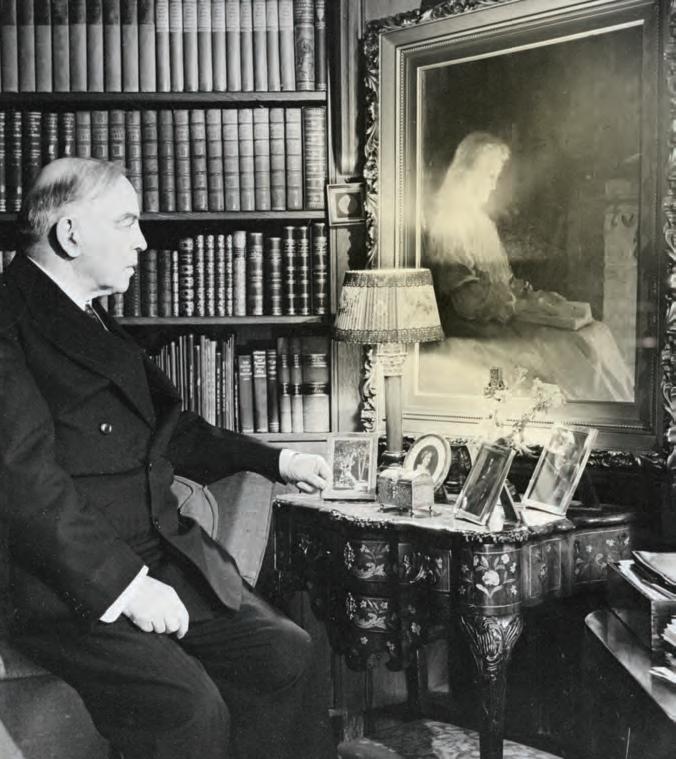
And he had written a book, the almost unreadable (and little read) Industry and Humanity, which made him an expert on the social unrest sweeping Canada after the First World War in the eyes of convention delegates.
Then, King won the 1921 election, narrowly lost four years later, but took power again in 1926. He was ousted in 1930, saddling the Conservatives with governing during the worst years of the Great Depression, but became prime minister again in 1935. King may not have had great charisma or a record of significant accomplishments for Canada, but he was a winner. When the Germans invaded Poland at the beginning of September 1939 and Britain declared war on Sept. 3, King knew that Canada had to join the fight. He had, however, promised that
“Parliament would decide,” and the country, while still a dominion of the British Empire, controlled its own foreign policy, thanks to the 1931 Statute of Westminster. So, Canada was not at war—yet. Parliament did decide, and the country joined the conflict on Sept. 10. The delay, the pledges that this would be a war of “limited liability,” and that there would be no conscription for overseas service was significant, especially in Quebec, where most were not enthusiastic about fighting.
King’s policy, however, had made francophones willing to acquiesce to Canada becoming a belligerent, something most Anglo-Canadians wanted. National unity mattered to King and his Liberal party. He handily won re-election in March 1940 with 51 per cent of the popular vote and 179 of 245 seats in the House of Commons.
King gazes at a portrait of his late mother, whom he attempted to communicate with through a medium.

His wartime cabinet was strong, with powerful ministers given freedom to run their departments. Clarence (C.D.) Howe controlled wartime production. Ernest Lapointe was the Quebec lieutenant and, after his death in late 1941, Louis St. Laurent stepped into that role, and served as justice minister. Colonel J. Layton Ralston, a distinguished infantry officer during the First World War, led the Defence Department from 1940 to late 1944. James L. Ilsley was a capable finance minister, and Jimmy Gardiner oversaw agriculture.
And King’s key civil servants— Graham Towers at the Bank of Canada, Arnold Heeney in the Privy Council Office, Oscar D. Skelton and Norman Robertson at External Affairs, and Clifford Clark at Finance—provided the ideas that shaped the war effort. And transformed Canada forever.
But if limited liability had been King’s plan, it soon went out the window.
The Nazis invaded Denmark and Norway in April 1940, then the Low Countries and France in May. By early June, Britain was on the verge of defeat. The 1st Canadian Division in England was nearly the only equipped, though partially
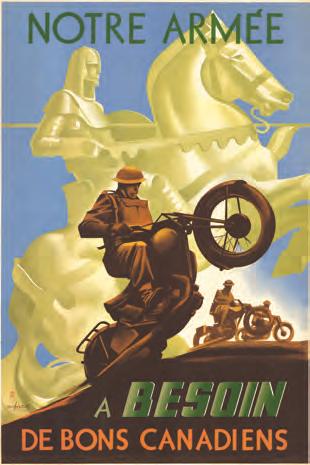
trained, force to resist what most saw as an inevitable German invasion of the island. The Canadian war effort now had to change.
Home defence conscription was enacted by the National Resources Mobilization Act in June 1940 and the first call-ups reported for duty in October. The navy sent everything it had overseas, the Royal Canadian Air Force deployed its few squadrons and the British Commonwealth Air Training Plan hastened its work. The army stepped up recruiting, creating battalions, brigades and divisions as fast as it could. Money, scarce during the Depression and tight in 1939-40, was now no object, and Canadian war industries ramped up to make everything from trucks and guns to ships and aircraft.
King poses with members of his cabinet in September 1939. Conscription, an issue largely divided along English-French lines, was one of the PM’s greatest wartime challenges.
King and American President Franklin D. Roosevelt also made deals. First, the Ogdensburg Agreement, struck in August 1940, created a joint Canada-U.S. defence plan. Then, the Hyde Park Declaration the next year guaranteed that the two countries would work together on wartime production, and that Canada wouldn’t run out of American dollars to purchase what it needed.
King personally negotiated these two treaties with FDR, with whom he was friendly. And they were vital.
By 1943, Canada had become a military power.
Before the war, there had been 10,000 regulars in the three services. Now, Canada had the First Canadian Army in Britain, squadrons of aircraft operating in every theatre of the war, and the Royal Canadian Navy was fighting U-boats and guarding convoys.
Meanwhile, factories and farms were producing massive amounts of armaments and food.
Wages and prices were tightly controlled, taxes were increasing annually, and Canadians, with jobs available for everyone at home, were buying savings bonds in record numbers to pay for all the materiel. It was a total war, directed by King’s government.
But to many, total war meant conscription for service overseas. Most Conservatives were pushing for it, and some Liberals (including a few in cabinet) were as well. In early 1942, the prime minister decided to call a plebiscite with a somewhat indirect question— “Are you in favour of releasing the Government from any obligations arising out of any past commitments restricting the methods of raising men for military service?”—that amounted to a yes or no to compulsory service.
In Quebec, a substantial majority said no; a similar preponderance in the rest of the country said yes. King, though, said maybe, uttering perhaps his most famous quote in Parliament on June 10: “Not necessarily conscription, but conscription if necessary.”
How would he define necessity? Early that year, casualties were relatively low, and the army was not yet in sustained action (except for the disaster in Hong Kong and the imminent debacle at Dieppe), so there was little credible case for compulsory service. But most expected the casualties would come, not least in the RCAF, which had aircrew flying bomber raids over Germany, and the RCN, fighting U-boats in the North Atlantic.
In mid-1943, 1st Division and an armoured brigade landed in Sicily; in September they joined in the invasion of Italy, soon augmented by the 5th Armoured Division. Fighting at Ortona at Christmas
King
was brutal, and the Italian Campaign ground slowly forward.
On June 6, 1944, the Allies invaded France, Canada’s 3rd Division and an armoured brigade played a critical role in the landings. During the next two months, the 2nd Infantry and 4th Armoured divisions entered the battle and casualties were heavy. Then the fighting to open the Scheldt estuary to ship traffic took place in October and into November, again with major losses. Some 5,000 were killed in Normandy and Canadians suffered another 6,000-plus casualties in the Scheldt fighting; Italy, too, was a drain on the infantry, with fierce combat needed to crack the Germans’ Hitler and Gothic lines. By the fall of 1944, there was a crisis at the front lines—and on the home front.
The reinforcement stream created by the military had been based on estimates of losses. The planners had expected
heavy infantry losses, as well as substantial numbers of support troop casualties from German air attacks. But, the Luftwaffe had essentially been driven from the skies and, so, there were more rear-area soldiers than needed, while infantrymen were in short supply. Where, the government asked its generals, could infantry be found? Only among the home defence troops was the answer.
King was horrified, believing the war to be almost won. Regardless, Defence Minister Ralston (and at least seven other ministers) were adamant that the home defence conscripts be sent overseas.
Brutally, King fired Ralston during a cabinet meeting, appointing General Andrew McNaughton in his place. The conscriptionist ministers sat stunned. McNaughton had led the army from 1939 to late 1943, and was not in favour of conscription. He set out to find volunteers among the home defence men—but failed.
King, though, said maybe, uttering perhaps his most famous quote in Parliament on June 10: “Not necessarily conscription, but conscription if necessary.”
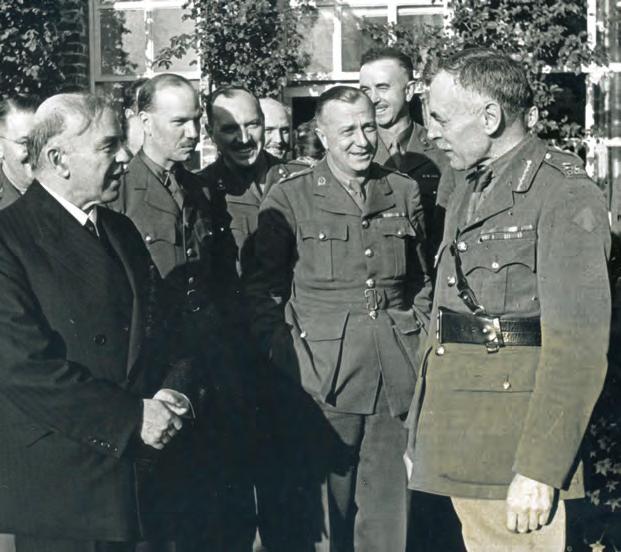
meets with General Andrew McNaughton and officers of the Royal Canadian Artillery in August 1941.


Soon, a few senior officers were speaking about the infantry shortages to the media, which King interpreted as signs of an emerging military revolt. He also sensed that he might lose the support of the pro-conscription ministers.
On Nov. 22, 1944, he flip-flopped, announcing that 16,000 conscripts, enough to meet the infantry need, would be deployed overseas. Equally important, King held his cabinet and caucus together, losing only Air Minister Charles G. Power. The political crisis was over—and a winter hiatus in the fighting gave the army time to recover and fill its ranks again.
With the conscription issue settled, King could move on other matters that were important to him. He believed in the creation of the welfare state, and with an election due in 1945, he believed that new programs could help him woo voters. His government had put unemployment insurance into effect in 1940, one step in the larger plan.
Veterans Affairs Minister Ian Mackenzie, meanwhile, had also been working on creating benefits for servicemen and servicewomen
The election victory was interpreted as recognition of King’s achievements in leading Canada to its astonishing war effort.
Family allowances were one of King’s top social welfare achievements.
and the Veterans Charter was ready to be unveiled. It offered everything from cash, clothing, education, training and land, to support to start a business and free medical care to those who had served. The initiative, vastly better than the treatment afforded Great War veterans, was as good as any plan for vets in the world, and far better than most. That women received equal treatment was also notable.
So too, was the fact that family allowances, the country’s first universal program, were paid directly to mothers. For some, the baby bonus was the only money that was theirs by right, and it won support across the country—although not to some Opposition critics who argued it would benefit Quebec’s large families and men who wouldn’t fight. Quebecers did tend to have large families, but the province’s military enlistment was some three times that of the First World War. Giving funds to mothers—the average payment per child was $5.94 (or about $100 today) per month—to spend on their children would help keep the economy going and help Canadian businesses and farmers, too.
King’s government was also preparing to deal with a much-feared postwar economic downturn. Canada’s gross national product had more than doubled during the conflict, but the end of munitions production and the return of men and women from overseas could have negatively impacted the gains.
Large sums were devoted to building homes for vets, to supporting agriculture, and to helping businesses convert production lines for peacetime manufacturing. At the same time, bureaucrats readied plans for large government projects that could employ thousands.
“You socialists have schemes,” one Liberal MP told a Co-operative Commonwealth Federation (CCF) friend, “but I have the bills right here in my pocket.”
King called an election for June 11, 1945, a month after VE-Day, while the war against Japan continued and Canada was preparing to commit forces to an invasion of the country. That led the Progressive Conservatives to call for conscription for the Pacific; the CCF, meanwhile, expected to do well with its socialist platform.
King, however, campaigned, as he said, “in terms, not of promise, but of performance.” His candidates urged voters to “finish the job,” and called for national unity and social security. The result was close, King securing a slim majority with 118 seats; the Conservatives had 66 and the CCF 28. The Liberals won most of the military vote, too.
The victory was interpreted as recognition of King’s achievements in leading Canada to its astonishing war effort. King had kept the country united where Robert Borden, the Great War prime minister, had not. The nation King led produced enormous results on the battlefields, at sea, in the air, and in home-front factories and farms.
King was a leader when it counted most. L
O Canada: Canada and the world
Exploring our global ties
War may have made Canada, but it didn’t define it. To the eyes of many, the Great White North is the great conciliator. The objective third party. The voice of reason. The peacekeeper. During the course of 157 years—and more—the country has nevertheless made enemies and become their friend, made friends and become their enemy, and navigated relationships through good times and bad. Now, Canada’s Ultimate Story explores some of these key connections, the impact Canada had on them and their impact on Canada.
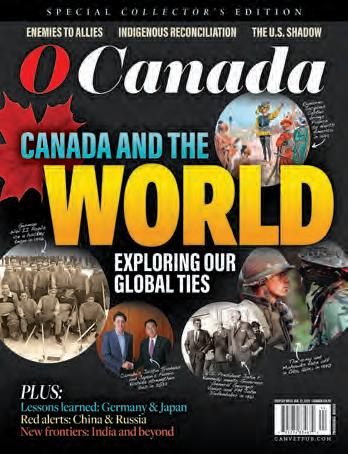
today at

In On War: Exploring Why and How We Fight, author Stephen J. Thorne, senior staff writer at Legion Magazine, draws on historical sources, veterans’ accounts, and his own experiences as a war correspondent and photojournalist as he explores conflict and war from multiple perspectives. Illustrated with some of the most profound conflict photography ever shot, On War is a unique and compelling read.
By STEPHEN J. THORNE


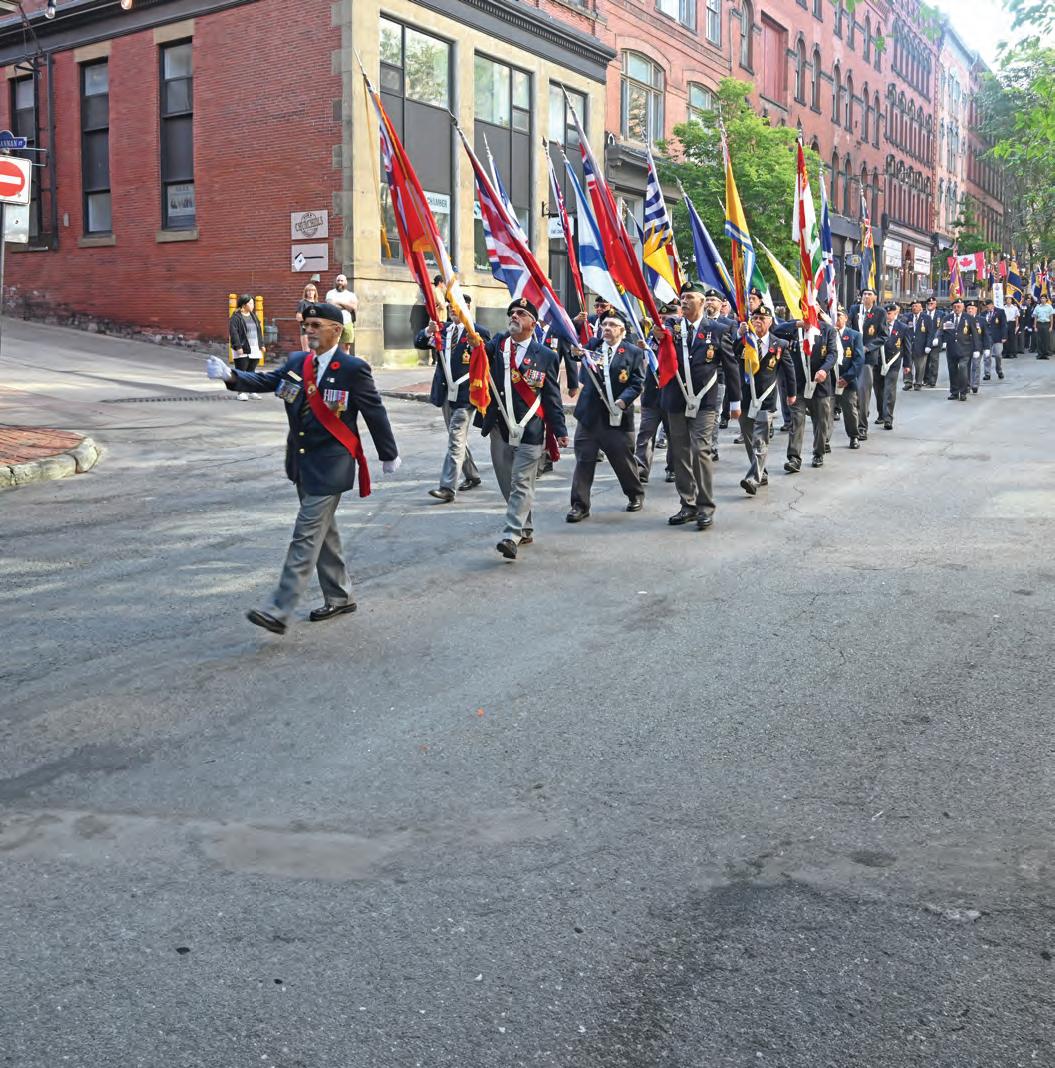
Moving toward 100
FROM TECHNOLOGICAL INNOVATION TO MEMBERSHIP
GROWTH AND
BEYOND, THE ROYAL CANADIAN LEGION SHOWS NO SIGN OF SLOWING DOWN AS IT APPROACHES ITS CENTENNIAL SAINT JOHN 2024
By Aaron Kylie
On
Legionnaires march toward Market Square in Saint John, N.B., (above and opposite left) prior to opening their 49th national convention.
Aug. 25-28, 742 accredited delegates assembled in Saint John, N.B., for The Royal Canadian Legion’s 49th Dominion Convention. They focused on volunteerism and service, all with the goal of supporting the country’s military and its veterans. The convention began informally on Saturday, Aug. 24, with
workshops and presentations, with Dominion Command hosting discussions on the national poppy campaign and the Legion’s poppy trademark, an introduction to the organization’s veterans’ services, a session on its path to 300,000 members, and dialogue about marketing and communication branch-support initiatives, while The Legion National Foundation, RCL’s charitable arm, shared details of its recent work.
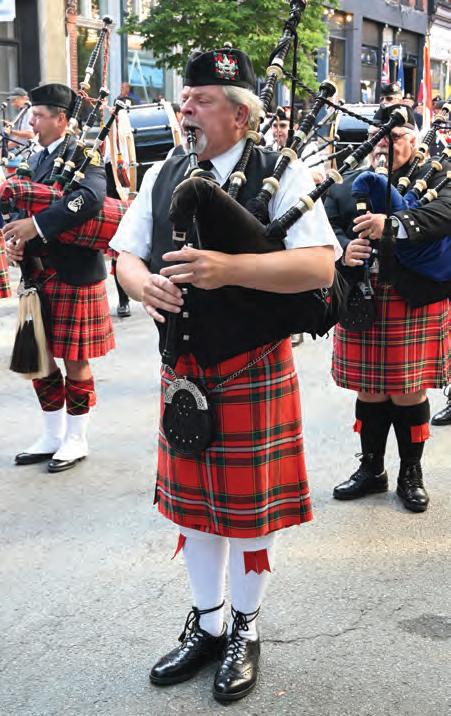
A wide range of exhibitors hosted booths on the mezzanine level at TD Station arena, the 6,000-plusseat home of the Québec Maritimes Junior Hockey League’s Saint John Sea Dogs. The convention itself was held on the arena floor.
The following morning, some 500 Legionnaires from across the country paraded from the intersection of Prince William and Princess streets to Market Square in front of Saint John City Hall. A short commemorative ceremony took place there.
After “O Canada,” “Last Post,” a moment of silence, “Lament” and “Rouse,” Dominion President Bruce Julian recited the “Act of Remembrance.” Chaplin Peter Gillies of the Legion’s N.B. Command delivered the invocation. Wreaths were placed by N.B. Lieutenant Governor Brenda L. Murphy, 2020-21 National Memorial (Silver) Cross Mother Debra Sullivan, MP Wayne Long on behalf of Veterans Affairs Canada, Chief Warrant Officer Bob McCann of the Canadian Armed Forces, RCMP Assistant Commissioner DeAnna Hill,
Dominion President Bruce Julian, New Brunswick
Lieutenant Governor Brenda L. Murphy and 100-year-old WW II veteran George Cooper review the parade.

Some 500 Legionnaires from across the country paraded to Market Square in front of Saint John City Hall.
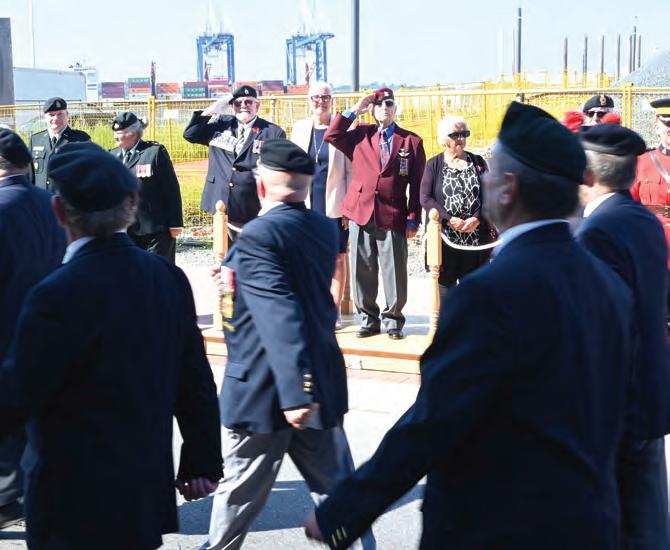

Saint Mary’s Band. After special guests and the Legion’s senior officers were piped in, Murphy provided welcoming remarks, as did Minister Wilson, Mayor Reardon and President Chevalier.
New Brunswick’s Minister of Service and minister responsible for military affairs Mary Wilson, Saint John Mayor Donna Noade Reardon, Julian on behalf of the RCL and N.B. Command President Antonin Chevalier. Gillies delivered the benediction before a rendition of “God save the King” concluded the ceremony. The Legionnaires then paraded down Water Street reviewed by LG Murphy and 100-year-old WW II veteran George Cooper.
The convention kicked off at noon at TD Station with an hour-long entertainment prelude featuring Before the Mast, a local a cappella folk and traditional group, and the community concert
Then Chair Bill Chafe officially opened the convention, noting he had three goals for the event: to successfully complete the business at hand; to ensure that delegates enjoy their experience; and to encourage attendees to acknowledge the hard work of the local arrangements committee led by Terry Campbell and represented on stage by the affable Bernier (Bernie) Cormier.
Grand President Larry Murray then addressed delegates in a video message.
“I’m really sorry that my ongoing medical treatment prevents me from being with you in person, nevertheless, I’m very grateful to have the opportunity to deliver my own remarks,” he said. “This is an important gathering. What really matters is the magnificent manner in which Legion branches and commands have provided
49
DOMINION CONVENTION
SAINT
JOHN 2024

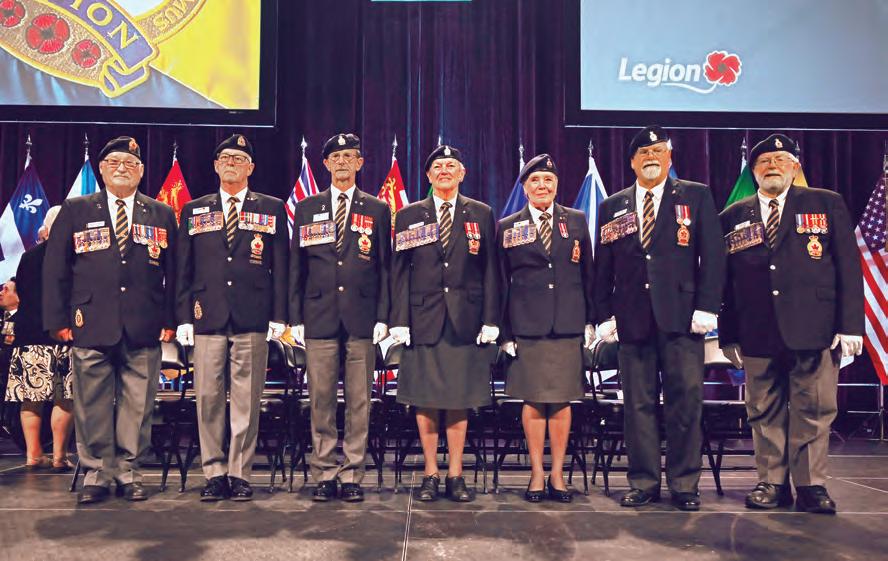
support to countless communities across the country.
“A critical initiative of the past year,” noted Murray, “included trying to establish the necessary foundation to improve equity, diversity and inclusion across the Legion. This important initiative is simply all about the creation of a commonsense Legion version of the golden rule: all of us simply need to try to treat others the way we would all like to be treated ourselves.
“Recent Legion history is impressive,” concluded Murray. “And you were, and are, a part of that story and should take considerable pride in that. You and The Royal Canadian Legion have been living the motto of this convention, building our future on a foundation of strength.”
President Julian addressed delegates next, detailing highlights of his three-year term. “At our last in-person dominion convention in 2018, you said yes to moving our organization forward with our new strategic plan. Since that time, we’ve seen incredible progress. And that’s despite pandemic shutdowns and challenges that were discussed at our virtual 2021 convention.”
Like Murray, Julian also noted the equity, diversity and inclusion initiative, as well as the Legion’s support of the Canadian Institute for Military and Veteran

“What really matters is the magnificent manner in which Legion branches and commands have provided support to countless communities across the country.”
Health Research, the success of the Legion’s Poppy Store, the support of young people through the Legion National Youth Track and Field Championships and partnerships such as the Burns Way, an innovative mental health resource for veterans, among many other achievements.
“I’m kind of proud to be at the helm during this time where we started to see the results and progress,” he continued. “In fact, I’d like to take all the credit, but you know that’s not true. It’s taken years of the leadership of many dominion presidents to achieve these results.”
Julian then acknowledged the past dominion presidents in attendance, including: Immediate Past President Tom Irvine; Allan Parks, the first associate member
elected to the role; Mary Ann Misfeldt, the first women to serve in the position; Jack Frost; Tom Eagles; and Dave Flannigan.
The convention’s first day ended with the start of the elections, which continued through days 2 and 3 amid guest speakers and committee reports. First introduced at the 2021 virtual convention out of necessity, delegates again voted electronically, this time through a dedicated smartphone/tablet app.
Thanks in large part to the tech, the event was largely paperless, with the app providing details on the agenda, caucus meetings, workshops, the convention book, the commemorative ceremony, local branch entertainment, guest speakers, exhibitors and more. The only paper materials were the daily updated procedure reports.
The 742 accredited delegates plus 2,283 proxies totalled a voting strength of 3,025. Delegates without an appropriate device for voting were loaned one, and there was technical support on hand to deal with any challenges voters had with the system. While about three dozen delegates required assistance on the first ballot, they were helped quickly, and fewer delegates needed guidance on each subsequent vote. The system was well received.
Julian was nominated for another term as president, but as is customary, he graciously declined.
First Vice President Berkley Lawrence of Carbonear, N.L., Branch and Vice-President Brian Weaver of Capt. Brien Branch in Wessex, Ont., were also nominated. Weaver declined and Lawrence was acclaimed as dominion president.
Vice-presidents Jack MacIsaac of Charlottetown Branch, Sharon McKeown of Pte. Joe Water Branch in Milton, Ont., and Weaver, along with three immediate past provincial command presidents—John Mahon of High River,
Alta., Branch, Ken Ouellet of Lacolle, Que., Branch, and Garry Pond of Carleton Place, Ont., Branch—were nominated for First Vice. On the fourth ballot, Mahon was elected.
MacIsaac, McKeown, Ouellet, Pond and Weaver were then included for three vice-president positions with other nominees: Valerie MacGregor of Powell River, B.C., Branch, incumbent Treasurer Donna McRury of Whitney Pier Branch in Sydney, N.S., and Steve Stamhuis of Leduc, Alta., Branch. McRury chose not to stand, while Weaver declined the nomination, noting that after serving the Legion for 50-plus-years it was time to step aside.
The newly elected Dominion Command executive (opposite), including President Berkley Lawrence, First Vice John Mahon, vice presidents Garry Pond, Sharon McKeown and Valerie MacGregor, Chair Bill Chafe and Immediate Past President Bruce Julian (Treasurer Jill Carleton was not present). Convention speakers included Veterans Affairs Minister Ginette Petitpas Taylor (below), Veterans Ombud Nishika Jardine (bottom left) and 2020-21 National Memorial (Silver) Cross Mother Debra Sullivan.
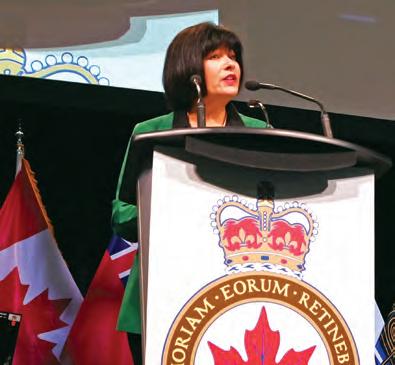

MacGregor, McKeown and Pond were tabbed.
McRury and Stamhuis were nominated for treasurer, as were B.C./Yukon Command President Craig Thompson of Crescent Branch in Surrey, B.C., and Jill Carleton of Perth-UponTay Branch in Perth, Ont. McRury again chose not to stand, and Carleton was elected.
Chafe of Sarnia, Ont., Branch was acclaimed for another term as chair.
Guest presentations and committee reports punctuated the voting process through the convention.
Veterans Affairs Minister Ginette Petitpas Taylor was one of the event’s keynote speakers, addressing delegates on the final day.
“I’ve heard that [the government] can do a better job of recognizing today’s veterans without losing sight of our past,” she noted. “On the 80th anniversary of D-Day, one of the striking moments was seeing the bond between Second World War veterans and younger veterans grow stronger. They exchanged stories and thanked each other for their service to Canada. That’s what I see as our core mission: to honour and support veterans who have served our country no matter when or where.
“Thanks to the strength and commitment of partners like you,” the minister told the Legionnaires, “we can reach and connect with veterans in every corner of the country.”
Other speakers included: CAF Chief Warrant Officer Bob McCann; Veterans Ombud Nishika Jardine; 2020-21 National Memorial (Silver) Cross Mother Debra Sullivan; Wounded Warriors Canada’s Director Health Services Phil Ralph; the Royal Commonwealth Ex-Services League’s Libby Watkins (who received $100,000-plus in donations from delegates on behalf of the Legion); and the Army Cadet League of Canada’s Robert Gill.


The Legion’s Pilgrimage of Remembrance guide John Goheen (left), retired master corporal Mike Trauner (right) and Dr. Ramesh Zacharias (below) all spoke at the convention. Newly elected President Lawrence addresses delegates (opposite).
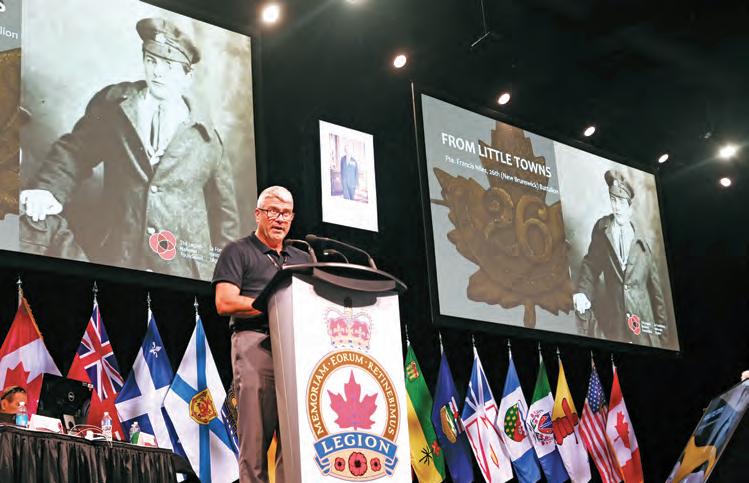
While all the guests were compelling, four were particularly noteworthy:
John MacBeth, founder of Trycycle Data Systems, shared details of The Burns Way, a new peer support digital chat platform that allows veterans to anonymously connect in real time, 24-7, with mental health advocates via smartphone or desktop browsers;
Retired master corporal Michael Trauner, an Invictus Games gold medallist, the Legion’s first-ever ambassador for its youth track and field championships and a veterans’ advocate, spoke candidly about his service in Afghanistan, including the improvised explosive device explosion in which he lost parts of both his legs;
Todd Ross of Rainbow Veterans of Canada related how his three years of service with the Canadian Armed Forces came to an abrupt end in May 1990 at the age of 21 during the country’s purge of 2SLGBTQ2+ from public service;
And Dr. Ramesh Zacharias, president, CEO and medical director of the Chronic Pain Centre of


“Thanks to the strength and commitment of partners like you, we can reach and connect with veterans in every corner of the country.”

Excellence for Canadian Veterans, discussed the connections between chronic pain and mental health. “One of the interesting things about the last 12 years of treating veterans,” related Dr. Zacharias, “is that you cannot separate the mental health issues from chronic pain. They’re two sides of the same coin. Sixty-two per cent of veterans with chronic pain have mental health issues. We can do better.”
Reports and related budgets, meanwhile, were presented by each committee chair, including Veterans, Service and Seniors; Poppy and Remembrance; Membership; Public Relations; Sports; Defence and Security; Rituals, Awards and Protocol; Constitution and Laws; Equity, Diversity and Inclusion; and others.
Dominion Treasurer McRury presented the financial statements, including the statement of revenue and expense. The 2023 year ended with net revenue of $954,652. Her presentation included a proposed $1.25 increase in the Dominion Command portion of the Legion membership fee. It garnered passionate discussion and was approved.
Later, delegates also adopted a $3 subscription increase (the first in 12 years) for Legion Magazine (included as part of the membership fee), after hearing it would otherwise immediately begin posting significant deficits
SAINT JOHN
and/or have to reduce size and f requency. The new annual subscription (as of January 2025) is $12.49, plus taxes.
Valerie MacGregor, chair of the membership committee, reported that, with pandemicrelated challenges now past, the 2018 strategic goal of 300,000 members is once again a realistic target. With recent advancements such as the 2021 launch of the Veterans Family Welcome Program, the 2022 introduction of digital membership cards and an automated renewal call campaign, member services continues to modernize and innovate.
The combined result?
Consecutive years of membership growth after years of decline. Total paid membership reached 243,638 in 2022, a 3.8 per cent year-over-year increase. In 2023, the total eclipsed 256,524, an additional 5.3 per cent increase over the previous year. Of note, too: new members joining online are from younger demographics: 15 per cent are 40 or younger, 21 per cent are 45 or younger and 30 per cent are 50 or younger.
“Our journey toward innovation and service excellence is a testament to the collective effort of our members, branches, and leadership,” said MacGregor in her report. “We are confident in our path of sustained membership growth and broader impact.”
Two years away from its 100th anniversary, the Legion has a century of impact to celebrate. John Mahon, chair of the Centenary Committee, updated delegates on the organization’s plans to recognize the milestone, which include a centenary medal, a short documentary, special merchandise, an exhibit at the
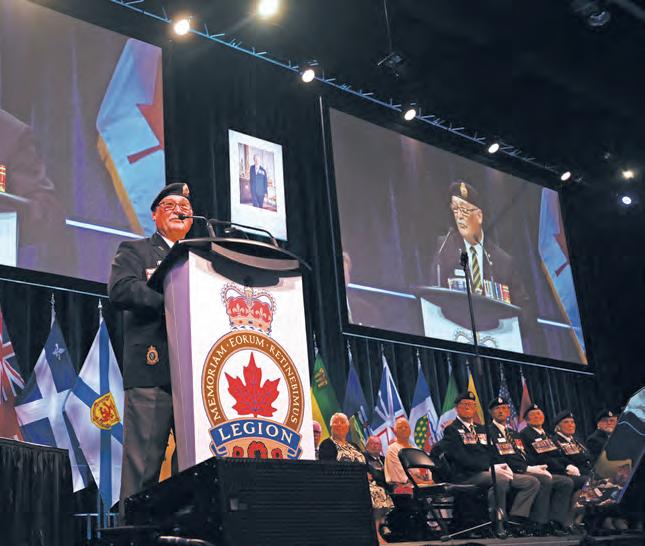
Canadian War Museum, a gala event, an official commemorative coin and stamp and more.
Six committee resolutions— operational and advocacy-related— were carried, while all but one of 10 resolutions returned to the floor for discussion by provincial commands were defeated. The brought-back resolution that was carried related to altering the Legion’s online membership portal.
A couple of special award presentations punctuated the proceedings as well. First, Ron Goebel, chair of Ontario Command and serving as the deputy chair at the convention, presented President Julian and Chair Chafe each with the Sovereign’s Medal for Volunteers, which recognizes the exceptional volunteer achievements of Canadians.
Both were honoured not only for their longstanding work with the Legion, but with a range of other organizations and initiatives.
And, in one of his last acts as president, Julian bestowed the Legion’s Presidential Citation on his successor Lawrence, for his years of behind-the-scenes work to repatriate an unknown Newfoundland WW I soldier from France to a tomb at the Newfoundland National War Memorial in St. John’s. The project came to fruition this past July 1 on the monument’s centennial.
With business completed, Past President Mary Ann Misfeldt installed the newly elected officers.
“This is quite an honour,” said new Dominion President Lawrence in his inaugural address. “When I joined the Legion 20 years ago, I never thought that I would be your president.
“When I first thought about running for dominion president, I thought I would be doing this in Winnipeg [Aug. 22-26, 2026] at the 100th anniversary and I had this great line to open my speech. I was going to say, ‘it took the Legion 100 years to find the perfect president.’ But you did so good you did it in 98,” he joked.
“Our membership is growing, and I thank the membership chairs at all the branches who help us get to the numbers we’re at. You guys do an incredible job. To have increases two years in a row is absolutely amazing.
“I can’t thank [delegates] enough for the acceptance of the equity, diversity and inclusion program,” Lawrence also noted. “It shows that you are willing to work with dominion command to let the public know that the Legion is an open and welcome society. We don’t turn anybody away.
“I’m proud of the work our organization has achieved to date, and I look forward to more positive growth as we continue to focus on the needs of our veterans.” L
DOMINION CONVENTION th
SAINT JOHN 2024

At the helm
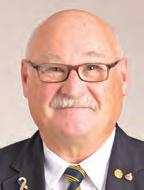
DOMINION PRESIDENT Berkley Lawrence, 71, is a member of Carbonear, N.L., Branch and has spent 21 years with the Legion. He served in the Royal Canadian Corps of Signals for 33 years and has served at every level of the Legion, rising to president of Newfoundland and Labrador Command in 2017. At the national level, he has served as chair of the local arrangements committee for the 2016 dominion convention in St. John’s, the poppy and remembrance, and the equity, diversity and inclusion (EDI) committees, vice-chair of the veterans, service and seniors, and dominion convention resolution committees, and as a member of the Royal Commonwealth Ex-Services League (RCEL) and going forward committees, as ex-officio on the centenary committee and is also the former chair of Canvet Publications. Lawrence is currently chair of the veterans, service and seniors, going forward and the Royal Commonwealth Ex-Services League committees and vice-chair of the veterans consultation assembly. He is the recipient of the Special Service Medal with NATO bar, the Canadian Peacekeeping Service Medal, Non-Article 5 Medal for Operations in the Balkans, Queen Elizabeth II Diamond Jubilee Medal and the Canadian Forces Decoration with two bars. Lawrence was also named male volunteer of the year in 2022 for Carbonear. He enjoys travel and outdoor activities such as fishing, hunting and ATV riding. In addition to his work with the Legion, he is a supporter of Meals on Wheels. Berkley and his wife Sarah have three children— David, Michael and Teri—and six grandchildren.

FIRST VICE John Mahon, 68, is a member of the High River, Alta., Branch. He joined the Canadian Armed Forces in 1973 and served for 34 years. After his release he was Garrison Wainwright senior manager, personnel support programs, until his retirement in 2018. Mahon was president of Worthington Branch in Wainwright, Alta., and held senior positions on the Alberta-N.W.T. Command executive, ultimately serving as president for three years. He is currently the command’s Immediate Past President. On the Dominion Executive Council, Mahon has served as chair of the centenary committee and a member of the veterans, service and seniors and Op Harmony committees. He continues to chair the centenary committee and holds the same role now on the poppy and remembrance committee, is vice-chair of the going forward committee and a member of the RCEL committee. Mahon is the recipient of the General Service Medal-Allied Force, the Canadian Peacekeeping Service Medal, the United Nations Emergency Force Medal, the UN Disengagement Observation Force Medal, the NATO Medal for Former Yugoslavia and the Canadian Forces’ Decoration with bar. He is an avid golfer and enjoys carpentry and building things. Mahon and his wife Nancy Jean have been married for 45 years.

VICE-PRESIDENT Valerie MacGregor, 71, joined the Legion in 2002. She is Immediate Past President of B.C./Yukon Command, where she continues to serve in a variety of capacities at the local, zone and provincial levels, including as chair of the command’s homeless veterans, and ladies auxiliary liaison committees. At the national level, she has served as chair of the membership committee, vice-chair of the centenary committee and as a member of the EDI committee.
MacGregor is now chair of the EDI committee, vice-chair of the centenary committee and a member of the RCEL committee. In her professional life, she worked as a certified dental assistant and was a dental management and business consultant. Along with her Legion work, MacGregor has also served as chair of the North Shore Candlelight committee, as a board director of the New Chelsea Society and as president of the Highlands Not for Profit Daycare. She is the recipient of the Minister of Veterans Affairs Commendation and the Queen Elizabeth II Diamond Jubilee Medal. MacGregor enjoys gardening, hiking and exploring the West Coast in her family’s 1978 Volkswagen van. She and her husband Glen have two children, Erin and Gavin, and two grandsons, Franklin and Grant.

VICE-PRESIDENT Sharon McKeown, 68, is a life member of Pte. Joe Waters Branch in Milton, Ont., and has been a member of the Legion for 43 years. She has served in a variety of roles at all levels of the Legion and was the first woman elected president of Ontario Command. As a member of the Dominion Executive Council, she has served as chair of the public relations committee, and as a member of the finance (budget), poppy and remembrance, membership, RCEL, and going forward committees. She is currently chair of the membership committee, and a member of the poppy and remembrance, and RCEL committees, among others, and is the zone representative for Western U.S. Zone. She is also a director on the Canvet board. McKeown retired from a 35-plus-year career as an insurance professional in 2012. Over the years, she has dedicated her time to organizations including Scouts Canada, Girl Guides of Canada and the Lions Club. She is a recipient of the Meritorious Service Medal and Palm Leaf, the Sovereign’s Medal for Volunteers and the Queen Elizabeth II Diamond Jubilee Medal. She and her husband Bill have two children, three grandchildren and one great-grandson.
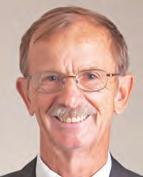
VICE-PRESIDENT Garry Pond, 72, is a member of Carleton Place, Ont., Branch and has been with the Legion for nearly 40 years. He served 23 years with the CAF and after his release he was a consultant for the Defence Department for another 23 years. Pond retired in 2018. He has held senior positions at all levels of the Legion, including branch president and zone and district commander and is currently the Immediate Past President of Ontario Command, where he continues to chair the property committee and the homeless veterans program. On the Dominion Executive Council, Pond is a member of the membership and centenary committees. He is a recipient of the Canadian Forces’ Decoration, the Sovereign’s Medal for Volunteers and the Queen Elizabeth II Diamond Jubilee Medal. Pond and his wife Linda love to travel, hike and spend time outdoors. They have a daughter Rhonda and two grandchildren.

TREASURER Jill Carleton, 60, is a member of Perth-Upon-Tay Branch in Perth, Ont. She served more than 20 years in the CAF as a naval logistics officer. After Carleton left the forces in 2005, she worked in the federal public service in various roles, including strategic planning and governance, organizational excellence and workplace wellness. Carleton retired in 2018. At the Legion, she held numerous executive positions at the Osgoode, Ont., Branch and, at the national level, she helped found the Operational Stress Injury (OSI) Special Section. On the Dominion Executive Council, Carleton has served as a member of the veterans, service and seniors and going forward committees, and as president of the OSI section. Beyond her Legion volunteerism, she has served as chair of the audit committee of the Royal Military Colleges of Canada Alumni Association, as a mentor for the Mental Health Commission of Canada SPARK program and as a representative on Veterans Affairs Canada’s mental health treatment review committee, among many other initiatives. Carleton is a certified professional accountant and a certified management accountant. She loves to read, plays piano and swims and loves animals. She raised two sons.

CHAIR Bill Chafe, 66, is a life member with 46 years in the Legion. He served with the First Hussars Reserve Regiment and is currently a member of Sarnia, Ont., Branch. Chafe is currently serving his fourth term as chair at the national level. He has served as the vice-chair of the EDI committee and as a member of the constitution and laws, finance (budget), going forward, and veterans, service and seniors committees. He continues to serve on numerous committees and is also secretary of the Canvet board. He works with CIMS Limited Partnership and in his spare time enjoys all things Legion, travelling and sports. Chafe is a recipient of the Meritorious Service Medal, the Sovereign’s Medal for Volunteers, the Palm Leaf, the Queen Elizabeth II Golden Jubilee Medal and the Queen Elizabeth II Diamond Jubilee Medal. He and his wife Laurie have two children, Sharon and Bill, and seven grandchildren.
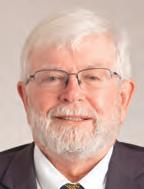
IMMEDIATE PAST PRESIDENT Bruce Julian, 72, has 47 years of Legion service and is a life member of the Beachville, Ont., Branch. He has served in the 3rd and 4th battalions of The Royal Canadian Regiment and at every level of the Legion, rising to president of Ontario Command in 2013. At the national level, he has served on Dominion Executive Council as chair of the public relations, membership, veterans, service and seniors, dominion convention resolutions, RCEL and going forward committees, vice-chair of the centennial committee and as a member of the poppy and remembrance and veterans consultation, finance (pay and budget) committees. He is currently vice-chair of the RCEL and a member of the going forward committee. He is also a former chair and vice-chair of Canvet Publications. Julian is a recipient of the Meritorious Service Medal, the Sovereign’s Medal for Volunteers, the Palm Leaf, the Queen Elizabeth II Golden Jubilee Medal and the Queen Elizabeth II Diamond Jubilee Medal, as well as the Fire Services Exemplary Service Medal and Fire Services Long Service Medal, awarded by the federal and provincial governments respectively. Julian farms for a living and enjoys travelling, fishing, reading and time with his family. He and his wife Darlene have two children, Jaclyn and Joseph, and three grandchildren, Brandon, Megan and Ella.

GRAND PRESIDENT Larry Murray, 77, retired in 1997 after 33 years with the Royal Canadian Navy and as acting chief of the defence staff with the CAF. He joined Fisheries and Oceans Canada that year and was appointed associate deputy minister. In 1999, he moved to Veterans Affairs Canada, where he served as deputy minister. He subsequently served as deputy minister with Fisheries and Oceans from 2003 to 2007. At the Legion’s national level, he has served as ex-officio of the focus on the future and defence and security committees. Currently, he is chair of the veterans consultation and Op Harmony committees, ex-officio of the veterans, service and seniors committee, and is a director of the Legion National Foundation. He is former chair of the Board of Directors of the Public Policy Forum and past president of the Nova Scotia Mainland Division of the Navy League of Canada. He was the first chair of the Veterans Ombudsman Advisory Committee, an external member of the National Defence Audit Committee and honorary Colonel Commandant of the Chaplain Branch of the Canadian Armed Forces. At present, he is chair of the Independent Review Panel on Defence Acquisition. Murray’s awards include Member of the Order of Canada, Commander of the Order of Military Merit, Member of the Order of St. John of Jerusalem, NATO Special Services Medal, Vimy Award from the Conference of Canadian Defence Associations, Chief of the Defence Staff Commendation, Minister of Veterans Affairs Commendation, 125th Anniversary of the Confederation of Canada Medal, the Queen Elizabeth II Golden Jubilee Medal and the Queen Elizabeth II Diamond Jubilee Medal. He and his wife Claudia Buckley have six children and enjoy spending time with their seven grandchildren. In his spare time, he enjoys volunteering, kayaking, gardening, jogging and reading. L

BY LESLIE ANTHONY

WAR AND PLAY
A CANADIAN CHARITY WORKS TO BUILD PLAYGROUNDS IN WARTORN AREAS AROUND THE WORLD
Canadian charity Playground Builders helped facilitate the construction of this kids’ park in Gaza. After the recent bombardment of the Palestinian territory, all of the group’s 37 Gazan parks have been damaged or destroyed.
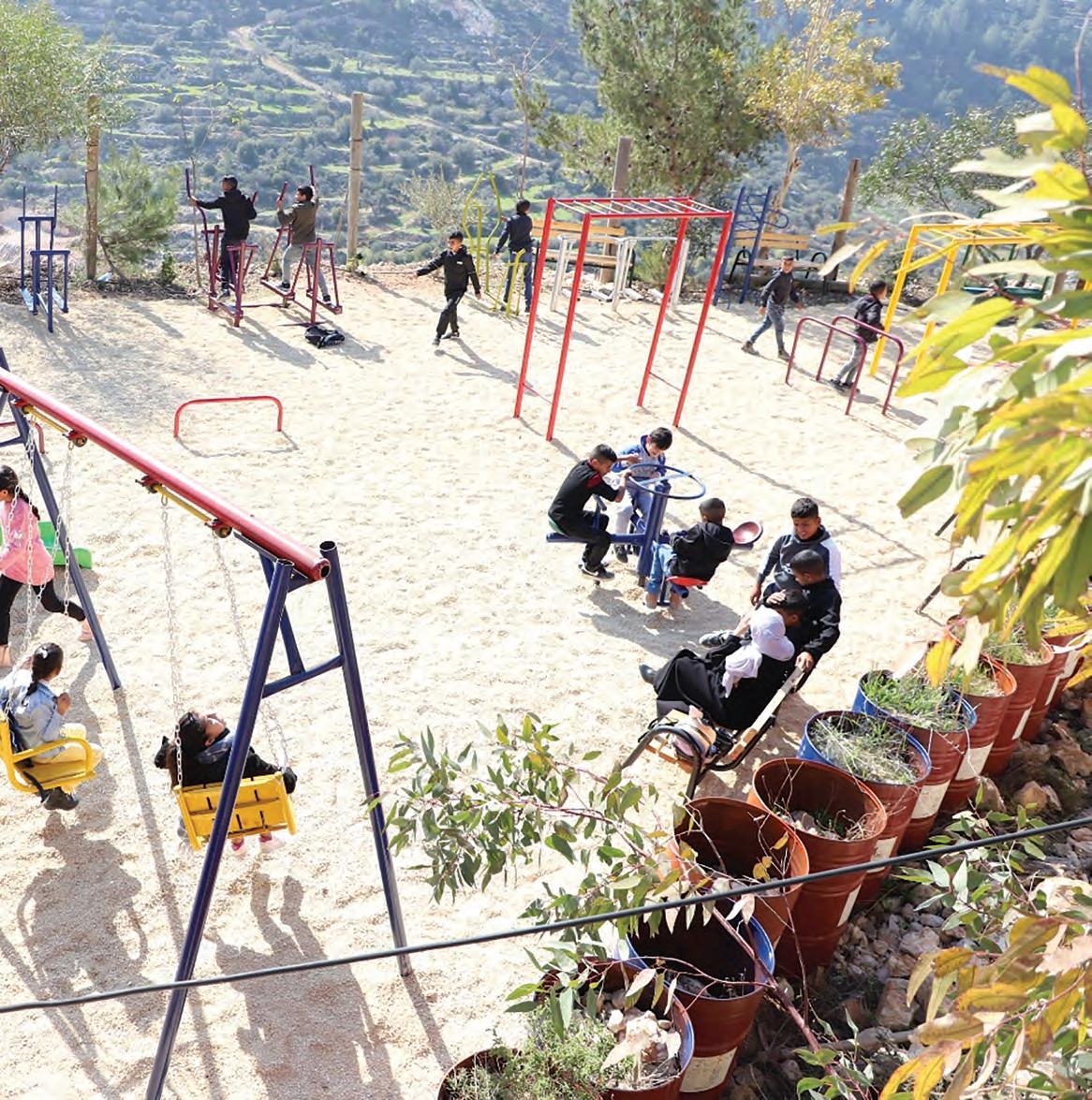
They come together through dreams and diligence. A shadow of land, a heap of metal. A bucket of hand-mixed concrete, a can of donated paint. They find life at schools, orphanages and gathering places. They might have a fence, maybe some benches. No matter the details, each represents a small raft of joy in a sea of strife, the laughter emanating from their swings, slides and climbing bars not just the familiar music of children having fun, but the literal sounds of hope. Whether enjoyed in a public park or at a school,
playgrounds are a quintessential part of childhood for many Canadians. A place where hours were often passed with family or friends. Such escapes, however, are virtually unknown to children living in wartorn areas, where the landscapes of youthful diversion more often involve rebar-riven heaps of rubble and constellations of rocket craters.
It seems not only unfortunate but grievously wrong that the protracted political and ideological quarrels of adults can create such voids in the lives of children—the kind of thing
that could and should be righted. Indeed, that simple prospect—creating safe places for play—is the motivation behind Playground Builders, a small, direct-action charity based in Whistler, B.C., that has constructed 290 playgrounds in areas of cyclical conflict in the Middle East and central Asia—207 alone in Afghanistan—and are now used by 1.6 million children daily.
While the destruction and insecurities of war serve to emphasize the need, playgrounds are even more valuable in blunting instability after fighting ends.

Workers prep a playground site in Afghanistan. A youngster enjoys one result of their labour.
“Mom and dad, if they’re alive, are setting up shelter and looking for food; the kids are on their own,” said the organization’s founder Keith Reynolds, recalling a visit to the West Bank town of Jenin in 2005 that sparked the initial idea. “At the time, [Israel] was rounding up men and putting them in prison. And this mother I met, suddenly the family breadwinner, was trying to contain her kids who, with nothing else to do, were climbing out windows to throw rocks at Israeli tanks— never a good activity.”
Reynolds, an inveterate traveller who once worked in the forestry sector, recognized the need for safe spaces where kids could expend energy in more positive ways. Explaining his thoughts to a friend back in Whistler over a beer, Reynolds was handed a cheque and an entreat to “Do it,” leading to a first playground in the West Bank in 2006. The charity was founded the following
year, eventually expanding its mission to Gaza, Iraq and Afghanistan, dodging the problems of most foreign nongovernmental organizations in active conflict zones by having no offices, cars, phones, computers, security or even staff—its monies funnelled directly to hand-
employed preparing land, welding and painting play structures, and installing benches where parents can watch their kids play. Work, pride and happy children are powerful motivators—and positive ways to cultivate a reduced appetite for the conflict stream.
WORK, PRIDE AND HAPPY CHILDREN ARE POWERFUL MOTIVATORS— AND POSITIVE WAYS TO CULTIVATE A REDUCED APPETITE FOR THE CONFLICT STREAM.
picked local partner NGOs already working with women and children. It also eschewed all politicization: “We’re 3G,” said Reynolds. “No gods, no guns, no governments.” Depending on location, $8,000-$10,000 will build a pre-designed playground, making it easy for a single donor or group to sponsor. In addition to minimal material costs, locals are
As a regional novelty, playgrounds can see heavy use: at one Afghan school, where 14,000 girls studied in three daily shifts prior to Taliban rule in 2021, the single playground was mobbed from sun-up to sundown. Given the inevitable wearand-tear of such high traffic, Playground Builders now allocates a portion of funds each year for refurbishment.



Workers paint a mural and move equipment into place at playgrounds in Gaza.




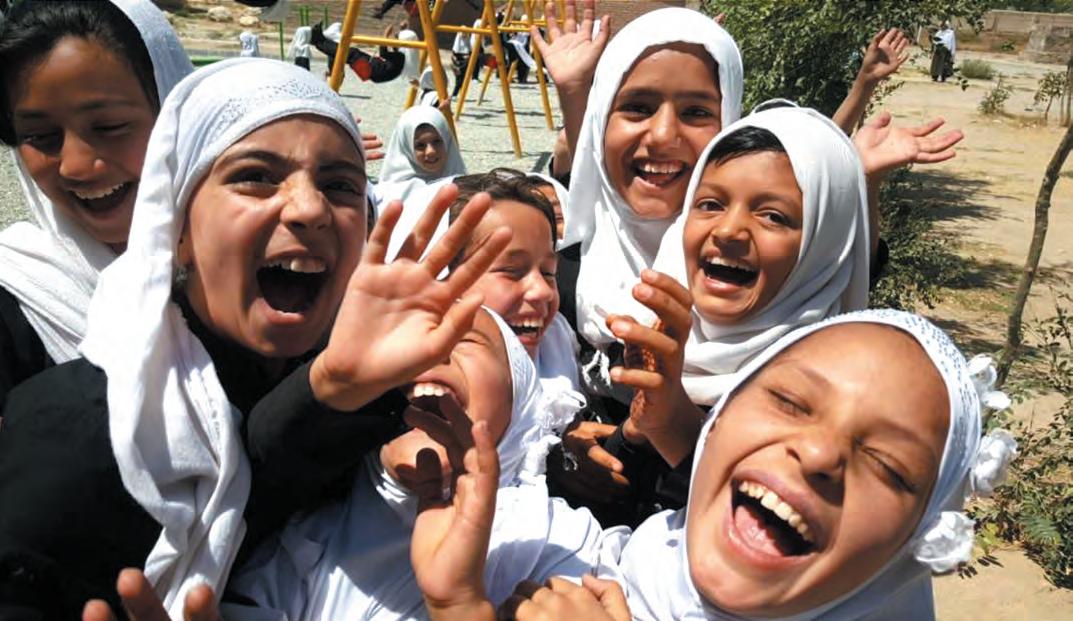
Plus, given their locations, there’s also the risk a playground can be lost to renewed conflict.
Though the group’s 37 playgrounds in Gaza sound like a respectable total for such a small territory, a population density of 5,500/square kilometre meant there was always a need for more (a recent installation in the territory served 70,000 kids). And while three were destroyed during past Israeli incursions, the latest conflict has exacted a much higher toll—all have been damaged or destroyed.

too dangerous—three of our NGO partners have already been killed.”
“We can say with confidence that we’ve lost some and there’s been damage to others,” said Reynolds, who struggles with what the displacement of 1.7 million people means for surviving children. “It’s just
This past August, Reynolds texted with a Gazan woman who helped facilitate 17 playgrounds, but has now found herself on a forced march away from high-conflict areas on four occasions, and narrowly escaped death in a marketplace strike. Her update: “They have destroyed them all—even the schools.”
To maintain some level of support for the children of Gaza, Playground Builders has pivoted to helping feed the poorest of the displaced through a health and nutrition initiative—though even that is proving fraught.
Another August text: “Dear Mr. Keith, please mention our team instead of names or anything else. You know it’s too risky here.” L



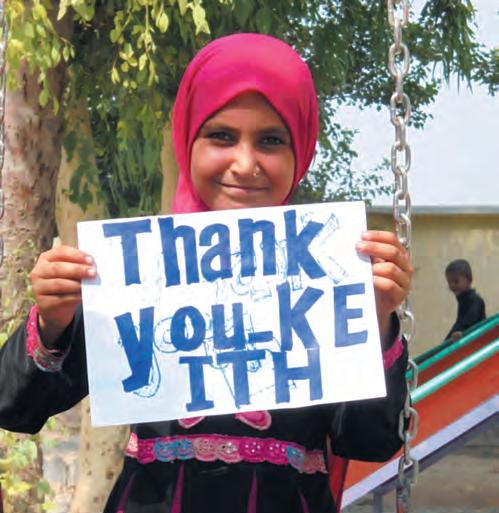
Keith Reynolds (left, on right) helped facilitate the construction of the first of his charity’s playgrounds in the West Bank in 2006. Since then, it has built 289 others in the Middle East and central Asia, working with local NGOs to organize the work. One Gazan woman, Doaa (below), helped with many of the parks. She and her family were killed during the recent Israel-Hamas war.

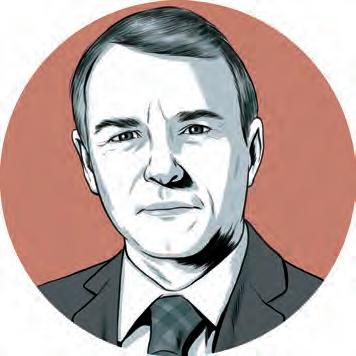
At10:40 a.m. on Oct. 31, 1944, as soldiers of The Black Watch cautiously approached the Walcheren causeway leading from South Beveland to Walcheren Island, they quickly came under heavy German fire. A few soldiers managed to get within 25 metres of the causeway’s western end, but the rest were pinned down.
All except for a few trapped at the far end, including casualties, were able to withdraw that night. They were the first of 135 Canadians killed or wounded here, the result of a costly, and ultimately unnecessary, diversionary attack.
The 1,200-metre-long, 45-metrewide causeway had reinforced slit trenches on its slopes, steel and concrete obstacles across it and a large crater about 300 metres from its eastern end. The western end had a heavily defended roadblock that included three 88mm guns, one of which could fire straight down the narrow crossing. Artillery, mortars and machine guns were sited on it, too.
The original plan was to send a Black Watch fighting patrol across to seize a bridgehead, while The Calgary Highlanders, trained in assault boat handling, would make an amphibious crossing of the surrounding Sloe Channel.
After early Canadian-led attempts to advance across the Netherland’s Walcheren causeway were unsuccessful, should the move have been abandoned?
John Boileau says YES
Once a bridgehead was secured, Le Régiment de Maisonneuve would follow and advance farther westward with the Calgaries.
But when Brigadier Bill Megill, commander 5th Canadian Infantry Brigade, was told the Sloe Channel, a combination of mud flats and marsh, was impassible to men on foot, in boats or amphibious vehicles, he changed his plans. Between Oct. 31-Nov. 1, Megill ordered a sequence of frontal attacks, all of which ended in failure despite heavy fire support.
THERE’S A LONGSTANDING AND WELL-KNOWN MILITARY MAXIM THAT STATES “ NEVER REINFORCE FAILURE.”
As each wave was driven back, Megill ordered yet another attempt. Canadian soldiers bravely went forward into a seemingly impossible situation. Officers from British units under Canadian command watched in growing disbelief as Megill sent his battalions across in succession.
There’s a long-standing and well-known military maxim that states “never reinforce failure.” Its meaning is self-evident: don’t waste more lives and resources on an already failed operation.
To violate this cardinal rule is usually unforgiving. It’s virtually impossible to make a bad plan succeed by throwing more resources at it. The result is almost always the same: the losses increase.
Quite simply, more people die, are wounded or taken prisoner; more vehicles and equipment are destroyed or damaged; more ammunition is wasted, and reputations are typically ruined.
The most egregious of the consequences is that any commander who chooses to reinforce failure is ordering their subordinates to suffer or die in vain.
In the end, a more thorough reconnaissance would have discovered the passable footpath through the Sloe Channel. A British infantry battalion used it during the early morning of Nov. 3 to successfully flank the Germans defending the causeway’s western end.
The unnecessary and repeated failure of 5th Brigade’s battalions to secure the causeway proves another military adage: “time spent in reconnaissance is seldom wasted.” L
> To voice your opinion on this question, go to www.legionmagazine.com/FaceToFace

War is a bad business. Allied forces laid waste to dozens of European towns, villages and cities in their 1944-45 march to victory over Nazi Germany.
Allied air forces dropped nearly 550,000 tonnes of bombs on 1,570 French cities, towns and villages during the war. No fewer than 68,778 men, women and children were killed and 100,000 wounded. Some 432,000 houses were destroyed, another 890,000 damaged.
In Belgium, Allied bombing in September 1944 alone killed 9,750 civilians and wounded 40,000. In the Netherlands, some 10,000 Dutch civilians fell victim to Allied bombs; at least 8,500 others are believed to have been killed by crashing aircraft.
On Feb. 22, 1944, U.S. planes carpet-bombed the area around the Nijmegen train station, killing at least 763 residents, including 24 children and eight nuns.
After all that, you’re going to delay or abandon efforts to take a small island that threatens to prevent you from provisioning your armies as they end six years of war?
In this war, at that stage, the fact the causeway was taken simply justifies what was inarguably a costly decision.
JOHN BOILEAU is a retired army colonel and the author of hundreds of articles and 15 books on Canadian general and military history. He is a 2022 recipient of the Order of Nova Scotia.
Stephen J. Thorne says
STEPHEN J. THORNE is an award-winning journalist, editor and photographer and Legion Magazine’s senior staff writer. He has reported on the downfall of South African apartheid and from war fronts in Kosovo and Afghanistan.
German-held Walcheren Island stood at the mouth of the Scheldt River, the last obstacle to opening the idle, Allied-held docks of Antwerp to ships bringing desperately needed equipment, food and other supplies for the final push into Germany.
The narrow causeway represented the only bridge across the Sloe Channel. Bordered by marsh, mudflats and deep water, the elevated passage bore a rail line and a paved road.
on which German coastal batteries commanded the approaches to the waterway, remained significant.
Canadian troops endured multiple setbacks before a final, bloody push ended it.
The Calgary Highlanders suffered 64 casualties in three days of fighting at Walcheren. Le Régiment de Maisonneuve had one killed and 10 wounded. The Black Watch took the bulk of their 85 casualties on the causeway.
IN THIS WAR, AT THAT STAGE, THE FACT THE CAUSEWAY WAS TAKEN SIMPLY JUSTIFIES WHAT WAS INARGUABLY A COSTLY DECISION
Under orders to prioritize the Scheldt, British General Bernard Montgomery had spent much of the campaign distracted by, and sucking resources into, Operation Market Garden, his ill-conceived—and failed— attempt to end the war early. But Canadian Lieutenant-General Guy Simonds never complained about his lack of manpower, ammunition and air support.
Bomber Command had already breached Walcheren’s dikes, virtually obliterating the town of Westkapelle and killing at least 150 of its inhabitants.
By Oct. 31, the lands surrounding the Scheldt estuary had been largely cleared. Only Walcheren,
The bloody mainland fighting against a well-positioned, well-manned Wehrmacht had ground on for weeks. A furious Dwight D. Eisenhower, commanding Allied forces in Europe, was on the brink of firing his difficult British subordinate when Montgomery finally came around. By the time the liberators reached Walcheren, victory was in sight: No time to stop. L










Northern Lights
In partnership with Sock Rocket, for each pair produced, three pairs are donated to agencies across Canada providing clothing to Canadian veterans. Adult M/L 7-12 80% cotton, 15% polyester, 5% spandex
Keep calm and Includes a week-in-view calendar, inspirational quotes, time zone map and important dates.
Bistro Mug
Hold on. Let me overthink this. Sip in style with this classic bistro mug—the perfect accompaniment to your morning routine or busy workplace. 16 oz., 4"

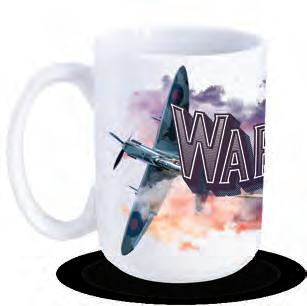


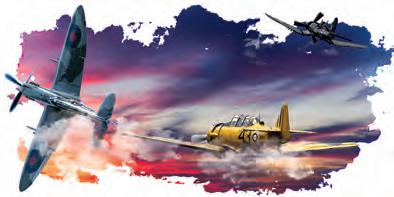
a burst of Canadian florals including Scarlet Beebalm, Lavender and Sweet Alyssum. And look closely, you'll find the humble honey bee, a vital and important pollinator.

By Stephen J. Thorne
By Aaron Kylie


There must be something in the water they give those athletes at the Legion National Youth Track and Field Championships.
The 2024 Summer Olympics was proof positive of the Nationals’ fundamental role in the rise of elite Canadian sports men and women— 28 Legion Nationals alumni wore the red and white in Paris, including bronze medallists such as pole vaulter Alysha Newman of London, Ont., and golden hammer throwers Ethan Katzberg and Camryn Rogers, both from B.C. And judging by three balmy August days of competition at the 2024 Legion Nationals in Calgary, the future looks bright.
Gursher Gabri of B.C./Yukon walked away with the Jack Stenhouse Award as top male Legion athlete after sweeping the U16 heavy throwing events: a 17.22m in the shot put, 56.08 in the discus and 65.68 in the hammer,
the latter almost 16 metres better than his closest competitor.
Ontario’s Kiana Charest earned the Leroy Washburn Award as top female Legion athlete after an equally dominating performance on the track, where she won the U18 women’s 800, 1200 and 2000m races.
Mackenzie Hurtubise of B.C./Yukon took her second straight U18 women’s pole vault title, notching a meet record 3.93m with relative ease.
Some 968 athletes—640 open and 328 Legion-sponsored— competed at Calgary’s Foothills Athletic Park.
About 72 certified officials watched over events, while more than 200 volunteers made for a smooth, virtually flawless meet. Wounded Afghanistan veteran and
para-athlete Mike Trauner served a second straight year inspiring participants as special ambassador.
Each year, the Nationals marks an event or period in Canadian military history. This year’s games recognized Canada’s 12-plus years in Afghanistan.
The Legion Nationals have operated almost annually for 47 years (COVID cancelled events in 2020 and 2021) and RCL members have played roles in coaching and developing Canadian track and field athletes for almost a century. While hockey and soccer attract the big sponsors, youth athletics take a back seat. Certified by Athletics Canada as the national youth championships in 2010, the Legion Nationals are the RCL’s single biggest investment and the country’s only national U18 and U16 athletics competition. L
Gabriel Genest of Club d’athlétisme Corsaire-Chaparral in Sainte-Thérèse, Que., (opposite) won the U18 men’s pole vault, clearing 4.30 metres at the 2024 Legion National Youth Track and Field Championships. U-18 women run a heat in the 100m hurdles.
Kiana Charest of Ontario (right) was named the top Legion female athlete after sweeping the U18 women’s 800, 1200 and 2000 metres. U18 steeplechasers clear the water hazard. Heats (opposite top) get underway in the U18 men’s 110m hurdles. Mikayla Grant of Eclipse Track and Field Running Club in Oshawa, Ont., took gold in the U18 women’s javelin with a 45.74. Mackenzie Hurtubise of B.C./Yukon took her second straight U18 women’s pole vault with a meetrecord 3.93m.



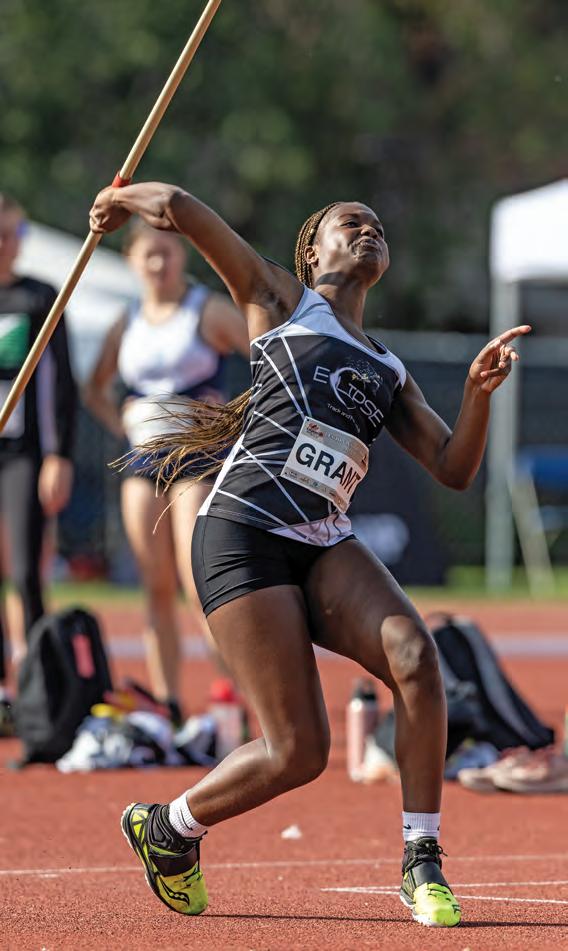


Anchor Adele Kushner of Ontario’s Thorold Elite TFC (above) takes the baton from teammate Koko Dennis during the U16 girls’ 1600m medley. U16 medley runners Alexia Jones and Anieu Chan celebrate Ontario’s gold medal. Liam Palmer of Manitoba-Northwestern Ontario took the U18 men’s 2000m steeplechase in 6:02.66.

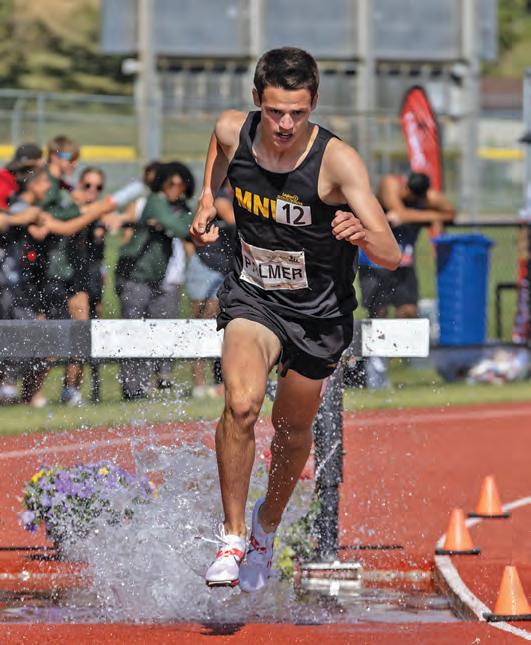
IN THE NEWS
Abandoned development on Juno Beach now slated to be part of museum expansion
By Aaron Kylie
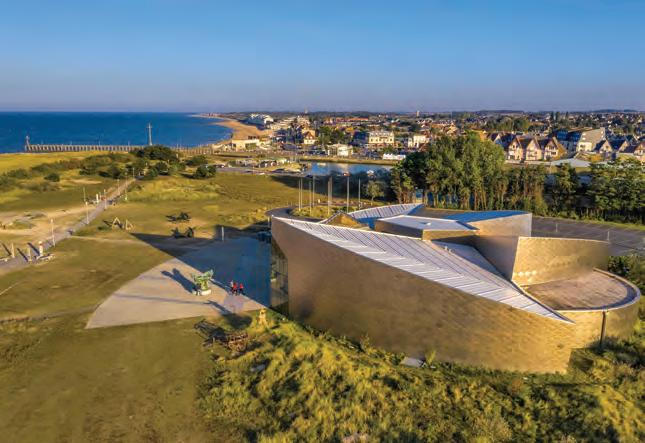
Land only recently abandoned by developers at the site where Canadian troops fought and died on D-Day is now slated to become part of an expanded memorial park in France. In essence, it will be an extension of the site of the adjacent Juno Beach Centre, Canada’s Second World War museum in Courseulles-sur-Mer.
Following a protracted legal battle—the centre spent $800,000 fighting a proposed condo development in court—the Canadian and French governments, along with local authorities, secured the property. Protection of the parcel was then transferred to the museum.
Canada contributed $4 million to purchase the land after more than 65,000 Canadians wrote letters to politicians in both countries demanding the area, considered hallowed ground, be protected.
“THESE SPACES WILL NOT ONLY PROVIDE AN OPPORTUNITY FOR REFLECTION AND DIALOGUE, THEY WILL ENABLE ADDITIONAL REVENUE GENERATION.”
And protected it will be. This past June, the centre announced its plans to expand the park surrounding its facility to the newly acquired site, which will include additional space for reflection and learning and pedestrian pathways. The centre will also work to restore the plot’s surrounding sand dunes to preserve the local ecosystem and biodiversity. The work could be completed by 2026.
“Not only will it protect the Canadian D-Day battle site from urbanization, but these objectives also align with the [centre’s] sustainable development strategy,”
Recently slated for development, the strip of land along the Seulles River near the Juno Beach Centre in France will now be part of the museum's property.
said Don Cooper, president of the Juno Beach Centre Association.
“Canadians have seen a resolution to the condo dispute and now want to see the site preserved in a way that compliments the Juno Beach Centre and honours the Canadians who gave their lives to start the liberation of northwest Europe from this spot.”
Some 14,000 Canadian troops landed and 359 died on the 10 kilometres of sand code-named Juno, one of five Normandy beaches where the bulk of 156,000 Allied soldiers launched the invasion of Nazi-occupied Europe.
Dedicated to preserving that legacy, the Juno Beach Centre has welcomed more than 1.3 million visitors since it opened in 2023, 28 per cent of them Canadian and 36 per cent French citizens. A record 103,000 visited in 2019, D-Day’s 75th anniversary year.
The museum was original built to host 60,000 visitors annually, but now receives 90,000-100,000.
The protection of the former development land is part of an $11-million, five-year museum modernization plan. The centre is also planning a $6.3-million, 450-square metre expansion of its building, to include a larger boutique and expanded café. The addition will increase the museum’s physical space by 25 per cent to help accommodate growing attendance.
“These spaces will not only provide an opportunity
for reflection and dialogue,” said Cooper of the expansion, “they will enable additional revenue generation and support the museum’s sustainability goals.”
The centre recently received a $750,000 contribution to the

Hugh Greene, the last living veteran of the Second World War to serve as dominion president of The Royal Canadian Legion, died Aug. 18 in his hometown of Ponoka, Alta. He was 101.
Greene was born in Mullaghun County Fermanagh, in Northern Ireland, the first-born of nine children. In 1928, the Greene family immigrated to Canada. After arriving in Halifax, they went by train to Alberta near Wetaskiwin, where a relative lived. The family settled on a farm where Greene grew up. After graduating from Wetaskiwin High School, he joined the Royal Canadian Air Force and served overseas.
Following his war service, Greene returned home and bought the family farm. Shortly afterward, he met Doris and they married in 1949. They had three daughters and moved to Ponoka where Greene worked on the farm,
initiative from the Arthur J.E. Child Foundation, a private organization created by the late Albertan entrepreneur who had also served as an honorary colonel of two branches of the Canadian Armed Forces. French
OBITUARY
and European partners, meanwhile, have offered a combined 1.8 million euros to the project.
The museum has launched a donation campaign to raise the remaining $7.25 million needed to realize its vision. L
Hugh Greene 1923-2024
in business and the civil service. Five more children were born after that. Hugh and Doris celebrated their 75th wedding anniversary just before his passing.
Greene was heavily involved in his church, community groups and the Legion throughout his life. He enjoyed gardening and long walks where he always met and talked with neighbours.
Greene joined the Wetaskiwin, Alta., Branch of the Legion in 1946 and later transferred to Ponoka Branch in 1958. He served as president of Alberta-Northwest Territories Command for 1983-85.
Throughout his Legion career, Greene was supportive of youth, especially through the annual Legion National Youth Track and Field Championship (see page 82). He led two pilgrimages to Europe for youth leaders. He was recipient of both the Legion Meritorious Service Medal and the Palm Leaf. Greene became national president at the 35th dominion convention in Calgary, one of the most contentious Legion conventions since the new Maple Leaf flag was introduced in 1965. At issue was a controversy that began when members of Newton Branch in Surrey, B.C., refused admission to Sikh veterans wearing turbans following Remembrance Day ceremonies. The house rules, as they were in several Legion
branches at the time, forbid the wearing of headdress in designated areas of the branch.
As this violated human rights legislation in several provinces, Dominion Command responded by proposing a bylaw that said that branches were required to give Legion members and their guests wearing religious headdress access to all areas normally open to members and their guests. Dominion Chair Bob Ford said the Legion procedure was that when issues were not clear, the chair should refer to Robert’s Rules of Order. Those rules say that delegates will not vote on issues which could be contrary to the law.
Nonetheless, Ford allowed a 2½-hour debate. Finally, a secret ballot was taken and the proposed bylaw was defeated. Following a short recess, Ford announced that he should never have allowed the vote and promptly resigned and left the event.
Greene would spend the early part of his term insisting that branches follow the rules under the various human rights legislations in the provinces and territories. Greene was predeceased by two of his daughters. He is survived by his wife Doris, his remaining children and many grandchildren, cousins, nieces and nephews living in Canada, Ireland and Australia. L
Emergency assistance through the Poppy Trust Fund
For released members of the Canadian Armed Forces: as a CAF or RCMP veteran, you may be eligible for emergency financial assistance through The Royal Canadian Legion’s Poppy Trust Fund. This money is made available through the generosity of Canadians. If you are a veteran in financial distress, this fund may be able to help.
The assistance could cover essential needs such as shelter, food, fuel, clothing, prescription medicine, medical devices or equipment, or necessary transportation.
To find out if you qualify, contact your local branch service officer or the provincial command office in your area. Visit https://www. legion.ca/contact-us/provincialcommands to find the right contact for your region.
In many cases, the service officer can also co-ordinate assistance with local community agencies and community resources.
For currently serving members of the CAF: the Poppy Trust Fund may also aid an active member of the CAF in need; however, as several options are available through the Canadian Forces community and the Canadian Forces Morale and Welfare Services, the first step is to contact the financial counsellor on base at the local SISIP office. The counsellor can provide guidance on available programs and assistance options and, if appropriate, they will then contact the provincial command office to access Poppy Trust Funds on your behalf. For more
information, visit https://cfmws. ca/insurance-finance/financialcounselling and https://www. supportourtroops.ca/Get-Support/ Emergency-financial-assistance.
A provincial command service officer will be able to determine if you are eligible for other Veterans Affairs Canada support programs.
For veterans who served with allied countries: if you are a veteran from the United Kingdom or other allied countries, contact a service officer at the Legion's national headquarters to determine if you may be eligible to apply for financial assistance through various initiatives in the U.K. Find contact details at https:// legion.ca/contact-us. L
GALLERY POSTERS
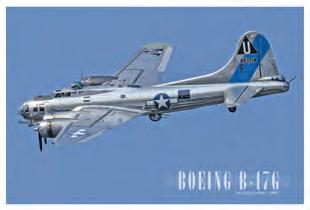


Photography by Stephen J. Thorne
Volunteering in the community
$314,176 to their communities IN THIS ISSUE
Legion branches donate more than

Kennebecasis Branch in Rothesay, N.B., presents $2,000 to the Honorary Capt. (N) Noel A. Kinsella Naval Memorial Fund, which provides bursaries to naval reservists or sea cadets for post-graduate studies. Pictured are Cdr. Tom Watts, CO of HMCS Brunswicker; Capt. (N) Paul Dempsey, chair of the N.B. Naval Memorial Committee; Cdr. John Henderson, President of RSUI-N.B.; President Brian Eisan and N.B. Command Executive Director Jack Clayton.

First Vice Katherine Hawthorne and President Anne Brown of the Junior Ladies Auxiliary at St. Croix Branch in St. Stephen, N.B., present $500 bursaries to Parker Gowan and Kameron McCann. Absent is recipient Ashlynn Dufour. GERALDINE LEAVITT

Trustee Tom Daigle of Stevenson Building Branch in Richibucto, N.B., presents a Quilt of Valour to Sgt.-at-Arms Ellis Savoie, accompanied by his wife Ruby and daughter Bobbi Jo. STELLA WARD

Lower Southampton Branch in Nackawic, N.B., awards bursaries to six graduates of Nackawic High School. Pictured are Kaylen Matchett, Neveah Royal, Hailey Nason, First Vice Gordie Thompson, Erica Graham, Arianna Farrell and Adeline Calder.

Kennebecasis Branch in Rothesay, N.B., presents $2,500 to the Navy League of Canada Quispamsis Branch. Pictured are A. Sub-Lt. Ryan Henderson, CO 170; Branch Past President Gordon Friars; Lieut. (N) Cheryl Donnelly, CO 268; Branch President Brian Eisan; CPO2 Furrow, Coxn 268; CPO1 Wright, Coxn 170; and Navy League president Heather McClintock. BRIAN EISAN

Hartland, N.B., Branch President Gary Bovard and Upper Valley District Commander Lena Levesque present $500 to the Hartland Community School Hot Lunch program on behalf of New Brunswick Command’s Community Service Fund, matching a branch donation. Principal Andy Clark accepts the donation. GLORIA FOSTER
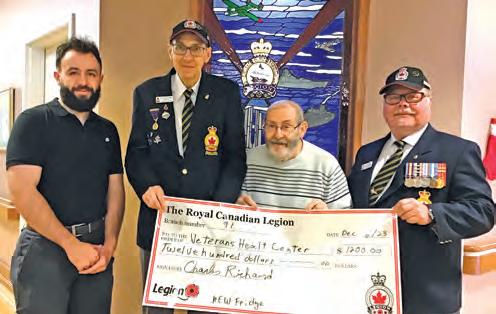
President Charles Richard and Réjean Michel of Cap Pele, N.B., Branch present $1,200 to Moncton’s Veterans Health Centre, represented by Sébastien Dupuis and Jacques Papillon.


Ahead of a VE-Day ceremony hosted by Hemmingford, Que., Branch, piper
escorts more than 160 students from their school to the cenotaph.
Harnold Savard (left) and Gérard Trudeau of Lt.-Col. Charles Forbes Branch in Quebec City present $5,000 to the CASA Addiction Prevention and Treatment Centre, represented by Gorden Boivin. ALCIDE MAILLET
Robert Waller
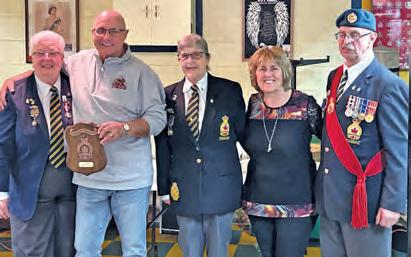
Alan Latulippe of Thessalon, Ont., Branch receives the Legionnaire of the Year award from Branch President Donna Latulippe. Also attending are membership chair Francine Grasley, MP Carol Hughes and Sgt.-at-Arms Dave Grasley.

Byron-Springbank Branch in London, Ont., presents a $4,000 flying scholarship to 27 air cadet squadron. Pictured are squadron CO Capt. Andrew Gillatly, SCC President Keely Ford, Branch President Andrea Roussy and Terry Rushton of the RCAF Association.

Dianne Benedict receives the Volunteer of the Year award from President Leo Lund and Merrill Gooderham of Limestone City Branch in Kingston, Ont.

Treasurer Lila Pelkey and President Valerie Clark of Lord Elgin Branch in St. Thomas, Ont., present $500 to Kyle Countryman, a member of Canada’s 3-on-3 basketball team travelling to Austria.

Veterans Michael Beaulieu (navy), Donald Lake (air force), Gordon Becker
John Noble (navy and air force) and Jim Cullen
are presented with Quilts of Valour at Paisley, Ont., Branch.
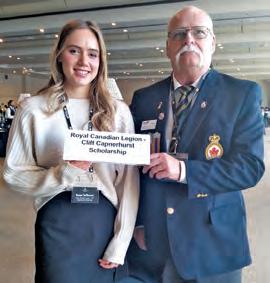
Zone A1 Commander Jim Dunn presents Renee Toflemire with the Zone A1 bursary (Cliff Capenhurst) scholarship award.

L.A. President Jan Axford of Bay Ridges Branch in Pickering, Ont., presents Tracey Lucychyn with the Legionnaire of the Year award.
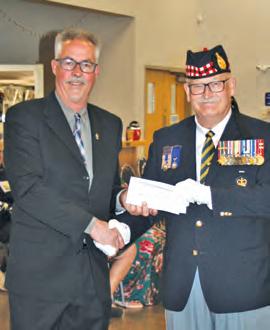
Retired Lt.-Col. Morris Brause of Metropolitan Branch in Windsor, Ont., presents $10,000 to Royal Canadian army cadet corps 2715.
(army),
(army)

Trish Gander, First Vice John Anderson and President Alex Verdile of Merritton Branch in St. Catharines, Ont., present $6,420 to Hotel Dieu Shaver, represented by Tracy Hancharyk, Rena McDonald and Kristina Manzi.
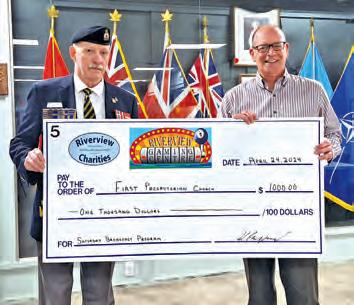
Chatham, Ont., Branch President Len Maynard presents Rev. Mike Maroney with $1,000 for the First Presbyterian Church breakfast program.
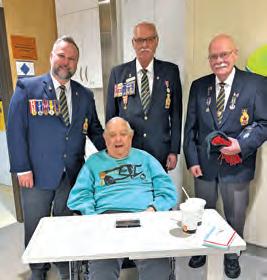
President Joe Gowing, Past President Peter Gates and Sgt.-at-Arms Bob Bruce of Preston Branch in Cambridge, Ont., present veteran Walter Morton with his 50-year medal.

President Jim Hemlin of Kanata, Ont., Branch presents the Legionnaire of the Year award to Ken Fleming.
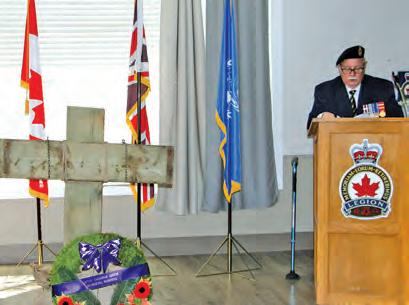
South Carleton Branch in Manotick, Ont., holds a memorial ceremony for soldiers who served in the Korean War. Pictured is Bryan Mack, veterans’ services officer.
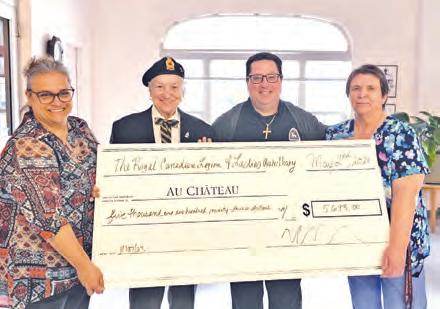
L.A. President Gloria Lavallée and Legion Padre Reverend Jasen Bélanger of Sturgeon Falls, Ont., Branch present $5,693 to Au Chateau Home for the Aged, represented by care director Cindy Brouillette and head nurse Helene Larabie.
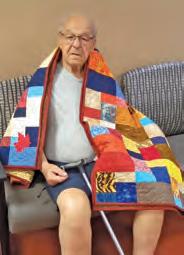
Constitine (Dan) Corchis, member of Metropolitan Branch in Windsor, Ont., receives a Quilt of Valour.
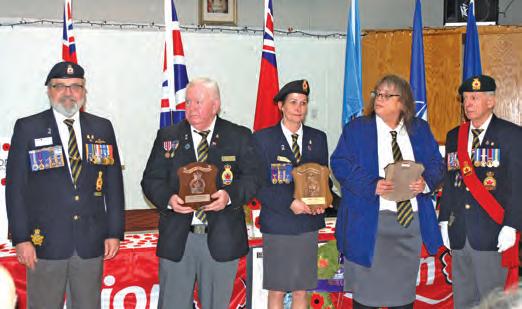
Zone 5 Commander Stephane Guy (left), accompanied by Branch Sgt.-at-Arms Raymond Hotte, presents three Legionnaire of the Year awards at Eastview Branch in Vanier, Ont. Recipients are First Vice Henry McCambridge, President Angela Bourassa and house and bar chair Micheline Szabo.
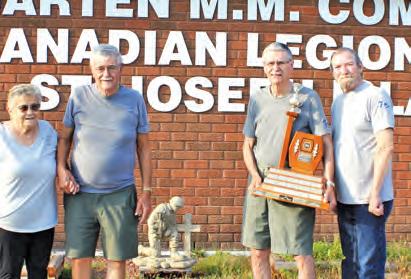
JoAnn Hunter, Blake Smail, Bruce Smail and Bruce Harten of St. Joseph Island Branch in Richards Landing, Ont., win the provincial euchre championship.

Eric Coles and Janet Coles of Osgoode, Ont., Branch present $2,000 to the Perley Health Foundation, represented by development director Courtney Rock.
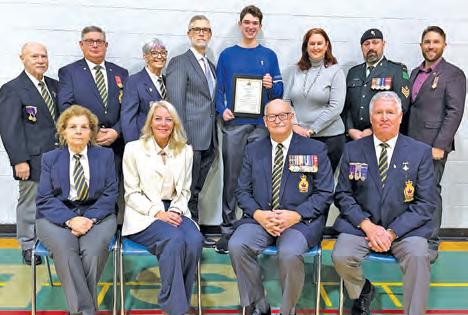
Flanked by his parents, Gavin Pratt of Villa Nova High School in LaSalle, Ont., holds the Certificate of Merit he received after running a 100-kilometre ultra-marathon in which he raised $6,000 for Metropolitan Branch in Windsor, Ont.
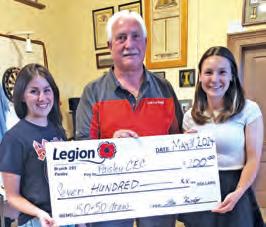
President Glen Hanley of Paisley, Ont., Branch presents $700 to the Paisley Community Enhancement Committee, represented by Kayla McLelland and Emily Hayward.
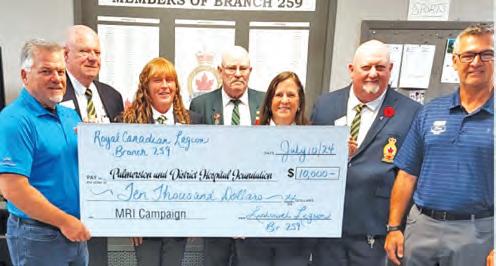
Maj. Andrew McKeever Branch in Listowel, Ont., donates $10,000 to Palmerston Hospital for an MRI machine. Pictured are Dan Hill of Palmerston Hospital, First Vice Wayne Hamilton, Branch President Tracey Nichol, members Gerry Rattray and Casey Fraser, and Second Vice Rick Kelly, along with the hospital’s Mark Leslie.
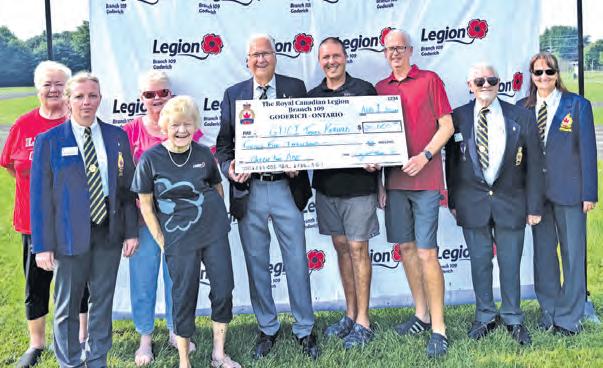
Goderich, Ont., Branch contributes $25,000 to the rebuild of the local athletics track. Pictured in back are branch members Sharon Cousins, Sydney Elder and Evie Shand. In front are the branch’s Margaret Cook and President Randy Carroll, Terry Cox and Ted Doherty from the track rebuild, and branch members Allan Pollard and Laurie Carroll.

Ray Barker and Richard Campbell of Eastview Branch in Vanier, Ont., present $30,945 to Perley Health, represented by foundation head Delphine Haslé and veterans’ liaison Alma Cook.
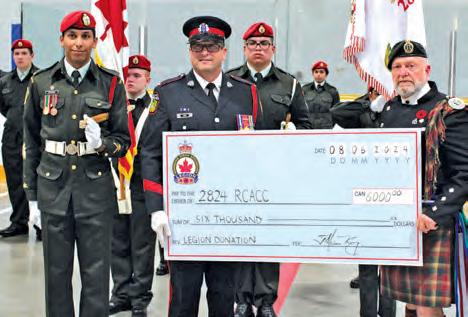
President Alan Roy of Long Branch in Toronto presents $6,000 to 2824 RCACC in Mississauga, represented by Capt. Price (middle) and RSM Olsson.

Shirley Beaton and Jean Tomlinson of Mount Hamilton Branch in Hamilton, Ont., present $15,000 to Julian Foreman of the Health Sciences Foundation, Juravinski Hospital, on behalf of the Ontario Command Branches and L.A. Charitable Foundation.
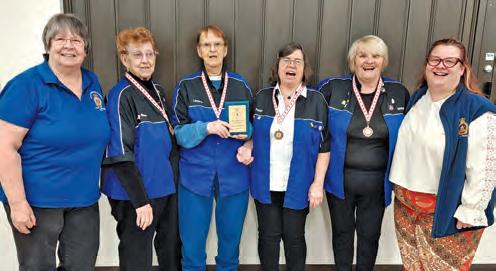
Yolande MacKinnon and provincial sports chair Kelly Scott congratulate Lenora McKenzie, Rose Kennedy, Peggy Towner and Marg Young of North Pickering Township Branch in Claremont, Ont., for winning the L.A. provincial euchre tournament in Callander.

Brendan McGlynn, Joyce Cosbey and Vicki Bateman of Stirling, Ont., Branch present $2,000 to Campbellford Memorial Hospital Foundation, represented by director Cindy McMurray.
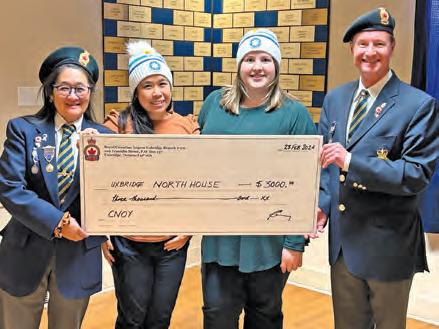
Uxbridge, Ont., Branch Vice President Gloria Eng and President Peter Viney present $3,000 to North House, a housing support organization, represented by Garlice Tsang and Courtney Munn.
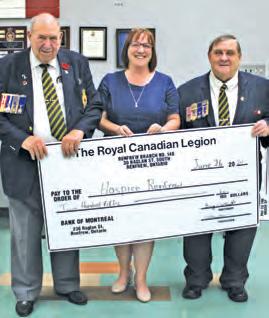
Ron Kilby and President Greg Walbeck of Renfrew, Ont., Branch present $500 to Hospice Renfrew, represented by executive director Marjorie Joly.

Second Vice Rick Kelly, President Tracey Nichol and First Vice Wayne Hamilton of Maj. Andrew McKeever Branch in Listowel, Ont., present $10,000 to Listowel Memorial Arena Park MAP59 project, represented by Kate Tervitt and Gerry Rozendale.

At Eastview Branch in Vanier, Ont., veteran Rolland Lalonde receives a Quilt of Valour. Pictured are Quilts of Valour rep Nancy Arbogast, treasurer Ray Barker, chair Bill Redmond and Rolland’s daughter Carole.
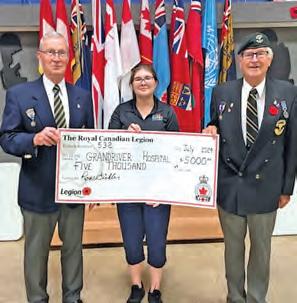
President Ross Eichler and veteran Mike Disney of New Hamburg, Ont., Branch present $5,000 to Grand River Hospital, represented by Ashley Kefalas.
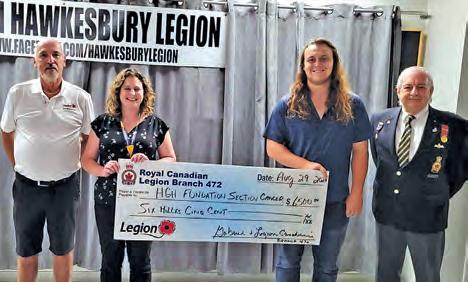
Georges Vanier Branch in Hawkesbury, Ont., contributes $6,500 to Hawkesbury General Hospital for cancer treatment. Pictured are branch member Yvon Doiron, foundation executive director Erin Tabakman, event organizer Gabriel Parent and Branch President Michel Denis.
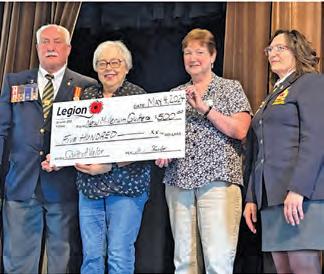
President Glen Hanley and Second Vice Sharon Hope of Paisley, Ont., Branch presents $500 to Karen Schnurr and Johanna Hardy for the Quilts of Valour program at the New Millenium Quilt Guild.

Co-operators, represented by Chad Buell of Chad Buell and Associates Inc., presents $20,000 to Ontario Command Track and Field. Accepting the cheque is Command President Derek Moore. CAROLYN McCAUL
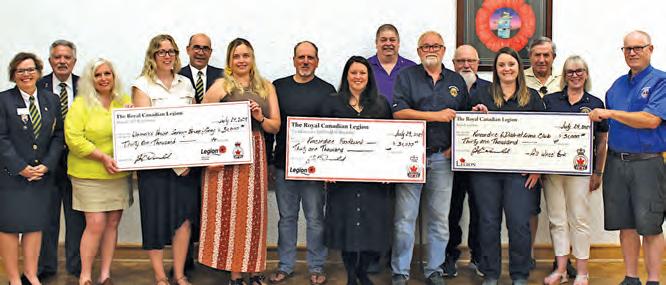
MacDonald Branch in Kincardine, Ont., divided $93,000 between three local community organizations. Branch President Jim McDonald, First Vice Teri Leslie and charity chair Russ Crook (far right) present cheques of $31,000 each to the Women’s House Serving Bruce and Grey, the Kincardine Food Bank and the Kincardine and District Lions Club for their All Wheels Facility Project.
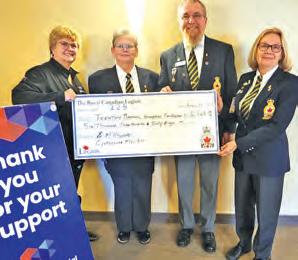
Brendan McGlynn, Joyce Cosbey and treasurer Vicki Bateman of Stirling, Ont., Branch present $6,368 to Trenton Memorial Hospital Foundation, represented by executive director Wendy Warner.
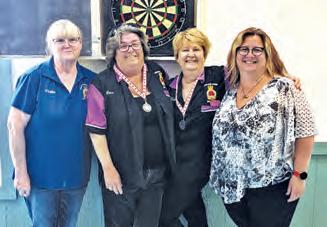
Provinical L.A. Past President Debbie Olmstead and sports chair Kelly Scott congratulate Ann Butterfield and Shirley McMurter of Highland Creek Branch in Scarborough, Ont., for winning the L.A. provincial darts competition.
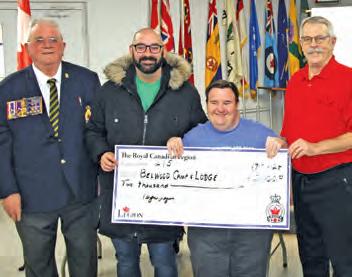
President Brian Bielby and Second Vice Dave Evans of Fergus, Ont., Branch present $2,000 to Belwood Camp and Lodge, represented by councillor James Lortie and camper Michael Patteson.

Harry Miner VC Branch in Clinton, Ont., presents $1,500 to the Clinton Minor Baseball Camp. Pictured are Huron MPP Bruce Ben Lobb, Dawn Riley, Sue Taylor, former Yankees and Blue Jays player Homer Bush, Clinton minor baseball executive Matt Langendoen, Branch President Shirley Chalmers, Don Leyes, Brian Atkinson, Rick Shropshall and Wes Chambers.

Ontario Command, L.A. Provincial President Sharon Crown presents $7,500 to Ontario Command Track and Field Championships for athletes’ uniforms prior to the Legion National Youth Track and Field Championships in Calgary. Accepting the donation is Ontario Command President Derek Moore. CAROLYN McCAUL

Uxbridge, Ont., Branch Vice President Gloria Eng and President Peter Viney present $3,000 to Don Mertens of the Loaves and Fishes Food Bank in Uxbridge.

Elmvale native Dave Drinkill (centre), general manager of the Saginaw Spirit, brings the Canadian Hockey League’s Memorial Cup to the Elmvale, Ont., Branch during its recent hockey skills challenge for local youngsters. Also pictured are Jan Drinkill, Margie Baks, Charlay Porter, Marion Clute and Rick Drinkill.
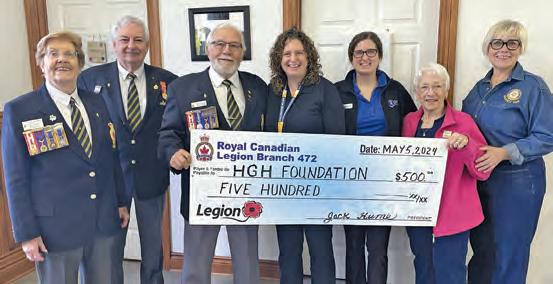
Georges Vanier Branch in Hawkesbury, Ont., presents $500 to the Hawkesbury General Hospital Foundation. Attending are secretary June Elliott, First Vice Michel Denis, President Jack Hume, foundation executive director Erin Tabakman and the hospital’s co-ordinatior of philanthropic projects Ashley Tillotson. Evelyn Bernique and Suzanne Hocquard organized the event.

Atikokan, Ont., Branch hosts Decoration Day for Legion members and members of the Starfighter air cadets squadron.
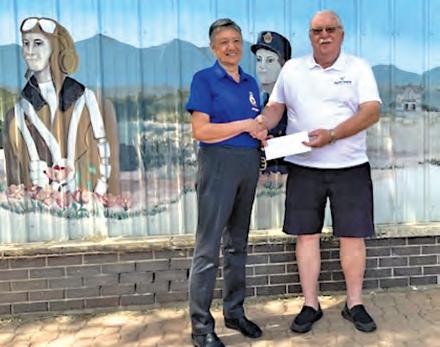
Dauphin, Man., Branch representative Norma Johnson presents $7,100 to Dauphin Hospital Foundation President Greg Thompson for the purchase of a max air surface mattress and a blood pressure machine for use in the palliative care unit.

Onoway, Alta., Branch President Richard
and First Vice
congratulate national primary black and white poster category winner Lily
and national junior colour poster category second-place finisher Bonnie Li at a special assembly at Onoway Elementary School.


President Darlene Burnett (right) and First Vice Linda Cooper of Three Sisters Branch in Canmore, Alta., present a $3,000 bursary to Jackson Godefroy. SHEILA TANNER
President Darlene Burnett (right) and First Vice Linda Cooper of Three Sisters Branch in Canmore, Alta., present a $3,000 bursary to Delanie Nachtigahl. SHEILA TANNER
Moses (right)
Cliff Cottingham
Cretney (left)
JEAN MOSES

Stony Plain, Alta., Branch President Gord Morrison and membership chair Pat Hale (centre, front) welcome new members. Pictured are Mark and Linda John, Todd Rolls, Jim Carswell, Moe Roberts, Warren Dunbar and Reg Chessell. PAT HALE

Branch
Olivia
the

Clarenville, N.L., Branch member Cyril McGettigan presents $4,000 to the Discovery Health Centre Foundation, represented by chief development officer Heather Barbour.


Canning, N.S.,
presents
Felker with
secondplace award in the national senior colour poster contest.
Bob Kanngiesser of Alberni Valley Branch in Port Alberni, B.C., congratulates Kaitlyn Schellenberg on receiving a Legion Memorial Scholarship of $750.
George Pearkes VC Branch in Summerside, P.E.I., presents $1,000 bursaries to Jessica Praught (left), Wyatt Steele, Kali Delaney and Willow Reis.

First Vice George Molnar of Mount Benson Branch in Nanaimo, B.C., presents $1,000 to Steven Davies of the Vancouver Island University Foundation for its Letters and Images project.

Trail, B.C., Branch L.A. representatives present $5,000 to the Kootenay Boundary Regional Hospital’s medical imaging department for a portable ultrasound machine. Pictured are L.A. President Lauranne Sewell, Vice President Elly Venier and foundation board member Melissa Archambault.
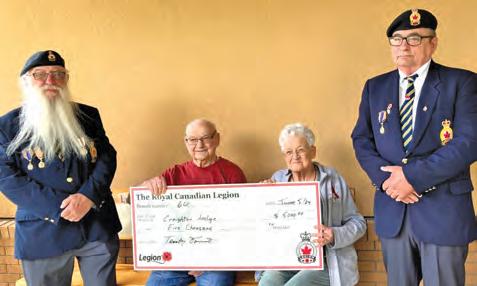
Estevan, Sask., Branch President Frosty Forrest and branch member John Greenhough present $5,000 to Creighton Lodge Seniors Home, represented by residents Ted Fai and Alma McGill.
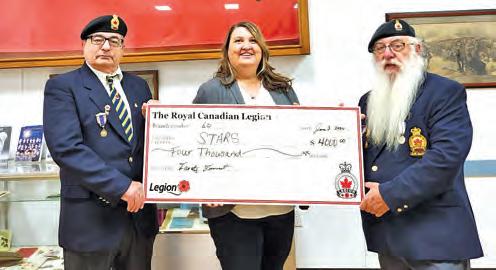
Estevan, Sask., Branch presents $4,000 to Stars Ambulance. Pictured are branch representative John Greenhough, Stars’ representative Kathy Skomar and Branch President Frosty Forrest.

Moose Jaw, Sask., Branch presents $5,000 to 15 Wing Moose Jaw Military Family Resource Centre. Pictured are 15 Wing representatives Lt.-Col. Matthew Fullerton and MWO Jean-Simon Fournier, branch member Sue Knox, MFRC representatives Talia Dequier and Kandice Hebert, and branch member Christine Simpson. CAPTAIN/CAPITAINE JEAN DOYON, CD

Kelliher, Sask., Branch representatives, students of Kelliher School and members of the public place flags on veterans’ graves at Kelliher Memorial Gardens on June 6, 2024. LAUREL RUGLAND
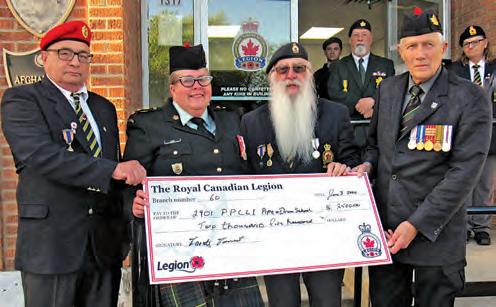
Estevan, Sask., Branch presents $2,500 to 2901 PPCLI Pipe and Drum School. Pictured are branch members John Greenhough and Lieut. Angela Durr, Branch President Frosty Forrest and retired Capt. Robert Rooks.

Kelliher, Sask., Branch President Jack Sweatman watches a Grade 2 student place a flag on a veteran’s grave at the Lutheran cemetery on June 4, 2024. LAUREL RUGLAND
CORRESPONDENTS’ ADDRESSES
Send your photos and news of The Royal Canadian Legion in action in your community to your Command Correspondent. Each branch and ladies auxiliary is entitled to two photos in an issue. Any additional items will be published as news only. Material should be sent as soon as possible after an event. We do not accept material that will be more than a year old when published, or photos that are out of focus or lack contrast. The Command Correspondents are:
BRITISH COLUMBIA/YUKON: Graham Fox, 4199 Steede Ave., Port Alberni, BC V9Y 8B6, gra.fox@icloud.com
ALBERTA–NORTHWEST TERRITORIES: Donna Ganzon, 2020 – 15 Street NW Calgary, AB T2M 3N8, abnwtlegion.com
SASKATCHEWAN: Tara Brown, 2267 Albert St., Regina, SK S4P 2V5, admin@sasklegion.ca
MANITOBA: George Romick, 320 Admiral Court, Thunder Bay, ON P7A 8B5, romickg@tbaytel.net
NORTHWESTERN ONTARIO: George Romick, 320 Admiral Court, Thunder Bay, ON P7A 8B5, romickg@tbaytel.net
ONTARIO: Roy Eaton, 567-294B North Channel Dr., Little Current, ON P0P 1K0, reaton@on.legion.ca
QUEBEC: Mary-Ann Latimer, 105-2727 rue St. Patrick, Montreal, QC H3K 0A8, msmarts@bell.net
NEW BRUNSWICK: Harold Wright, 2-299 Main St., Saint John, NB E2K 1J1, foulis20@gmail.com
NOVA SCOTIA/NUNAVUT: James Leadbeater, 4129 New Waterford Highway, New Victoria, NS B1H 5T4, james.leadbeater@hotmail.com
PRINCE EDWARD ISLAND: John Yeo, 657 Rte. 19, Meadow Bank, PE C0E 1H1, islander657@yahoo.ca
NEWFOUNDLAND AND LABRADOR: Brenda Slaney, Box 5745, St. John’s, NL A1C 5X3, bslaney@nfld.net
DOMINION COMMAND ZONES: EASTERN U.S. ZONE, Gord Bennett, 803-190 Cedar St., Cambridge, ON N1S 1W5, Captglbcd@aol.com; WESTERN U.S. ZONE, Douglas Lock, 1531 11th St., Manhattan Beach, CA 90266, douglock@fastmail.com
Submissions for the Honours and Awards page (Palm Leaf, MSM, MSA and Life Membership) should be sent directly to Michael A. Smith, Legion Magazine, 86 Aird Place, Kanata, ON K2L 0A1 or magazine@legion.ca.
TECHNICAL SPECS FOR PHOTO SUBMISSIONS
DIGITAL PHOTOS—Photos submitted to Command Correspondents electronically must have a minimum width of 1,350 pixels, or 4.5 inches. Final resolution must be 300 dots per inch or greater. As a rough guideline, colour JPEGs would be between 0.5 megabytes (MB) and 1 MB.
PHOTO PRINTS—Glossy prints from a photofinishing lab are best because they do not contain the dot pattern that some printers produce. If possible, please submit digital photos electronically.
FRENCH INSERT—To receive a French insert of Legion Magazine content, please contact MagazineSubscriptions@legion.ca or call 613-591-3335.
LONG SERVICE AWARDS
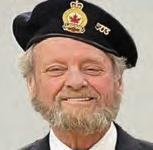


50 years
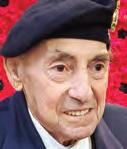

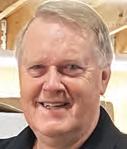


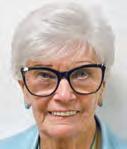


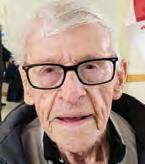
LIFE MEMBER AWARDS
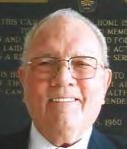


MARKETPLACE





PALM LEAF

ONTARIO
HARRY MUSSELL
H.T. Church Br., St. Catharines
LINDA HAUTALA
Milton Wesley Br., Newmarket
NOVA SCOTIA
MARIANNE ILLSLEY
Middleton Br.
DOUGLAS MOORE Middleton Br.
LOST TRAILS
CANADIAN NAVAL AIR GROUP ARTIFACTS—Looking for anyone who was involved with the Royal Canadian Navy Naval Air Branch between 1957–1970. Were aboard HMCS Warrior, HMCS Magnificent, HMCS Bonaventure with logbooks, pictures, memorabilia, etc. Contact Stephen Porrior, 617 -110 Rossignol Dr., Orleans, ON K4C ON2, 613-700-7843. seafury1@gmail
CANADIAN ARMY AVIATION ARTIFACTS —Any former Legion member or relatives who served within the Canadian Army Aviation during the Second World War or in the 1960s with logbooks, pictures, memorabilia, movies, etc., contact John Heitshu. jcheitshu@hotmail.com canadianarmyaviation.com.
DAN BESSIER Onaping Falls Br., Ont. JULIAN LAUTENSCHLAGER New Hamburg Br., Ont.
BARRY YOUNG Dawson Creek Br., B.C.
ELMER AULD Port Arthur Br., Thunder Bay, Ont.
LEROY GAMBLE George Pearkes VC Br., Summerside, P.E.I.
VICTOR SEARS Calais Br., Lower Sackville, N.S.
BETTY ANN POLLOCK Kanata Br., Ont.
STAN HOWIE Polish Veterans Br., Kitchener, Ont.
GLADYS MILLER Kanata Br. L.A., Ont.
LOUIS LAPRADE JR. Trenton Br., Ont.
HUGH DODDS Dawson Creek Br., B.C.
PATRICIA BOYD Shelburne Br., Ont.
JOEY REYNOLDS Penetanguishene Br., Ont.
DONALD BOYD Shelburne Br., Ont.
KEN KOWALCHUK Polish Combatants Br., Thunder Bay, Ont.
ROBERT (JIM) WOODWARD Kansack Br., Sask.
Make the most of your Legion Membership
As a Legion Member, you take pride in the fact that your membership helps support and honour Canada’s Veterans.
Did you know that it comes with benefits you can use, too? Take advantage of all the benefits that come FREE with your membership.

Renew your membership to get all these benefits and more!
MemberPerks® unlocks $1000s in potential savings on offers and deals at stores and restaurants across Canada, including national chains, local businesses and online stores. Use the MemberPerks® app, print out coupons or shop online to save on electronics, travel, fashion, entertainment and so much more!
Your membership also gives you access to additional benefits, including:
• savings and deals from our Membership Partners
• a paid subscription to Legion Magazine
• exclusive members-only items at PoppyStore.ca

J.L. Granatstein
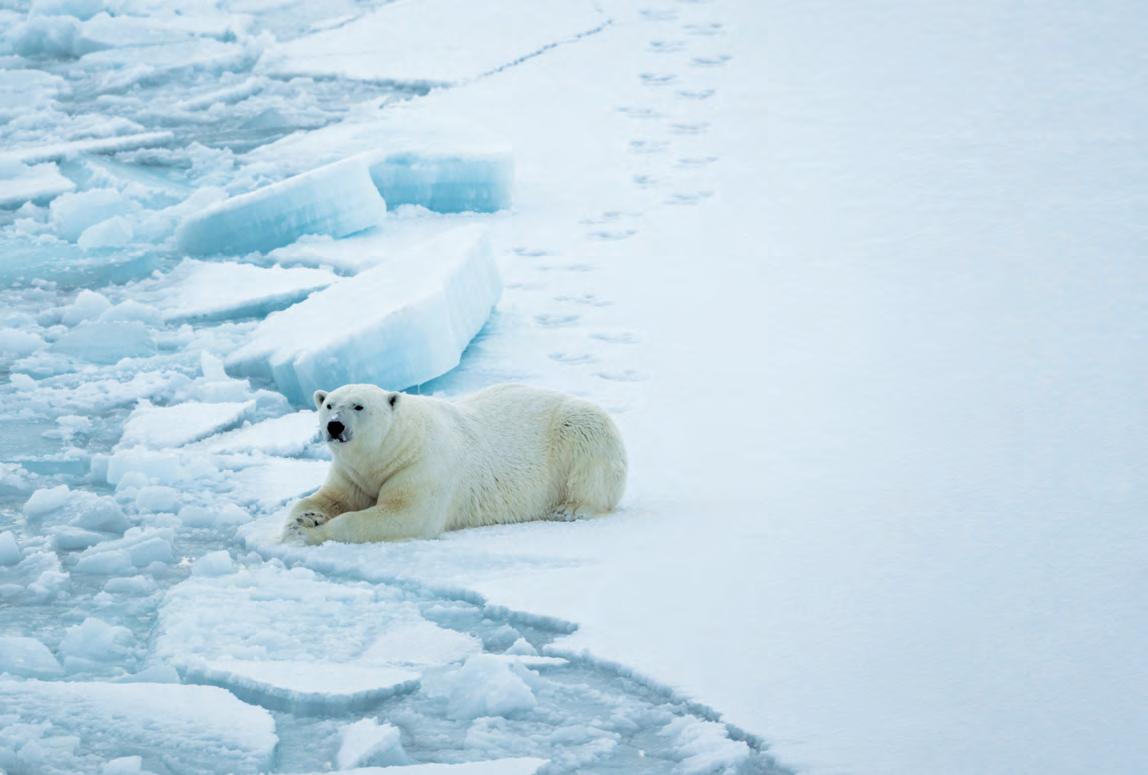
Polar
play
As Russia, China and the U.S. increase their Arctic presences, is Canada ready to defend its North?
Most Canadians know that climate change is warming the Arctic. What they may not understand, however, is that the rate of warming in the North Pole region is four times the global average. What most assuredly don’t know is that as the ice melts during the next 25 years or so, the Arctic Ocean will likely become the most efficient shipping route between East Asia and Europe.
are proposing to make their country a “polar great power,” as leader Xi Jinping put it, building icebreakers, mapping the polar seabed and searching for minerals and energy sources. The Russians, even while at war with Ukraine, have stationed weapons, naval vessels, aircraft, missiles and thousands of troops in Arctic bases.
HMCS Margaret Brooke encounters a polar bear in Davis Strait during ice trials in March 2022.
Also consider: the portion of the Arctic Ocean outside claimed territorial waters and economic exclusion zones—the socalled 200 nautical mile limit—is equal in size to the Mediterranean Sea; the Arctic Ocean is estimated to hold 30 per cent of the world’s remaining natural gas deposits and 13 per cent of its oil reserves; China views the central Arctic Ocean as a global commons, open to any country to exploit; and lastly, 2.5 million Russians live in the Arctic, while just some 150,000 Canadians do.
Coincidentally, both Russia and China are arming and preparing to drill, mine and fish in the Arctic Ocean. The Chinese
Meanwhile, the U.S. has 22,000 military personnel in Alaska and its 2022 Arctic strategy promised “The United States will enhance and exercise both our military and civilian capabilities in the Arctic as required to deter threats.”
And in Canada? Retired lieutenantgeneral Andrew Leslie, a member of Parliament from 2015-2019 in Justin Trudeau’s government and a former chief of the land staff, told the National Post this past May that the Canadian Armed Forces have just 300 people permanently based in the Arctic.
Still, Canada has plans. Its April 2024 defence update, “Our North, Strong and Free,” detailed what has been done and what’s planned to defend the North.
The navy has put to sea four of six new Arctic offshore patrol ships and the government pledged $38.6 billion to upgrade the North American Aerospace Defense infrastructure across the Arctic. The defence update also promised Canada will establish presence, reach, mobility and responsiveness for the CAF in the Arctic with northern operational resource hubs, airborne early warning aircraft, underwater sensors on the coasts and undersea, icebreakers, a satellite ground station in the Arctic, and new helicopters. This past July, the government also announced it was formally launching a process to acquire up to 12 submarines with under-ice capabilities. And the possibility of improved air and missile defence and long-range ground-, air-, and sea-based missiles is to be explored.
It sounds impressive, but regrettably, it is not. First, the Arctic patrol ships are lightly armed, capable of sailing in the Arctic only in the summer, and have limited ice-breaking capacities. The money pledged to upgrade Norad is to be spent over 20 years, and everything else is promised for the future without funding attached to it. And it all comes at a time when Defence Minister Bill Blair publicly declared that the CAF are in a “death spiral” for want of personnel.
To be clear; Canada isn’t going to be able to match Russian, and future Chinese, strength in the Arctic. But, the prospect of a Russian land invasion of the Canadian North is also unlikely. Three-quarters of a century ago, Foreign Minister Lester B. Pearson said that Canada’s defence policy in the North was one of “scorched ice.” Fifteen years ago, the defence chief General Walter Natynczyk was asked what Canada would do if the Arctic was invaded. His reply? “The first task would be to rescue” the attackers. He might have added that at the time Canada had no resources capable of such a task. It still doesn’t.
Simply put, -50 C temperatures, huge distances, and the absence of strategic objectives defend the Arctic. There are no deep-water harbours on Canada’s Arctic coast—although one at Nanisivik on northern Baffin Island has been in the works for 15 years, but remains incomplete and
over budget, few roads, no rail connections, and essentially nowhere to go and little to capture. There’s no point in a land invasion. What this means is that any attack would be by aircraft and missiles, striking at any future bases followed by political and diplomatic initiatives. The objectives would be to secure control of shipping lanes and gain unhindered access to exploit natural resources in the central Arctic Ocean and, possibly, on Canada’s continental shelf.
IT SOUNDS IMPRESSIVE, BUT REGRETTABLY, IT IS NOT.
Today, Canada has no defence against such an incursion beyond the paper promises of the 2024 defence update. Even if those pledges are enacted by future governments, it will be years and billions of dollars before adequate defences are in place.
At present, the Arctic Council, which brings all the Arctic countries together (as well as 38 observer nations, including China), relies on the peaceful “exceptionalism” of the area. The council tries to keep the region a non-confrontation zone, limits commercial ocean traffic and controls resource exploitation. There has been some success, but the new tensions between the West and the RussiaChina axis have had a significant impact.
Clearly NATO’s Arctic members—the U.S., Canada, the Nordic countries—need to develop a common strategy. They need the ability to monitor oil and gas exploration and development, control fishing in waters near their coasts (China consumes far more fish than any other nation), have icebreakers and shared underwater monitoring and detection systems.
Leslie told the Post that Britain and the U.S. have offered to help Canada in the Arctic, and the commander of Norad has stated he will run exercises in Canada. Regardless, Leslie said “the Liberal government…rest confident in the smug knowledge that the Americans will always defend us.”
Unfortunately, he’s probably right. And that’s no policy for a sovereign country. L
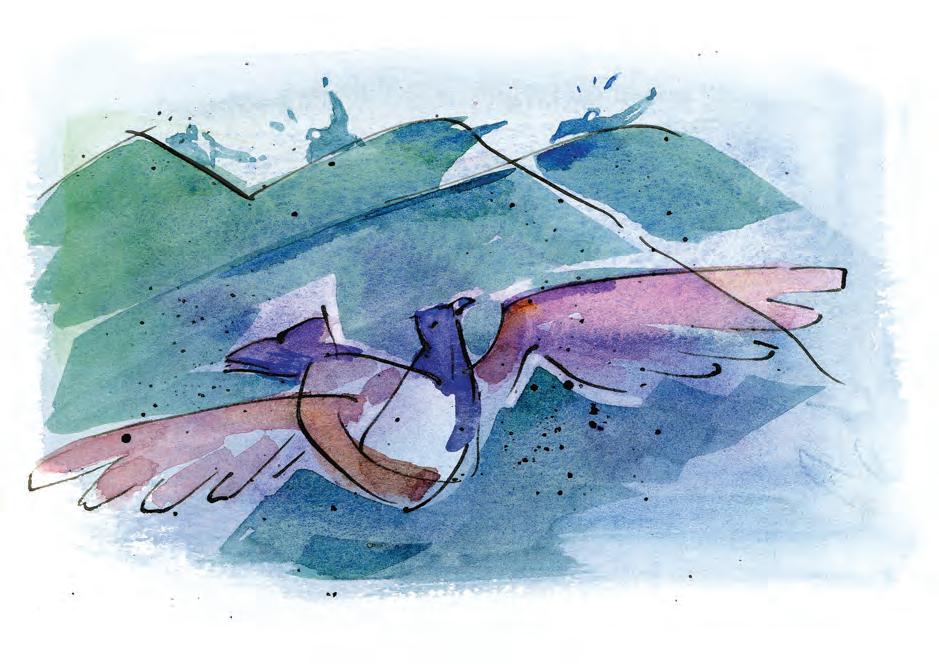
Winged commander
Amazingly, during the early years of the Second World War, Royal Air Force bombers were equipped with carrier pigeons. They were supposed to be the last resort if radio communications were lost.
In 1942, one of these birds actually helped rescue a downed crew member.
The pigeon, named Winkie, was aboard a badly damaged bomber returning from a mission to Norway. The plane went down in the North Sea. The crew sent a message that they were ditching, but didn’t send a position. As they bobbed in the frigid water they released Winkie.
Winkie made it home to her Dundee, Scotland, coop, oil-stained and exhausted after a 200-kilometre flight and her owner notified the local air base. Navigators plotted the time of the ditching and calculated the distance the bird could have flown. The lost aviators were retrieved. The pigeon was awarded the Dickin Medal, which is given to animals for bravery or devotion to duty in combat.
Last fall, a bronze statue of Winkie was unveiled in Dundee.
In 1944, a young Canadian officer had just taken command of a motor torpedo boat and was heading for Greenock, Scotland, on the River Clyde to pick up supplies. All the while, he was looking for a potential target to practise on. What did he see coming down the river but the liner Queen Mary, all 80,000 tons of it. He couldn’t resist and
> Do you have a funny and true tale from Canada’s military culture?
Send your story to magazine@legion.ca
rang up for full speed. But as he closed in on the troopship, he noticed men on its bridge aiming rifles at him. He decided in favour of discretion and sheered away.
An investigation was launched and in due course he was marched before a senior admiral. “I described what had happened, explaining that it had all been quite harmless,” he recalled years later.
When the questioning was done, the admiral dismissed his staff and the Queen Mary officers. He gestured to the Canadian to take a seat and offered him a cigarette.
“Really,” he said. “That was a bit naughty, wasn’t it?
“But in a way I really can’t blame you. She must have been an irresistible target. You’ll hear no more about it.”
And that was it. The two men chatted for a while and the admiral wished the young man good luck before parting.
The skipper survived the war and went on to greater fame back home in Canada. His name was Jack McClelland, and he eventually ran McClelland & Stewart, the publishing house that helped promote Canadian literature and the careers of authors such as Margaret Atwood, Pierre Berton and Farley Mowat.
In the spring of 1945, when the Second World War had only weeks to run, HMCS New Glasgow left Londonderry to join a convoy off the coast of Scotland. It was to be its final escort assignment before returning to Canada for a refit and a long-awaited home leave. The frigate was steaming in bright moonlight and calm seas in company with three other ships.
Without warning, the ship lurched upward and to starboard, accompanied by a grating, grinding noise. “We’ve run aground,” the astonished navigator shouted from the bridge, as thoughts of court martial popped into his head. The captain suggested they had hit an uncharted rock.
What they had struck was a German submarine, U-1003, which had been submerged and running on its snorkel. The impact damaged the sub badly and it lay on the bottom in 80 metres of water for two days, while the crew struggled to make repairs. In the end, the captain ordered the vessel to surface and the crew abandoned ship.
New Glasgow had some nasty hull gashes and a mangled propeller. After first aid at Londonderry, she was ordered to Rosyth, on the other side of Scotland, for a refit and was still in drydock when the war ended.
As far as we can tell, this was the only case during the war of two belligerent warships colliding accidentally.
“WE’VE RUN AGROUND,” THE ASTONISHED NAVIGATOR SHOUTED FROM THE BRIDGE, AS THOUGHTS OF COURT MARTIAL POPPED INTO HIS HEAD
Canadian-born actress Mary Pickford decided to help Canada’s war effort in the early 1940s by offering to raffle off one of her handbags to raise money to buy sports gear for the troops. Her gesture sadly ran afoul of a Toronto city bylaw, which capped the value of raffle items at $50. Pickford’s bejeweled purse was worth $1,500. An exception was sought. L
Illustration by Malcolm Jones
HEROES AND VILLAINS
By Mark Zuehlke

Eisenhower’s leadership during the Battle of the Bulge surpassed Adolph Hitler’s
& DWIGHT D. EISENHOWER
OnDec. 16, 1944, General Dwight D. Eisenhower, supreme commander of Allied forces in Europe, greeted General Omar Bradley at his headquarters. Soon after, they learned a strong German counterattack had struck U.S. lines in the Ardennes earlier that morning.

THE
AMERICAN COUNTERATTACK HIT THE GERMANS HARD ON DEC. 22 AND EISENHOWER RALLIED THE TROOPS.
While Bradley was dismissive, Eisenhower quickly realized the Germans had launched the desperate gamble he had previously warned his chief of staff, Lieutenant General Walter Bedell Smith, might happen. Nowhere along the length of the Allied front were his troops so thinly deployed—a calculated risk that the snow-choked forested region posed too great a limitation to armoured operations.
General George S. Patton was equally unperturbed, promising that within three days he could attack from the Saar region and squeeze the sides of the German salient from the north and south. Knowing he was to be appointed a five-star general the next day, Eisenhower joked to Patton: “George, every time I get promoted, I get attacked.”
“Yes,” Patton wryly responded, “and every time you get attacked, I bail you out.”
The American counterattack hit the Germans hard on Dec. 22 and Eisenhower rallied the troops.
“The enemy is making his supreme effort,” said Eisenhower. “He is gambling everything, but already, in this battle, your gallantry has done much to foil his plans.
“We will with God’s help, go forward to our greatest victory.”
—General Dwight D. Eisenhower
As reports came in that three German armies were chewing their way through already depleted or inexperienced American divisions, Eisenhower acted decisively. By nightfall, reinforcements were on the way. Despite a juggernaut of about 250,000 Germans pouring into his lines, Ike saw opportunity rather than peril.
“The present situation is to be regarded as one of opportunity for us and not of disaster…. There will only be cheerful faces at this conference table,” he admonished his officers.
“By rushing out from his fixed defenses, the enemy may have given us the chance to turn his great gamble into his worst defeat… I call upon every man…to rise…to new heights of courage, of resolution and of effort. Let everyone hold before him a single thought— to destroy the enemy on the ground, in the air, everywhere—destroy him…. We will with God’s help, go forward to our greatest victory.”
On Jan. 16, a month since it started, the Battle of the Bulge was won. But some 100,000 U.S. soldiers were either dead, wounded, captured or missing—nearly one out of every 10 American casualties of the entire war. L
&ADOLPH HITLER

The decision to launch the all-ornothing Ardennes Offensive was entirely the German Führer’s and was made on Sept. 16, 1944. While describing the gloomy situation the Germans faced on the Western Front—some 55 divisions facing 96 Allied ones—his chief of operations Generaloberst Alfred Jodl offhandedly noted that in the Ardennes a 130-kilometre front was held by just four U.S. divisions.
Luftwaffe General Werner Kreipe, representing Reicshsmarschall Hermann Göring, confided in a secret diary that Hitler had dramatically raised a hand. “The Führer interrupts Jodl,” he wrote. “He had resolved to mount a counterattack from the Ardennes, with Antwerp as the target.”
Hitler declared he would unleash a juggernaut of divisions that would split the British and American armies at their seam. Then there would be “a new Dunkirk!” Kreipe’s excitement was palpable as he noted that a reinvigorated Hitler swore the senior officers to secrecy “on pain of death.”
While Hitler’s immediate aim was to seize Antwerp—the main port through which Allied supplies flowed—his overarching vision was to so maul the western Allies that no advance into Germany would be possible for months. During that time, he could shift divisions to stalemate the Soviets in the east. A negotiated peace, rather than

the unconditional German surrender the Allies demanded, would then be possible.
Hitler personally put a massive deception plan, translated as “The Defensive Battle in the West,” into motion. In the Rheydt-Jülich-Cologne region east of Aachen, forces were paraded to indicate preparations for a counteroffensive.
Meanwhile, with incredible secrecy, those tasked with the true Ardennes offensive were assembled in a valley and plateau region cloaked in thick forests. Such was the success of the deception and the secret true concentration that Allied intelligence completely missed the gathering storm about to descend upon the Ardennes.
A REINVIGORATED HITLER SWORE THE SENIOR OFFICERS TO SECRECY “ON PAIN OF DEATH.”
On the night of Dec. 15, the commanders of 5th and 6th panzer armies issued a watchword command dictated directly by Hitler: “Forward to and over the Meuse!” This was the river where the Allied defensive line guarding Antwerp was anchored. Although total surprise was achieved, the Germans were soon contained, then sent into retreat. German casualties were devastating: between 80,00090,000-plus; some 12,500 died.
Hitler’s gamble ultimately only hastened Germany’s defeat. L
“Forward
to and over the Meuse!” Adolf Hitler
By Alex Bowers
Mars attacks!
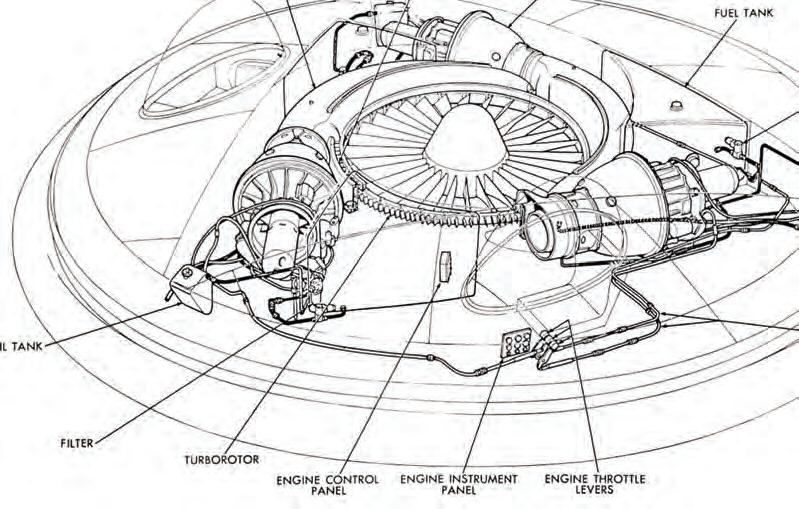
While it struggled to get off the ground, Canada’s flying saucerlike Avrocar is still a key part of the maturation of its modern air force
Atabout 11:00 a.m. on Feb. 20, 1959, Prime Minister John Diefenbaker stood in the House of Commons and, largely unexpectedly, announced the termination of the Avro Canada CF-105 Arrow project. What followed was the virtual disintegration of Canada’s aviation industry at a pivotal time in airborne innovation.
The Arrow’s fate, meanwhile, was almost shared by another, albeit stranger, company initiative: the Avrocar.
Originally part of efforts to develop a supersonic VTOL (vertical take-off and landing) fighterbomber, the invention had seldom met expectations. After the Arrow’s demise and with Avro Canada gutted

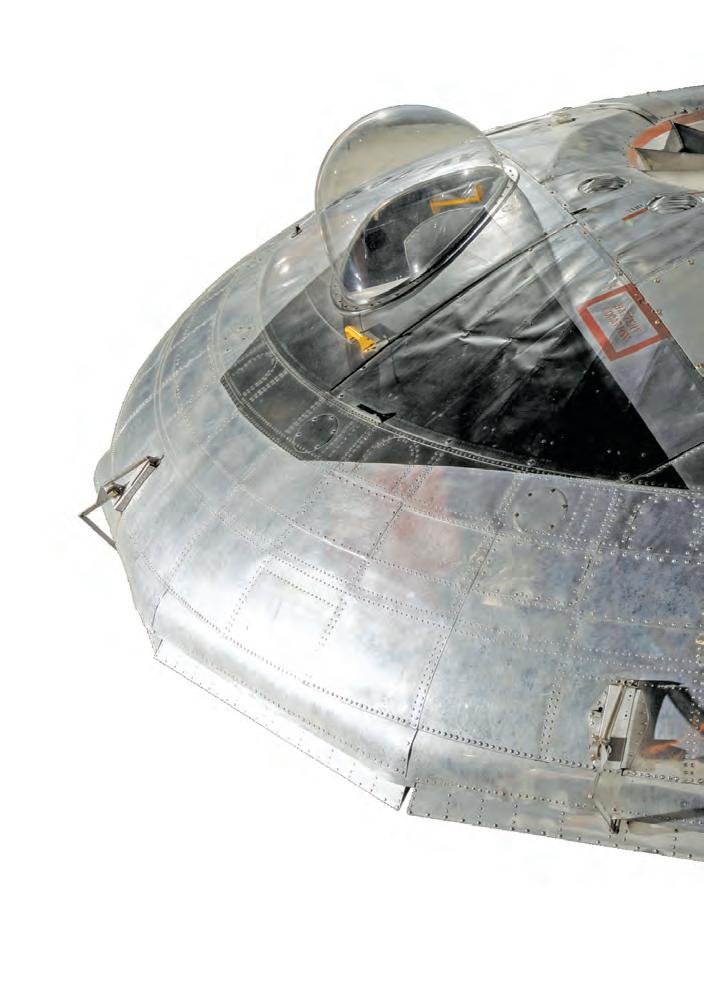


by widespread redundancies, the pressure was on to transform such a curious creation—easily mistaken for a 1950s sci-fi flying saucer— into a state-of-the-art, lethally efficient engineering miracle.
The issue was that the Avrocar had long struggled to take off—literally and figuratively— with no breakthrough in sight.
“Disc-shaped aircraft were built by the Germans as early as

1933,” explained Jason Eldridge, the Avro Museum’s collections manager and treasurer. “At the end of the Second World War, the United States made efforts to secure relevant intelligence that could be of considerable value to the Allies.”
This idea, along with postwar advances in aircraft technology, drove A.V. Roe (Avro) Aircraft (later Avro Canada) expert John (Jack) Frost to assemble a special projects group in 1952.
Allocated $400,000 in government funding, the elite team of scientists and engineers began drawing plans for a high-altitude, circular-winged aircraft based on relatively new, if yet-to-bemastered, aerodynamic principles.
BY THE NUMBERS
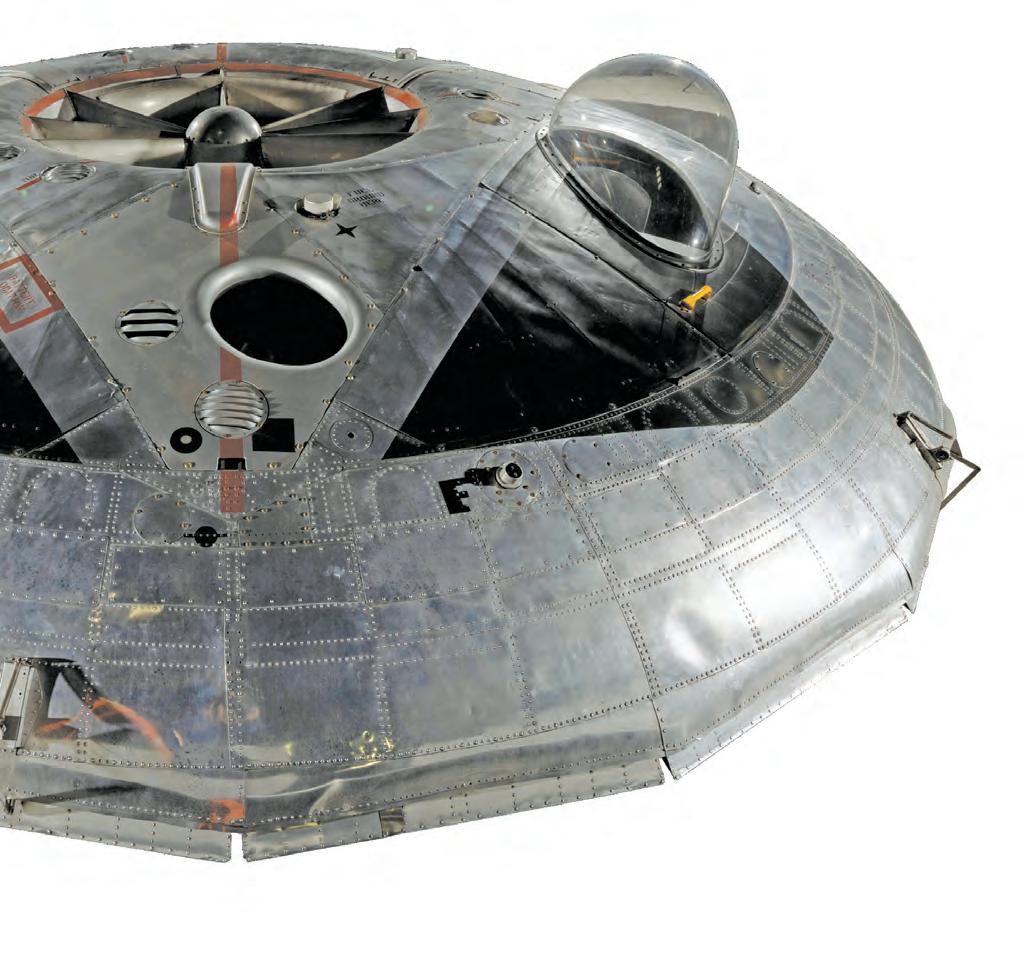
From tech specs to test models, the 1950s-era Avro Canada Avrocar was part of an initiative to develop a vertical take-off and landing fighter bomber.


“In reality, the Avrocar was probably never going to become the final realization of its ideas.”

hovercraft,” said Eldridge. “Air would be vectored to raise and propel it in the desired direction, utilizing three Continental J69-T9 engines to turn a central turborotor.”
Despite additional financial support—perhaps most crucially from the United States Air Force— years’ worth of studies failed to the meet lofty aspirations. Development halted until 1958, when American military authorities took a renewed interest.
The latest in cross-border co-operation helped produce two prototype vehicles with somewhat more modest performance expectations. One remained in Canada; the other was shipped to the U.S.
The VZ-9AV Avrocar, as it was then named, was born.
But its woes were far from over.
William McLaughlin, curator of the National Museum of the
5.5
Approximate wingspan in metres
482
Projected speed in km/h
10
Approximate number of years before the project was cancelled

state [oscillation around the airframe’s pitch and roll axis].
“There were also issues with symmetry, an unanticipated lack of thrust generation, and inadequate low-speed control. In reality, the Avrocar was probably never going to become the final realization of its ideas.”
Ultimately, no amount of adjustments could prevent the two-man flying saucer-esque aircraft from meeting its demise. The project was cancelled in 1961.
United States Air Force, noted just some of its many shortcomings:
“The Avrocar could generate lift for it to climb a few feet off the ground, but it often became uncontrollable during flight. Test engineers characterized it as entering an unrecoverable ‘hubcapping’
Still, says McLaughlin: “The Avrocar is one testbed of a nascent idea that matured into a key attribute of the most advanced aircraft in service. You might have to squint to see, but it has a place within the maturation of today’s air force.” L
O CANADA

By Don Gillmor
B MAPLE LEAF


ehold Canada’s flag, its bold simplicity. The flag the country waved at the Summit Series in 1972, that it waves at the Olympics, that flies above thousands of Canadian cottages. Flags are a symbol that unite a nation, but choosing the present version 60 years ago caused an uproar.
At the time, Canada used either Britain’s Union Jack, or occasionally, the Red Ensign, a modified version of the flag of the British Merchant Navy.
The idea of Canada having its own flag was first floated in 1925, by Prime Minister Mackenzie King, but the pushback was so great he abandoned the idea. He tried again in 1945, without success. The country wasn’t yet ready to shrug off its colonial emblem.

the leader of the opposition, insisted that the Union Jack be part of the new ver sion, to acknowledge the country’s British heritage. The design discussion was opened to the public and almost 6,000 alternate concepts—maple leaves, beavers, stars and echoes of the Union Jack among them—were ultimately considered.
Meanwhile, there were also Canadians who felt the country didn’t need a new flag, and that the issue was dividing a country that was already divided by language and geography. There was apathy, too; Quebec had little interest in the flag debate. “Quebec does not give a tinker’s damn about the new flag,” said MP Pierre Trudeau.
Prime Minister Lester B. Pearson unveils the winning design for Canada’s new flag in December 1964 (above and bottom left). Thousands of options were considered.
used the Parliamentary rule of closure to get his flag.
Pearson had hoped a new flag would promote unity, that Canada’s national emblem would be less Britain-centric, more inclusive. “If this is his idea of unity,” said an editorial in Vancouver’s The Province, “it is doubtful whether the country can swallow much more of it.”

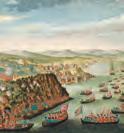




In 1963, weeks after he was elected prime minister, Lester Pearson took a third shot at the idea. The country was almost a century old and was still using a flag borrowed from another nation. Surely, Pearson argued, Canada should have its own. His preference was for three maple leaves. John Diefenbaker, Pearson’s predecessor as PM and then
Pearson’s hope for three maple leaves eventually gave way to the current single red maple leaf with its eleven points, flanked by two solid red bars, a design proposed by historian George Stanley. Diefenbaker complained that it looked like the Peruvian flag (it does).
The parliamentary debate over the new flag lasted 37 days. The Conservatives made 210 speeches (against it), the Liberals 50, the NDP 24, Social Credit 15, and the Créditistes nine. It was after midnight, Dec. 15, 1964, when the matter was finally settled after Pearson
Diefenbaker agreed. “You have done more to divide the country than any other prime minister,” he raged. When he died 15 years later, his coffin was draped with both the new flag and the Red Ensign.
But generations of Canadians have since grown up with the Maple Leaf. It has represented the country well. Simple, recognizable. It was what Donovan Bailey paraded after he won gold in the 100 metres at the 1996 Summer Olympics, what our athletes drape themselves in at global competitions. It grew on the nation. O Canada. L





